



“It is not accidental that at a point in history when hierarchical power and manipulation have reached their most threatening proportions, the very concepts of hierarchy, power and manipulation come into question. The challenge to these concepts comes from a redsicovery of the importance of spontaneity – a rediscovery nourished by ecology, by a heightened conception of self-development, and by a new understanding of the revolutionary process in society.” Murray Bookchin. Post-scarcity and Anarchism (1968).
The rise of neo-liberalism as a hegemonic mode of discourse, infiltrates every aspect of our social lives. Its exponential growth has been helped by gate-keepers of top-down orientated alliances; holding key positions of power and considerable wealth and influence. Educational, collective and social institutions have been dismantled, especially community groups and organisations sharing values associated with social needs in the public realm. [1] Bourdieu.
In this networked society, there are controversies and battles taking place all of the time. Battles between corporations, nation states and those who wish to preserve and expand their individual and collective freedoms. Hacktivist Artists work with technology to explore how to develop their critical and imaginative practice in ways that exist beyond traditional frameworks of art establishment and its traditions. This article highlights a small selection of artists and collaborative groups, whose work is linked by an imaginative use of technology in order to critique and intervene into the opressive effects of political and social borders.
In June 2000, Richard Stallman [2] when visiting Korea, illustrated the meaning of the word ‘Hacker’ in a fun way. When at lunch with some GNU [3] fans a waitress placed 6 chopsticks in front of him. Of course he knew they were meant for three people but he found it amusing to find another way to use them. Stallman managed to use three in his right hand and then successfully pick up a piece of food placing it into in his mouth.
“It didn’t become easy—for practical purposes, using two chopsticks is completely superior. But precisely because using three in one hand is hard and ordinarily never thought of, it has “hack value”, as my lunch companions immediately recognized. Playfully doing something difficult, whether useful or not, that is hacking.” [4] Stallman
The word ‘hacker’ has been loosely appropriated and compressed for the sound-bite language of film, tv and newspapers. These commercial outlets hungry for sensational stories have misrepresented hacker culture creating mythic heroes and anti-heroes in order to amaze and shock an unaware, mediated public. Yet, at the same time hackers or ‘crackers’ have exploited this mythology to get their own agendas across. Before these more confusing times, hacking was considered a less dramatic activity. In the 60s and 70s the hacker realm was dominated by computer nerds, professional programmers and hobbyists.
In contrast to what was considered as negative stereotypes of hackers in the media. Steven Levy [5], in 1984 published Hackers: Heroes of the Computer Revolution [6]. In three parts, he writes about the canonical AI hackers of MIT, the hardware hackers who invented the personal computer industry in Silicon Valley, and the third-generation game hackers in the early 1980s. Yet, in this publication, what has had the most impact on hacker culture and is still used widely as a guideline by many is the ‘hacker ethic’. He identified this Hacker Ethic to be a code of practice consisting of key points such as that “all information is free”, and that this information should be used to “change life for the better”.
1. Access to computers—and anything which might teach you something about the way the world works—should be unlimited and total. Always yield to the Hands-on Imperative!
2. All information should be free.
3. Mistrust authority—promote decentralization.
4. Hackers should be judged by their hacking, not bogus criteria such as degrees, age, race or position.
5. You can create art and beauty on a computer.
6. Computers can change your life for the better.
Levy’s hacker ethic promotes the idea of performing a duty for the common good, an analogy to a modern day ‘Robin Hood'[ibid]. Proposing the concept that hackers are self-reliant whilst embracing a ‘healthy’ anti-authoritarian stance, combined with free and critical thinking. Proposing that hackers should be judged by their ability to hack, and presenting hacking as an art-form. Levy also says that the Free and open source software (FOSS) movement is the descendant of the hacker ethic. However, Levy’s hacker ethic has often been quoted out of context and misunderstood as to refer to hacking as ‘breaking’ into computers. This specifically prescribed role, denies the wider and creative context of what hacking is and could be. It does not have to be just about computer security.
This leads us to ‘crackers’. All crackers hack and all hackers hack. But, crackers are seen as second rate wannabe hackers by the older generation of hackers. The Black Hat Hacker or cracker designs and releases malicious code, gathers dangerous information and brings down sensative systems. The White Hat Hacker hunts down and destroys malicious code, and the casual hacker who hacks in order to learn information for his or her own curiosity; both generally dislike ‘Black Hats’ and ‘Crackers’, and tend to view them as computer criminals and dysfunctional juveniles. Lately, crackers have also been labeled as ‘script kiddies’. As a kind of snobbish insult, it refers to those who are not capable of building or programming their own tools, but tend to use scripts and programs written by others to perform their intrusions. To add to the confusion we also have the term ‘Grey hat’. Which refers to a hacker acting between black hat and white hat. Indeed, this could demonstrate where art hacktivists reside, challenging the trappings of the traditional concept of goody and baddy.
“There is another group of people who loudly call themselves hackers, but aren’t. These are people (mainly adolescent males) who get a kick out of breaking into computers and phreaking the phone system. Real hackers call these people ‘crackers’ and want nothing to do with them.” [7] Raymond.
“The basic difference is this: hackers build things, crackers break them.” [ibid] Raymond.
But before we judge,
let’s view a snippet of the \/\The Conscience of a Hacker/\/ by +++The Mentor+++
Written on January 8, 1986.[8]
“This is our world now… the world of the electron and the switch, the
beauty of the baud. We make use of a service already existing without paying
for what could be dirt-cheap if it wasn’t run by profiteering gluttons, and
you call us criminals. We explore… and you call us criminals. We seek
after knowledge… and you call us criminals. We exist without skin color,
without nationality, without religious bias… and you call us criminals.
You build atomic bombs, you wage wars, you murder, cheat, and lie to us
and try to make us believe it’s for our own good, yet we’re the criminals.”
The term ‘Hacktivism’ was officially coined by techno-culture writer Jason Sack in a piece about media artist Shu Lea Cheang published in InfoNation in 1995. Yet, the Cult of the Dead Cow [9] are also acknowledged as defining the term. The Cult of the Dead Cow are a group of hackers and artists. They say the Hacktivism phrase was originally intended to refer to the development and use of technology to foster human rights and the open exchange of information.
Hacktivism techniques include DoS attacks, website defacement, information theft, and virtual sabotage. Famous examples of hacktivism include the recent knocking out of the PlayStation Network, various assistances to countries participating in the Arab Spring, such as attacks on Tunisian and Egyptian government websites, and attacks on Mastercard and Visa after they ceased to process payments to WikiLeaks.
Hacktivism: a policy of hacking, phreaking or creating technology to achieve a political or social goal.
“Hacktivism is a continually evolving and open process; its tactics and methodology are not static. In this sense no one owns hacktivism – it has no prophet, no gospel and no canonized literature. Hacktivism is a rhizomic, open-source phenomenon.” [10] metac0m.
The practice or behaviour of Hacktivism is at least as old as Oct 89 when DOE, HEPNET and SPAN (NASA) connected to (virtual) networked machines world wide. They were penetrated by the anti-nuclear group WANK worm.
WANK penetrated these machines and had their login screens altered to…
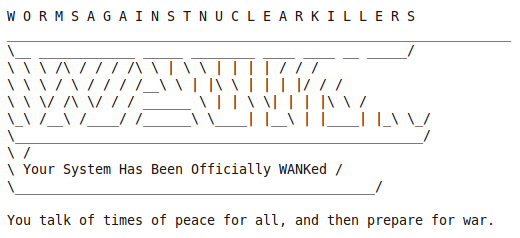
HACKING BORDERS: Examples of Art Hacktivism & Cultural Hacking…
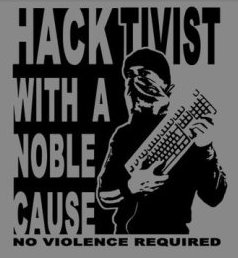
“Radical groups are discovering what hackers have always known: Traditional social institutions are more vulnerable in cyberspace than they are in the physical world. And some members of the famously sophomoric hacker underground are becoming motivated by causes other than ego gratification.” [11] Harmon.
Hacktivism, exploits technology and the Internet, experimenting with the immediacy of distributable networks as a playful medium for independent, creative and free expression. There has been a gradual and natural shift from net art (and net.art) into Hacktivism. Net Art in spirit, has never really been just about art being viewed on a web browser alone. Some of the very same artists whose artwork involved being shown in browsers and making code behind the browser as part of the art, have also expanded their practice outside of the browser. One such artist is Danja Vasiliev, “Fifteen years ago WWW was something very new in Russia and besides the new dial-up aesthetics and world-wide means it brought a complete new layer of existence – “netosphere”, which made my youth.” Vasiliev very soon moved on from playing with browsers into a whole new territory. [12]
Danja co-founded media-lab moddr_ in 2007, a joint project at Piet Zwart Institute alumni and WORM Foundation. Based in Rotterdam moddr_ is a place for artists and hackers, engaging with critical forms of media-art practice. He collaborated with Gordan Savicic and Walter Langelaar from the moddr.net lab on the project Web 2.0 Suicide Machine, which lets you delete your social networking profiles and kill your virtual friends, and it also deletes your own profile leaving your profile image replaced by a noose.”The idea of the “Web 2.0 Suicide Machine” is to abandon your virtual life — so you can get your actual life back, Gordan Savicic tells NPR’s Mary Louise Kelly. Savicic is the CEO — which he says stands for “chief euthanasia officer” — of SuicideMachine.org.” [13]
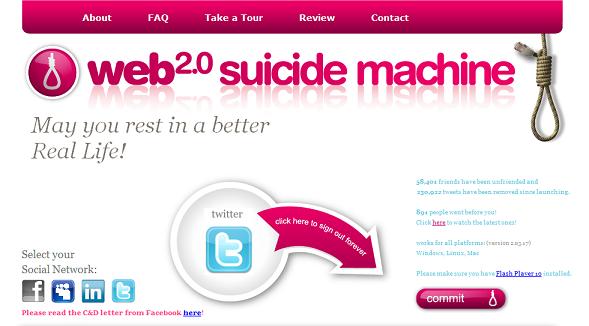
Just like another project called ‘Face to facebook’ that stole 1 million facebook profiles and re-contextualized them on a custom made dating website (lovely-faces.com), set up by Italian artists Paolo Cirio and Alessandro Ludovico, whom also just so happens to be editor in chief of Neural magazine. Web 2.0 Suicide Machine, had to close its connections down regarding its Facebook activities after receiving a cease and decease letter from Facebook. [14]
Julian Oliver and Danja Vasiliev teamed up and formed the mysterious group Men in Grey. The Men In Grey explore our online vulnerabilities by tapping into, intervening into wireless network traffic. Observing, tracing and copying what we do. This hack then redisplays our activities back to us, showing the data of our online interactions.
At first no one (except myself & a few others) knew who they were. When they first arrived on the scene I started an interview with them and then suddenly, I was asked to hold back due to their antics on the Internet and interventions in public environments receiving much coverage. They were not sure how it would pan out for them. Partly due to the anonymous nature of their project, and also because of the sudden impact of the larger hacktivist group Anonymous getting much press in commercial media themselves.
“Men In Grey emerge as a manifestation of Network Anxiety, a fearful apparition in a time of government wiretaps, Facebook spies, Google caches, Internet filters and mandatory ISP logging.” M.I.G
“Spooks are listening into calls, just like they always have,” said Eric King of London’s Privacy International, in an e-mail. “With A5/1 being broken—you can decrypt and listen into 60 calls at once with a box smaller than a laptop.” [15]
Later they won the Golden Nica (1st prize) Interactive Arts category, Prix Ars Electronica in 2011. In a show called Project Space — M.I.G. — Display of unknown, quarantined equipment hosted at the Aksioma Project Space Komenskega, Ljubljana 2011. The statement read:
“The particularly threatening quality of the Men In Grey equipment is its apparently invasive nature; it seems able to penetrate – and even hack into – virtually any electronic device in its reach. While we are all aware of the wire-tapping and data retention done by the government (along with the spying carried out by corporations like Facebook and Google), Men In Grey seem to operate with a range of tools and techniques well beyond those that are currently known to be in use.”
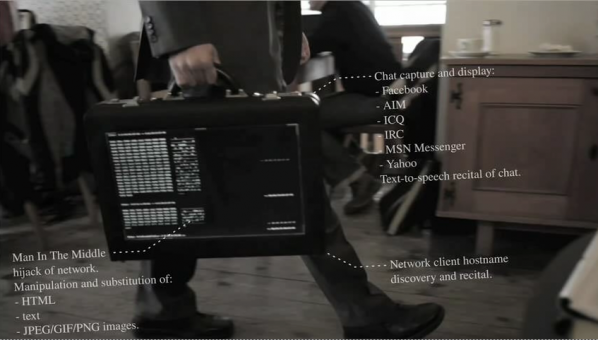
Hacktivism involves many different levels of social intervention and engagement. Whether it is to do with direct action, self-referential geekiness, obscure networked antics, crtical gaming, or peer 2 peer and collective change. Hacktivists challenge defaults put in place by other people, usually the systems imposed upon them and the rest of us by authority. Even though the subjects themselves may be concerning serious matters, humour and playfulness are both essential ingredients.
“A promising tactic for the early Situationists was the unpredictable yet forceful potential of play — what anthropologist Victor Turner termed the “liminoid,” or the freeing and transformational, moments of play when the normal roles and rules of a community or society are relaxed.” [16] Dovey & Kennedy.
One group crossing over from the digital into physical and social realms, is Tiltfactor. [17] Their form of intervention is not necessarily about causing political controversy, but is engaged in reaching people through games of play. Experimenting with social everyday contexts, making games that tackle less traditional topics, such as public health, layoffs, GMO crops. One of the many games creating awareness on these subjects, is POX “Our game actually helps a player understand how a disease can spread from one place to another and how an outbreak might happen” says Mary Flanagan. [18]
A local public health group called Mascoma Valley Health in the New Hampshire region of the US approached Tiltfactor with the problem of the lack of immunization. “At first, a game about getting people immunized seemed like one of the most “un-fun” concepts imaginable. But that sinking feeling of impossibility almost always leads to good ideas later.” [19] Flanagan.
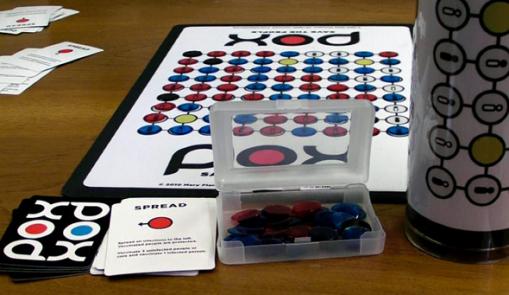
“Geopolitical space has always been a conflicted and fragile topic. Borders and frontiers are changing so fast, that sometimes it seems that our sociopolitical status can change from “citizen” to “immigrant” from one moment to another, or simply live under the “immigrant” status all your life. We’re getting used to words like refugees, enclaves, war, borders, limits –and the list has no end.” Ethel Baraona Pohl & César Reyes
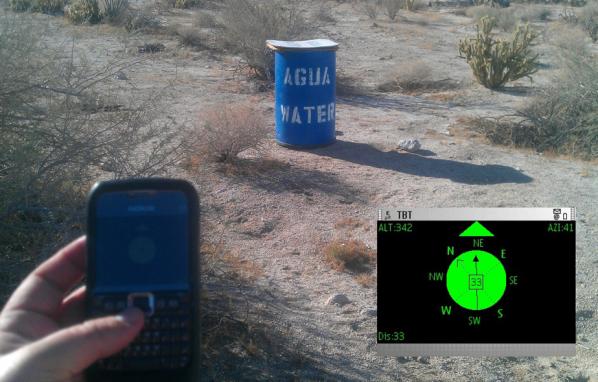
Ricardo Dominguez collaborated with Brett Stalbaum, Micha Cardenas, Amy Sara Carroll & Elle Mehrmand, on (TBT) (and others), on a hand-held mobile phone device that aids crossers of the Mexico-US border. An inexpensive tool to support the finding of water caches left in the Southern California desert by NGO’s for those crossing the border.
“The entire group of artists who are part of Electronic Disturbance Theater 2.0/b.a.n.g. lab working on the Transborder Immigrant Tool (TBT) was being investigated by UCSD and 3 Republican Congressmen starting on January 11, 2010. Then I came under investigation for the virtual sit-in performance (which joined communities statewide against the rising students fees in the UC system and the dismantling of educational support for K–12 across California) against the UC Office of the President (UCOP) on March 4, 2010. This was then followed by an investigation by the FBI Office of Cybercrimes.” [20] Ricardo Dominguez.
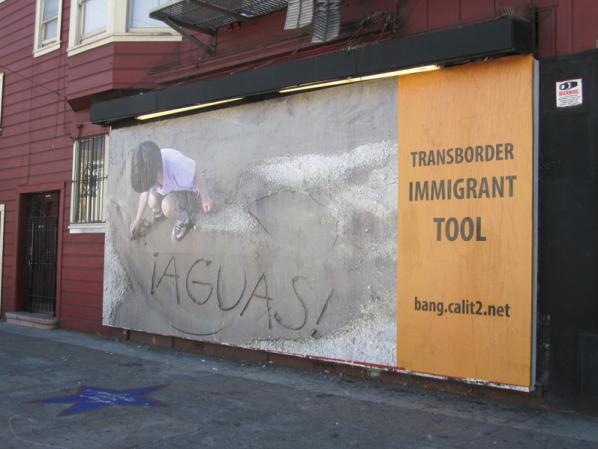
In an interview with Lawrence Bird Dominguez discusses that the TBT is still developing as a gps tool, but infers that it is not just a tool but also ‘border disturbance art’, consisting of different nuances existing as part of a whole with other factors at play. Such as a hybrid mix of things, objects and expressions “artivism, tactical poetries, hacktivism(s), new media theater, border disturbance art/technologies, augmented realities, speculative cartographies, queer technologies, transnational feminisms and code, digital Zapatismo, dislocative gps, intergalactic performances, [add your own______].” [ibid]
“Borders are there to be crossed. Their significance becomes obvious only when they are violated – and it says quite a lot about a society’s political and social climate when one sees what kind of border crossing a government tries to prevent.” [21] Florian Schneider
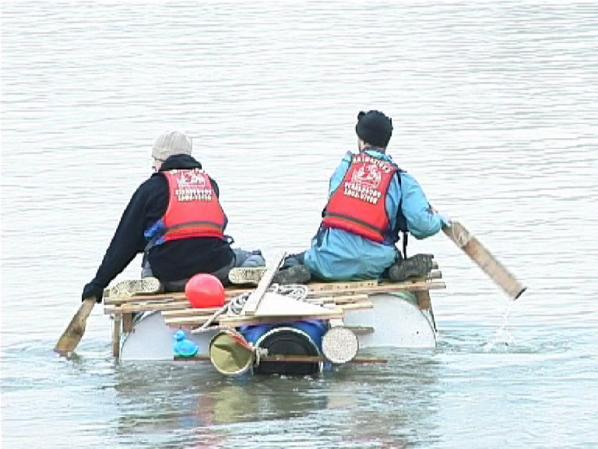
National borders are front-lines of political and social friction. The exerience of asylum-seekers and political migrants reflect some of the most significant issues of our time. Immigration is a toxic issue and unpopular with voters. Bunting’s BorderXing Guide, plays on the fear of invisible alien hordes of people crossing our borders illegally.
The context of this work fits well with issues about borders, whether it is about creating borders online or physical environments. Only those needing to cross a border are allowed access to the site, it is limited to ‘social clients’ who have a static IP (Internet Protocol) address and who, most notably, have gained the artist’s confidence. Such as peer activists and immigrants using libraries, colleges, cultural centres. The site allows those who would other wise end up crossing borders in harmful ways, such as in containers, on the backs of (and underneath) lorries and planes.
Heath Bunting’s BorderXing Guide website primarily consists of documentation of walks that traverse national boundaries, without interruption from customs, immigration, or border police. The work comments on the way in which movement between borders is restricted by governments and associated bureaucracies. It is a manual written not at distance like a google map, but by foot. A physical investigation, involving actually going to these places; trying these discovered routes out and then sharing them with others. A carefully calculated politics of public relations.
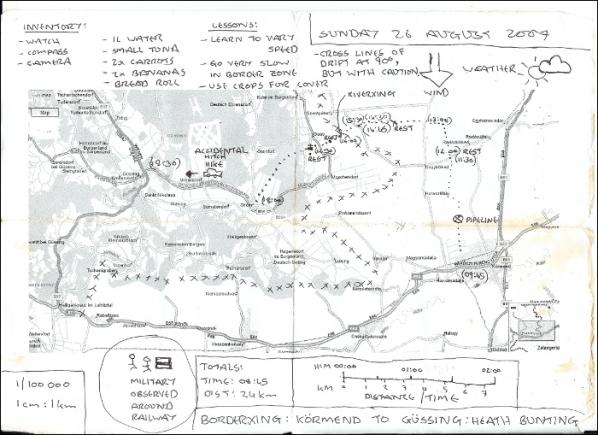
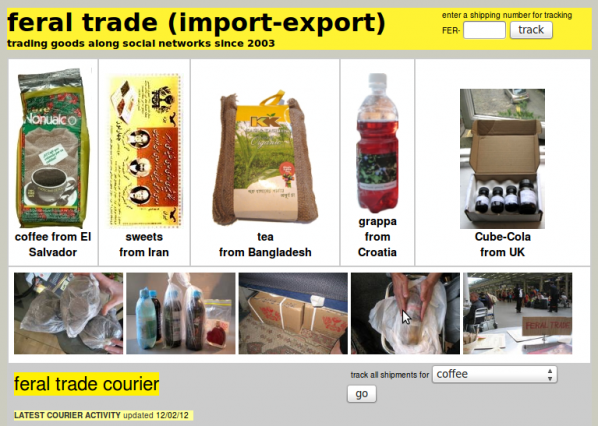
“The Feral Trade Café is more than just an art space that’s a working café, it’s about provoking people to question the way big food corporations operate by looking at the journey of the food we end up scraping into our pampered bins.” [22] Gastrogeek
Feral Trade uses social and cultural hand baggage to transport food based items between cities, often using other artists and curators as mules. Feral Trade products (2003-present), alongside ingredient route maps, bespoke food packaging, video and other artefacts from the Feral Trade network. The goods rangefrom coffee from El Salvador, hot chocolate from Mexico and sweets from Montenegro, as well as locally sourced bread, vegetables and herbs.
Kate Rich uses the word ‘feral’ as a process refering to being deliberately wild, as in pigeon, as opposed to romantic nature wild as the wolf. It is an unruly wild, shitting everywhere, disruption and annoyance in contrast to ‘official’ human structures and connected infrastructures. Feral Trade freight operates largely outside commercial channels, using the surplus potential of social, cultural and data networks for the distribution of goods. Working with co-operatives, small growers and food producers.
The Feral Trade Courier is a live shipping database for a freight network running outside commercial systems. The database offers dedicated tracking of feral trade products in circulation, archives every shipment and generates freight documents on the fly.
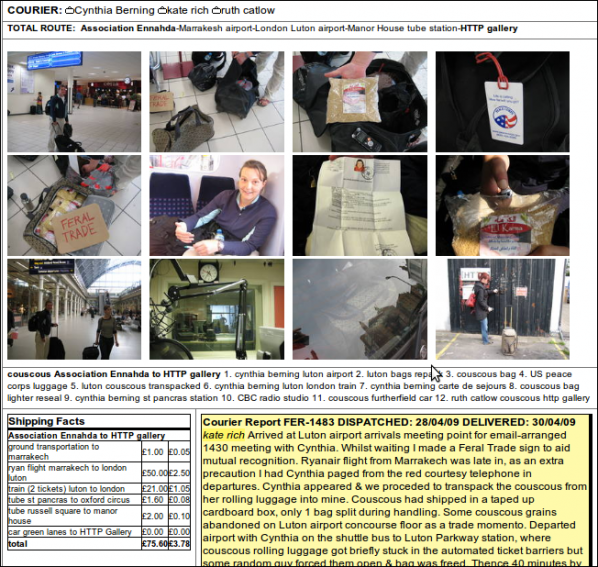
Every shipment is different and has its own story of how and where it was delivered from. Also included is information on who the carriers are with details about producers and their local culture as contextual information. The product packaging itself is also a carrier of information about social, political context and discussions with producers and carriers.
![Feral Trade at Furtherfield's Gallery (2009) [23] Link to exhibition](http://www.furtherfield.org/wp-content/uploads/2012/03/3657297700_42b1c26014_b.jpg)
Since the rise of the Internet individual and collective actions are symbiotically connected to the every day. In a world transformed, common people have access to tools that can change ‘our’ cultures independently; sharing information, motivating actions and changing situations. We know of the Arab Spring, the Occupy movement, Anonymous and Wikileaks and how successful they have been in exploiting technology and social networks. Technology just like any other medium is a flexible material. By tweaking, breaking and remaking ‘something’ you can re-root it’s function, change its purpose.
The links between these mass social movements and the artists here are not just relating to technology’s use but, a shared critique at the same enemy, neo-liberalism.
“”Neo-liberalism” is a set of economic policies that have become widespread during the last 25 years or so. Although the word is rarely heard in the United States, you can clearly see the effects of neo-liberalism here as the rich grow richer and the poor grow poorer.” [24] Martinez & Garcia.
At the same time as highlighting the continual privatization of human society. This form of art practice shows us the cracks of where a social divide of gate-keeping has maintained power within the Western World’s, traditional art structures. We now realize that the art canons we have been taught to rely on as reference are more based around privelage, centralization and market dominance rather than democratic representation or even just pure talent. Hacktivist artists adapt and recontextualize with a critical approach, towards a larger and more inclusive context beyond their own immediate selves. Demonstrating a respect and use of autonomy, and an awareness of social contexts and political nuances, freeing up dialogue for new discussions which include a recognition of social contexts, as a vital ingredient and valued resource in art. Re-aligning, reconfiguring the defaults of what art is today.
Lies, Lawlessness and Disbelief 1. Thinking Art and Capital: Conceptual Capitalism and Risk Management, is the first of five essays by Canadian artist & critical thinker, Katie McCain. McCain discusses how capitalism has become on the one hand all encompassing and on the other utterly unreal. Arguing that we need to be prepared to think the impossible so that resistance is able to grow.
DOWNLOAD the full text (including all 5 parts) here.
An Attempt at Thinking Art and Capital: Conceptual Capitalism and Risk Management
this sentence is a lie[1]
Capitalism is no longer the simple fordist system of production and consumption. It has, in its post-fordist lifetime become a more and more complex and intangible form. Today, it is a conceptual capitalism that has become unmoored, free floating, and all encompassing. As it continues, capital has the amazing ability to subsume everything it encounters, including criticism and resistance.[2] This proliferation seems to leave little room to resist – there is no longer a way to step outside and critique, since the death/failure of really existing socialism,[3] but this means only that critique must come from within, which is no small feat. It is a method riddled with paradox and self-defeat, but this perhaps reflects the nature of capital itself – as a system it offers up many moments of fissure or collapse that can be manipulated. The vastness of capitalism and the complexity of the bureaucracy necessary to hold together a system of “order” that directly contradicts chaos theory inevitably begins to circle and break down. It is these moments of circuity, of fissure, that this essay will focus on.
Contemporary capitalism is conceptual capitalism – it runs on the idea of money in the form of loans, mortgages, hedge funds, junk bonds; it is fictional money and a fictional market based on an elaborate system of risk management, which implies some intrinsic (but impossible) knowledge of the future. It also seems that this fictional market can be bolstered by belief alone. ‘The financial crisis of 2008 showed enormous sums of money spent not on a real, concrete problem, but rather to restore belief in the market. Capital, in all its intangible forms, is the Real of our lives’.[4]
If what Žižek states is true, and capitalism can be equated with Lacanian theory of the Real[5], it again seems to close down access to it further still. It is opposed to reality, which encompasses the Imaginary and the Symbolic and it is located beyond them, out of reach, but exerting influence. It is undifferentiated, without fissure, always in its place.[6] It is impossible to imagine, to verbalize, to integrate in the Symbolic order. But perhaps this impossibility is the moment, the fissure, which can bring about its demise.
The signification of the Real is attempted in the Symbolic order, but is impossible. The Symbolic structures everything, and through repetition is subject to the death drive. That is, in its constant return to enjoyment the Symbolic transcends beyond pleasure in search of death. This could be seen as some radical call to accelerationism, a desire to weaponize capitalism against itself, and in a way it is, but not in the apocalyptic sense that accelerationism implies, pushing it to its extreme.[7] Rather, a radicalism could exist in simply exploiting these impossibilities, finding weak points in rationality, and the supposed rationality of capitalist systems, in its inherent bureaucracy.
This Symbolic capitalism is contingent in regards to the Real; it does not spring from it[8], but is created out of a desire to verbalize the impossible, to understand something that is impossible to understand, to socialize this intangible system. It could be said that it is impossible to speculate on the origins of the Symbolic once it is in place, generated as it is from a primal prohibition, a negation, le-nom-(non)-du-pere[9]; once capitalism is in place, it becomes impossible to see an alternative to the universe it creates.[10] This is mostly due to the all-encompassing nature of conceptual capitalism. Perhaps then, the ability to catch it in a paradox, in a state of bureaucratic failure, could open up a space to trip it up and think other and could offer a passage a l’acte.
other other other say it three times in the mirror
Employing the idea of a contingent conceptual capitalism, that is, one which is not necessary, which is indifferent to existence, one can argue that in fact it is very possible to think of the other to capitalism. It is logic and rationality that trips it up, that prevents any thought of the alternative, just as it is strictly impossible to think infinity, or an ancestral time prior to human existence. Science can prove facts about both ancestral time and descendant time (prior to and after the death of consciousness), but philosophy is paradoxically stuck with the idea of a relation to the world before or after the existence of thought[11]. How can thought think the death of thought?[12] According to Hakim Bey it is impossible to really conceive of death – it appears rather as ‘an unpleasant vagueness’[13] – the death considered is never actual death. Similarly, how can one think anti-capital from within conceptual capitalism? If it is permitted that both the universe and capitalism are contingent, and therefore completely indifferent to human existence and human thought, then the possibility for alternatives opens up.
A speculative and realistic approach to thinking capital can restore our ability to resist.
Once it is granted that the tension between equality and liberty cannot be reconciled and that there can only be contingent hegemonic forms of stabilization of their conflict, it becomes clear that, once the very idea of an alternative to the existing configuration of power disappears, what disappears also is the very possibility of a legitimate form of expression for the resistances against the dominant power relations.[14]
If conceptual capitalism encompasses everything, there is less and less physical space for resistance, unless resistance moves into the conceptual realm as well. The idea, the imaginary, the psychical: these all offer a variety of forms of resistance to a boundless capital. For the concept, in its true dematerialized form, is capable of altering systems, of bolstering illogic, of predicting the future. It is the very boundaries of thought, beyond which lies psychosis (the lack of the Symbolic, or capital) that prove to be integral in terms of non-knowledge and the unknown, a knowledge of the unknown, or a thinking of the impossible. Perhaps lies, fiction and the radical un-real can be the site of production for a capitalist alternative.
Ideas are characterized as both distinct and obscure. They are distinct insofar as they are perfectly differentiated via the reciprocal determination of relations and the complete determination of points – but obscure because they are not yet differenciated – since all Ideas coexist with one another in a state of virtual perplication.[15]
Ideas are simultaneously two things, distinct and obscure. Graham Harman introduces the idea as something not only possible, but actual insofar as an idea is thought as an image. This introduces all things possible to the realm of the actual, even if only in thought.[16]
The contemporary mantra of risk management as a fundamental economic strategy is in itself paradoxical. If, in fact, a risk could be managed, then it would not really be considered a risk. This term depends on the belief in an organized system of capitalism that extends both directions through time – the idea that it is a constant that can be depended upon, is predictable, forever. In fact, the amount of bureaucracy that goes into even the tiniest element of conceptual capitalism manifests itself through many circular moments, many points of fissure. In compatibility with Gödel’s Theorem of incompleteness, no system can be totally defined without incurring some kind of paradox. There will always be statements that are true, but that cannot be proved within the system. If the system is capable of proving certain basic facts, then one particular truth the system cannot prove is the consistency of the system itself.[17]
Risk management is nothing more than a reaffirmation of our collective belief in the predictive qualities of financialization, our collective consent to the idea that an intangible, unmoored, all-encompassing economic system can be predicted. In fact, prediction alone is a falsity that humans fall prey to frequently; the notion of the future as anything other than a continuation of the past is a mental operation at which the mind continues to fail. When thinking of tomorrow, the mind just projects another yesterday.[18] The future, or rather a human relation to the future, is deemed philosophically impossible. After all, how can consciousness think something devoid of consciousness?[19]
It is impossible for thought to think an object or event in-itself – in this sense, thought can only experience a relation between the subject and the object-as-given. Lacan argues in his fifth discourse that we do not derive libidinal enjoyment from object relations, but rather it is capital’s link of subject-to-object that frustrates and isolates the subject. Capitalism is successful in the sense that it produces a continual desire, but no longer satisfies it, which for Lacan – and a world full of neurotics – falls in line with our drives.[20]
Lacan also reorients Marx’s analysis of surplus value. An older, more tangible form of capitalism sold objects for more than it cost to make them. This ‘surplus value’ is what Marx stated that the capitalists stole from the proletariats – it was used by the capitalists for leisure or libidinal enjoyment. Now, capital demands this surplus value to be re-invested at the level of production to create an unrelenting, perpetual motion machine of production and consumption of money by a business in-itself. We are now, according to Lacan, all proletariats, subject to the will of capital that has taken over the role of master from the capitalists themselves.[21]
The debt circulates on its own orbit, with its own trajectory made up of capital, which, from now on, is free of any economic contingency and moves about in a parallel universe (the acceleration of capital has exonerated money of its involvements with the everyday universe of production, value and utility). It is not even an orbital universe: it is rather ex-orbital, ex- centered, ex-centric, with only a very faint probability that, one day, it might rejoin ours.[22]
This faint probability is the only thing tying us to capital.
Adorno, Theodor.W. Negative Dialectics. Translated by E.B. Ashton. New York: Continuum, 2005. First Published 1966 by Suhrkamp Verlag.
Associated Press. “Romanian Witches Curse Latest Government Clampdown,” The Guardian, February 9, 2011, main section, 20.
Bartlett, Monica Y., Aida Cajdric, Nilanjana Dasgupta and David DeSteno, “Prejudice from Thin Air: The Effect of Emotion on Automatic Intergroup Attitudes.” Psychological Science 15, no. 5 (May, 2004): 319-324.
Baudrillard, Jean. Global Debt and Parallel Universe. Translated by Francois Debrix. http://www.egs.edu/faculty/jean-baudrillard/articles/global-debt-and-parallel-universe/ (accessed April 4, 2011).
Baudrillard, Jean. Radical Thought. Translated by Francois Debrix. Edited by Sens & Tonka. Paris: Collection Morsure, 1994.
Bey, Hakim. T.A.Z.: Temporary Autonomous Zone, Ontological Anarchy, Poetic Terrorism. New York: Autonomedia, 2003. First Published 1985.
Bradley, Will. “Guarana Power.” in Self-Organization/Counter-Economic-Strategies, edited by Bradley, Hannula, Ricupero and Superflex, 311 – 333. New York: Steinberg Press, 2006.
Brassier, Ray. “I Am a Nihilist because I Still Believe in Truth” Interview with Marcin Rychter. Kronos: March 4, 2011 http://kronos.org.pl/index.php?23151,896 – accessed: march 23rd, 2011.
Brassier, Ray. Nihil Unbound: Enlightenment and Extinction. Basingstoke: Palgrave McMillan, 2007.
Critical Art Ensemble. Marching Plague: Germ Warfare and Global Public Health. New York: Autonomedia, 2006.
Declercq, Frédéric. Lacan on the Capitalist Discourse: Its Consequences for Libidinal Enjoyment and Social Bonds. Psychoanalysis, Culture & Society 2006, 11, (74-83).
Fisher, Mark. Capitalist Realism: Is There No Alternative? Winchester: Zero Books, 2009.
Foucault, Michel. Power/Knowledge: Selected Interviews & Other Writings: 1972-1977. New York: Pantheon Books, 1980.
Fromm, Erich. The Fear of Freedom. London: Routledge & Kegan Paul Ltd., 1966.
Groys, Boris “Art and Money,” E-Flux 24 (2011), http://www.e-flux.com/journal/view/226.
Harman, Graham. Circus Philosophicus. Winchester: Zero Books, 2010.
Hofstadter, Douglas R. Gödel, Escher, Bach: An Eternal Golden Braid. London: Penguin Books Ltd., 1979.
Holt, Jim. “The Way We Live Now: Against Happiness,” New York Times, June 20, 2004.
Horizon: What is Reality? Documentary. Directed by Helen Shariatmadari. BBC: ep. 9, 2011.
Huberman, Anthony, ed. For the Blind Man in the Dark Room Looking for the Black Cat that Isn’t There. St. Louis: Contemporary Art Museum St. Louis, 2009.
Huxley, Aldous. Brave New World. London: Vintage Books, 2007. First published 1932 by Chatto & Windus.
K-Punk Blog. http://k-punk.abstractdynamics.org/archives/004421.html
Kafka, Franz. The Castle. Middlesex: Penguin Books Ltd., 1964. First published 1926 by Das Schloss.
Kurant, Agnieszka and Nassim Nicholas Taleb. “Unknown Unknowns: A Conversation between Agnieska Kurant & Nassim Nicholas Taleb about the Benefits of Uncertainty.” Frieze, September 2010, 127 -135.
Lacan, Jacques. “Seminar on the Purloined Letter.” Yale French Studies 48 (1972): 39-72.
Lacan, Jacques. The seminars of Jacques Lacan: Book II: The Ego in Freud’s Theory and in the Technique of Psychoanalysis 1954-1955. Ed: Jacques-Alain Miller. New York: W. W. Norton and Co., 1991.
MacKinnon, Catharine A. “Feminism, Marxism, Method and the State.” Chicago Journals 8, no. 4 (1983), 635-658.
Meillassoux, Quentin. After Finitude: An Essay on the Necessity of Contingency. London: Continuum, 2008.
Mouffe, Chantal. The Democratic Paradox. London: Verso, 2000.
Noys, Ben. Persistence of the Negative: A Critique of Contemporary Continental Theory. Edinburgh: Edinburgh University Press, 2010.
Place, Vanessa and Robert Fitterman. Notes on Conceptualisms. New York: The Ugly Duckling Presse, 2009.
Stephen, Kylie. “Sexualized Bodies.” in Real Bodies: A Sociological Introduction, edited by Evans and Lee, 29-45. Basingstoke: Palgrave MacMillan. 2002.
Taleb, Nassim Nicholas. The Black Swan: The Impact of the Highly Improbable. London: Penguin Books Ltd., 2007.
Thacker, Eugene. “Nihil Unbound” review of Nihil Unbound: Enlightenment and Extinction, by Ray Brassier, Leonardo 42: no.5, (2009): 459-460, http://muse.jhu.edu/journals/leonardo/v042/42.5.thacker.html (Accessed April 2, 2011).
The Trap: What Happened to Our Dream of Freedom? Documentary. Directed by Adam Curtis. BBC Two: March 2007.
Trotta, Roberto. “Dark Matter: Probing the Arche Fossil.” Interview with Robin Mackay. Collapse: Philosophical Research and Development 2 (2007): 83-169.
Vidal, John. “Bolivia Enshrines Natural World’s Rights with Equal Status for Mother Earth.” The Guardian. April 11, 2011. Main section, 15.
Weaver, Matthew. “Romanian Witches to Cast Anti-Government Spell.” The Guardian. January 7, 2011. Main section, 23.
Wilson, Eric G. Against Happiness. New York: Sarah Critchton Books, 2008.
Žižek, Slavoj. First as Tragedy, Then as Farce. London: Verso, 2009.
Žižek , Slavoj. The Iraqi Borrowed Kettle. http://www.lacan.com/zizekkettle.htm (accessed April 4, 2011).
Žižek, Slavoj. What Rumsfeld Doesn’t Know that He Knows About Abu Ghraib. (2004) http://www.lacan.com/zizekrumsfeld.htm (accessed April 4, 2011).
Featured image: Martijn de Waal, co-founder of The Mobile City, introduces the conference (image courtesy Virtueel Platform)
On Feb. 17th Amsterdam hosted Social Cities of Tomorrow, a conference on new media and urbanism. Adapting its title from Ebenezer Howard’s Garden Cities of Tomorrow, but taking equal inspiration from the work of Archigram, the conference presented a snapshot of the direction cities are moving today: as conventional means of planning and designing are renegotiated through our engagement with new media technologies:
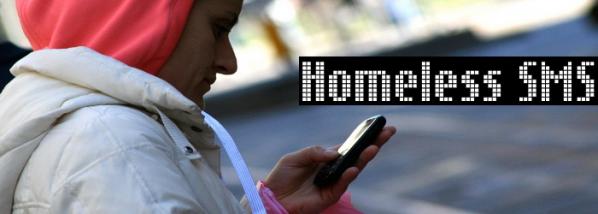
Organized by The Mobile City and Virtueel Platform, the event showcased best-practise examples of the use of media in urban analysis, design, art and activism. These ranged from “Homeless SMS”, a text-messaging system designed to provide information to the 70% of homeless Londoners who own cell phones; “Amsterdam Wastelands”, an on-line mapping of disused sites in Amsterdam and Zaanstad; “Koppelkiek”, a game project in which residents of a troubled area of Utrecht collected “couple snapshots” (in couples of friends, relatives or complete strangers), promoting social interaction through play; and “Urbanflow”, and New York-based project to rethink the contents of urban screens. In all, a dozen such projects were presented at the conference.
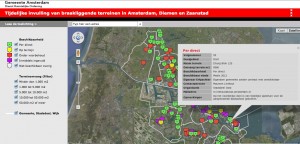

http://www.socialcitiesoftomorrow.nl/showcases
Immediately preceding the conference an intensive three-day workshop took place at ARCAM, the Amsterdam Centre for Architecture. This event brought together two dozen interdisciplinary creatives from around the world to tackle urban issues in four current case-studies: Haagse Havens, Den Haag; Zeeburgereiland; Strijp-S Eindhoven; and the Amsterdam Civic Innovator Network (a proposal to open up Amsterdam’s civic resources to distributed control by citizens). Working with local stakeholder organizations, the participants brainstormed how to leverage new media to solve intractable or new problems in these real-world sites.

http://www.socialcitiesoftomorrow.nl/workshop/the-four-cases
Also at ARCAM, a roundtable discussion on the alternative forms of trust emerging out of new media conditions was held, with panelists (below, left to right) Tim Vermeulen, Henry Mentink, Rietveld Landscape, Scott Burnham, Michiel de Lange (image courtesy Aurelie).

Keynote speakers Usman Haque, Natalie Jeremijenko, and Dan Hill concluded the conference with a panel discussion that placed the presentations in the context of distributed technology, contemporary art, social innovation, and architecture (image courtesy Virtueel Platform).

Taina Bucher interviews curator Gaia Tedone about her latest online curatorial project called ‘Is Seeing Believing?’ as part of the TRUTH programme at or-bits.com, an online platform for the display of contemporary arts and production of new works. Born in Italy, in 1982 Gaia Tedone holds an MFA in Curating from Goldsmiths, and has for the past year been one of the curatorial fellows at the Whitney Independent Study Program, New York. She has been involved in a number of art projects and worked with institutions such as Whitechapel Gallery, James Taylor Gallery, The David Roberts Art Foundation and Tate Modern.
Taina Bucher: Tell me a bit about your background for doing curatorial work. How did it get started and what are some of the thematic interests that have been important to your work?
Gaia Tedone: I started doing curatorial projects in London, where I was living and working for the past five years. The time spent at Goldsmiths was extremely formative from a practical and intellectual point of view. I was involved in a number of projects – some of them in collaboration with institutions in London, such as the series of talks Curating Fictions organised at Whitechapel Gallery, others were developed within the academic context, as for instance IM magazine and the publication A Fine Red Line (A Curatorial Miscellany) which I edited with fellow curators Isobel Harbison, Ilaria Gianni, Nazli Gürlek, Rosa Lleo and Yannis Arvanitis. The latter experience led us to establish the curatorial collective IM projects – a platform for editorial projects for which I contributed for the following two years.
The MFA in Curating at Goldsmiths and the Whitney Independent Study Program have both helped me to locate my interest in the history of art production within today’s global context and to look at the ways in which specific economic and political contexts shape the production and circulation of art. These two complementary programmes of study informed my research interests, which are located at the intersection between the fields of new media and cultural studies.
This year, within the context of the Whitney Program, I was exposed to a number of seminal authors and texts that since the 70s have contributed to the development of the field of cultural studies, and I was deeply inspired by the recent work of David Harvey and the political philosopher Chantal Mouffe. This intense year of research has informed the conception and realization of the exhibition Foreclosed. Between Crisis and Possibility that I co-curated with ISP fellows Jennifer Burris, Sofía Olascoaga, and Sadia Shirazi at The Kitchen in New York.
The exhibition, which included works by Kamal Aljafari, Yto Barrada, Tania Bruguera, Claude Closky, Harun Farocki, Allan Sekula and David Shrigley, took the current housing crisis in the U.S. as the departing point to explore other meanings of the word foreclosure, which also evokes processes of exclusion and a shutting down of recognition.
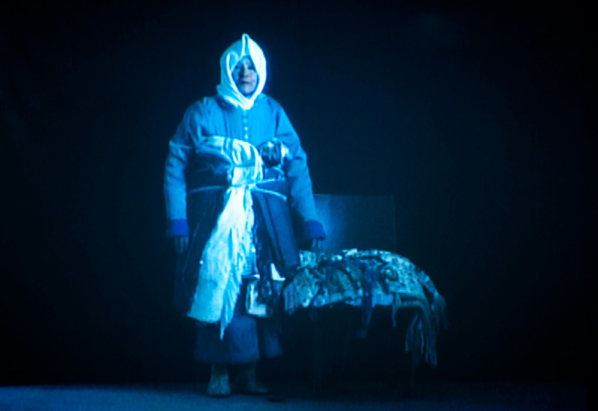
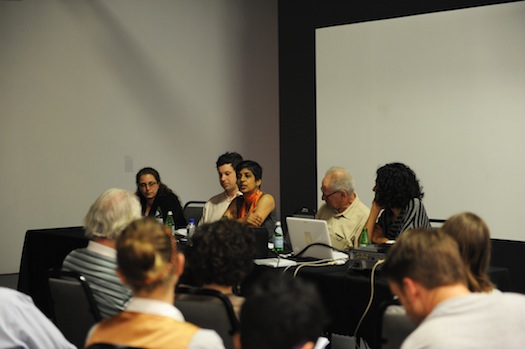
Taina Bucher: How did you get into doing online curatorial work?
Gaia Tedone: I was invited few months ago by Marialaura Ghidini to collaborate with her and Christine Takengny on the autumn issue of or-bits.com. Marialaura had some preliminary thoughts on how she wanted to develop the programme, and after few Skype meetings we established a common ground upon which we built three parallels projects. The programme curated by Marialaura was launched in early October with works by Angus Braithwaite/David Raymond Conroy/Adelita Husni-Bey/Iocose/ M+M (Marc Weis and Martin De Mattia)/Richard Sides and my response followed shortly after that. Is Seeing Believing? is my first curatorial work online.
Taina Bucher: How do you feel about exhibiting art online, what are the challenges and benefits? In what ways does the conceptual work with developing a project online differ from curating exhibitions in a more offline institutionalized setting?
Gaia Tedone: or-bits.com provided me with technical support in terms of coding and web-design, while I was left totally free to develop my own curatorial strategy. My original idea was to build up a True or False web-based questionnaire, mainly text-based. However, the project developed in a slightly different direction and I was happy to adapt its format to the eclectic contributions I was receiving. Once I gathered all the content, I chose to mimic the format of an online newspaper, as this seemed the best visual strategy to actually play with the ideas being put forth while maintaining an inner coherence for each artist’s contribution.
I found the context of the web extremely challenging from a curatorial perspective, as it required the ability to work simultaneously on different elements, from the editing of content to the formalization of a coherent visual output, employing an approach both flexible and rigorous. It felt like a condensed version of a ‘traditional’ show, yet faster in pace and with a different degree of curatorial control. It came together fairly organically. The Web I think poses a number of important questions, especially in relation to the short attention span we generally dedicate to what we read or look at when surfing the net. Would the type of art being produced have to play or interject whit this? How would it change the public’s experience or engagement? These are all open questions for me.
Taina Bucher: What is the idea behind your current exhibition on or-bits?
Gaia Tedone: The theme TRUTH developed out of several conversations inspired from Žižek’s text Good Manners in the age of Wikileaks and a shared interest in somehow questioning the democratic claim of the web as a space of freedom, in light of the recent developments of Wikileaks and of the role that social media played during the Arab Spring. In a world in which everyone can be the author of his/her own news, how do we assess what is true or false? And how is this shifting power’s relationships and individual agency?
Within this larger framework, the project Is Seeing Believing? specifically focuses on the relationship between image and belief and develops from the engagement with two particular images: first, the image of Caravaggio’s iconic painting The Incredulity of Saint Thomas (1601-1603), depicting Apostle Saint Thomas’ unwillingness to believe without direct, physical and personal evidence in Jesus Christ’s Resurrection. Second, the image published in the news showing President Obama, Hilary Clinton, Joe Biden, along with members of the national security team, watching Bin Laden’s death live.
The latter image, which quickly became one of the most publicly viewed in occasion of Bin Laden’s death, claims to present a less crude version of the story, but in fact it does not. On the contrary, it carries the absence of the image we are actually looking for – the one of Osama Bin Laden’s death body – affecting the viewer on multiple levels. On the one hand, by making the relationship between political power and media control even more visible; on the other, by acknowledging the necessity to see an image in order to believe in a fact. Then again, to what extent does it really matter if what we are looking at is the actual event or other people witnessing it? Has seeing become believing? These are some of the questions and preoccupations that have animated the conception and realization of this online project.
Taina Bucher: ‘Is Seeing Believing?’ is an exhibition displayed in the format of a newspaper. Who are the contributing artists?
Gaia Tedone: I began by approaching a number of artists, designers and activists whose work I admire and who, in my opinion, share a highly critical approach towards the production and reception of images and often employ a strategic use of the media in their practices. Some of the contributors, like for instance Jon Rafman, Nate Harrison, Alterazioni Video, The International Errorist and Foundand, have used the web extensively as the source and context of their works, others as for instance Azin Feizabadi and Oliver Ressler & Martin Krenn brought to the project their experiences of artists working within specific public spaces. A couple of interventions, such as the ones of MDR, Sadia Shirazi and Alessandro Sambini were specially conceptualised and produced for or-bits.com.
The idea of assembling them within the format of an online newspaper came at a later point, once all the material was gathered. It also pays homage to The New York Times Special Edition produced by The Yes Men and Steve Lambert and distributed for free in the streets of New York City in 2008. The paper announced the end of the Iraq’s war and changes in the US government’s policies on global warming, embracing for one day the philosophy of ‘All the News We Hope to Print’, at the beginning of President Obama’s administration.
The choice to play out specifically with Al Jazeera’s website was driven by the visual intelligibility of its design and by the desire to locate the project’s investigation within the context of this year political events and the role that social media played within the Arab Spring. As Sadia Shirazi interestingly points out in her contribution about Wikileaks as a socially engaged practice, if information is the terrain of war, what better context than a newspaper to put forth such urgent questions?
Taina Bucher: It is interesting that you say your or-bits contribution seeks to challenge the debate on image and truth by embracing the visual volatility of the web. Yet your newspaper is surprisingly static to be a webpage. Was this a conscious choice?
Gaia Tedone: This is a pointed observation. The webpage attempts to create a visual cohesiveness to the project, but it also asks the viewer to be actively engaged with the navigation.
I would see it as an attempt to fix in time the volatility of the web, maintaining in its content the associative and eclectic character of a browsing session, yet proposing a specific vantage point. In a sense it is like an exhibition, in which the works are in dialogue with each other, but have their own space and are framed by the specificity of the context.
Taina Bucher: Your project seems to suggest that we have no choice but to believe the image. Why is that? Haven’t we by now learned to be critical of the image, of its truthfulness and representability? Just think of Judith Butler’s book Frames of War where she addresses the dramaturgy of the Abu Ghraib photos. Susan Sontag already argued in 1977 that visual representation had become a cliché, that we are constantly bombarded with sensationalist images that numb our sense of believing. In what ways do you think, then, that the explosion of images online has somehow led to a diminished capacity to be critical?
Gaia Tedone: What interests me is the relationship between the access to images and the mechanisms of power that regulate this access and how this relationship is becoming more sophisticated and problematic within the context of the web and the role that social media play in the diffusion of images and information.
I think that a critical approach towards the reception of images is a condition that needs to shift and constantly adapt itself to the development of the image’s status itself. It cannot be separated from the historical and technological context in which images are produced and cannot be considered resolved as such, as the social and political configuration of the world is shifting also through the news and the images accompanying them.
Through the question Is Seeing Believing? I wanted to direct attention to the individual agency and the possibility for artists to filter, edit and rearrange the information and images they are exposed to, in this way challenging the notion of truth. To quote Siegfried Kracauer, who is also mentioned in the project, and his famous collection of essays ‘The Mass Ornament’ published in 1963: Never before has an age been so informed about itself, if being informed means having an image of objects that resembles them in a photographic sense. Never before has a period known so little about itself. In the hands of the ruling society, the invention of illustrated magazines is one of the most powerful means of organizing a strike against understanding.
These words still resonate powerfully with me, as they crucially point out to the ambiguous relationship between photography and information. Although there is a risk involved in believing in the image – risk that we must be aware of – what happens when the access to the image is negated to us? When this process of identification, compassion and repulsion that images often instigate is no longer accessible? Do we stop believing in reality or do we start to understand it?
President Obama’s decision not to diffuse the image of Osama Bin Laden’s body marks, in my opinion, a very important moment in the history of the images of the last decade.
It counterbalances with its absence 9/11, one of the most photographically reproduced events of this century – the day in which history and fiction met in the brutal instant of a photographic frame. I see this absent image as an occasion to stop, look back and critically reflect on what happened
Since the turn of the millennium, there have been shifts toward new forms of sociopolitical dissent. These include strategies such as cellular forms or resistance including asymmetrical warfare like global insurgencies, the use of social media. Examples would be Twitter and Facebook in their ability to lens dissent for actions in Syria, Egypt and Tunisia, Wikileaks and its ability to mirror, and politics that use anarchistic forms of collective action such as the Occupy Movement. Although my focus is more concerned with the Occupy Movement, what is evident is what I call an amorphous politics of dissent. Amorphous is defined as “without shape”, and can be applied to most of the mise en scenes listed above.
The dissonance of power in regards to conventional politics can be seen in its structure. For example, the nation-state has a tiered, hierarchical structure of power relations. There is a President or Prime Minister, a legislative organ of MPs or Representatives, Parliaments, Houses, and the like, a Judicial organ, and a Military organ that includes any number of militia and police. Although I am referring mostly Western forms of government, we can also argue for the hierarchical form in terms of the Corporation, with its CEO, Board, Shareholders, Managers, and Workers. This can be expanded historically to Feudal lords with their retinue of Vassals, Nobles and Warlords with their coteries of Warriors and support personnel. The point is that conventional power typically operates in a pyramidal command and control hierarchy with a centralized Leader at the “capstone”. One can argue that the pyramid may have different shapes, or angles of distribution of power, but in the end, there is usually a terminal figure of authority. To put it in terms of stereotypical Science Fiction terminology, when the alien comes to Earth, the standard story is that it pops out of the spacecraft and says, “Take me to your leader.” This signifies the hegemonic paradigm of Leadership as the central gestalt of First world power. Leadership, then, is the conventional paradigm of power in Western culture, and dominates the industrialized world.
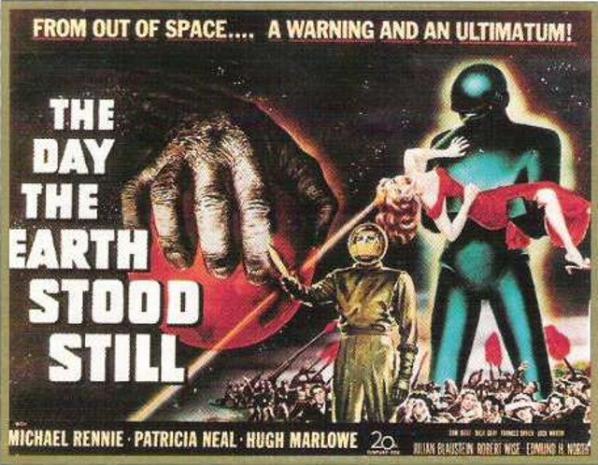
Territorialization refers to the exertion of power along perimeters, or borders. Functionaries expressing the constriction of territory include customs agents, and border patrols; but are terminally expressed by the military wing of the nation state. This military is also generally pyramidally constructed in terms of Generals, Colonels, and other officers leading Battalions, Regiments and Divisions, which are organized as defenders of a nation’s sovereignty. These military organs are conversely best optimized to exert their power against either parallel or subordinate structures. Parallel structures include the armies of other nations, their Officers, et al, and their troops and ordnance that possess a similar organization. Conversely, subordinate structures over which military powers can exert power over are domestic masses that can be overrun with overwhelming power, although these forces are more specialized (such as National Guards or Gendarmeries). In the conventional sense, power is expressed orthogonally, whether it is against equal or subordinate forces.
Another aspect of this conversation relates to the expression of power/force through conflict and violence, but has its inconsistencies The examples I will use from American pop culture I will use in this missive to explain amorphous action may be violent in nature, but the violent nature of these examples do not relate to the paradigmatic jamming of conventional power. Their citation is related more to the fact of conventional power’s orthogony, or parallelism of exertion of power to similar structures or dominance of the subordinate, and the panic state it experiences when confronted with non-conventional difference or passive resistance. We could express the power relationships between amorphous politics and conventional power in terms of a tetrad in terms of examples of violent and peaceful exertion of amorphous dissent as well as orthogonal conflict. We could cite the Occupy movement as a site of passive, and the Tunisian uprising as violent exemplars of amorphous conflict or dissent. Conversely, the Gandhi/King is a non-violent model of as orthogonal/hierarchical/led action, and World War Two as conventional orthogonal conflict. What is important here is the inability of the conventional politics and power to cope with leaderless, non-hierarchical, non-orthogonal discourse that refuses to talk in like terms such as centralization, leadership and conventional negotiations that include concepts such as “demands”. This is where the site of cognitive dissonance erupts, often resulting in a panic state or in the “figureheading” of dispersed networks of power.
The need for the traditional power structure to focus identity on the antagonist in terms of figureheads is evident in the Middle East and Eurasia in the personification of terrorist and insurgent networks, but is more simply illustrated in the films Alien and Aliens, and Star Trek: The Next Generation. Both of these feature their respective antagonists, the “alien” as archetypal Other, and the Borg, symbol of autonomous, collective community. In Alien, the crew of the Nostromo encounters an alien derelict ship that has been mysteriously disabled to find a hive of eggs of alien creatures whose sole role is the creation of egg factories for further reproduction. At the onset of the franchise, pilot Ellen Ripley is positioned as the “everywoman” placed in the center of cataclysmic events. In the Alan Dean Foster book adaptation, and an extended edit of the Scott film, Ripley finds during her escape from the ship that Captain Dallas has been captured and organically transformed into a half-human egg-layer whom she immolates with a flamethrower. However, in the Aliens sequel, the amorphous society of the self-replicating aliens has been replaced by a centralized hive, dominated by a gigantic Queen that threatens to impregnate the daughter-surrogate Newt. This transformation from a faceless to centralized threat creates a figurehead for the threat and establishes a clear protagonist/antagonist relationship, and establishes traditional orthogony.
This simplification of dialectic of asymmetrical politics is also evidenced in Star Trek: The Next Generation by the coming of the Borg, a collective race of cybernetic individuals. Although representations of the Borg vary as to fictional timeline, in televised media they began as a faceless hive-mind, which abducted Captain Jean-Luc Picard as a mouthpiece, not as a leader. It was inferred that if one sliced off or destroyed a percentage of a Borg ship, you did not disable it; you merely had the percentage left coming at you just as fast. However, by the movie First Contact, the Borg now possesses a hierarchical command structure to their network and, more importantly, a queen. With the assimilated and reclaimed android Lieutenant Data, the crew of the Enterprise infiltrates higher level functions of the Borg Collective, effectively shutting down the subordinate elements of the Hive. In addition, the Queen/Leader is defeated, assuring traditional figurehead/hierarchy power relations rather than having to deal with the problems of the amorphous, autonomous mass. There are other “amorphous” metaphors in cinema that address the issue of amorphousness. These include the 1958 movie, The Blob, in which a giant amoeba attacks a small town and grows as it engulfs everything. Another is The Thing, about a parasitic alien that doppelgangs its victims, creating another form of faceless threat. Lastly, we have the classic Invasion of the Body Snatchers where alien plant “pods” would bear fruit of duplicates of living people, giving a metaphor for the Communist threat of the Red Scare originating during the Cold War. Perhaps these are historical references to mediated expressions of anxiety in regard to autonomy’s threats to regimented/striated hegemony, stating that this sort of anxiety and terror are not new.
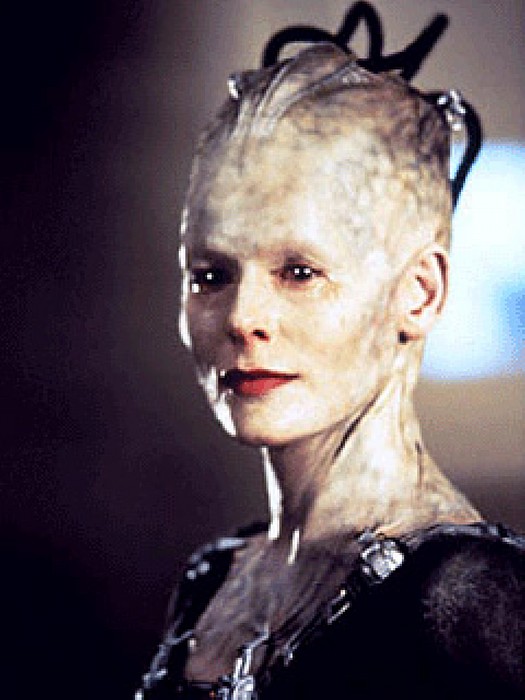
One of the most asymmetric cultural Western interventions in relation to constructs of traditional power is the involvement of Anonymous as part of the Occupy Movement. Anonymous, which has been called a “hacker group” in the mass media, is a taxonomy created on the online image sharing community 4chan.org, arising from the practice of posting “anonymously” unless one wants to use a name, or handle. Although the idea of Anonymous is at best an ad hoc grouping, the use of the “group” name has been ascribed to various factions. According to The State News, “Anonymous has no leader or controlling party and relies on the collective power of its individual participants acting in such a way that the net effect benefits the group.“ The idea of Anonymous fits with the “faceless collectives” mentioned above, and certainly presents an asymmetric, if not non-orthogonal, exercise of power. Anonymous first rose as a voice of dissent that emerged against the Church of Scientology (see Project Chanology), where flash mobs of individuals in Guy Fawkes masks and suits arrived to protest at sites around the world, with boom boxes playing “The Fresh Prince of BelAir”, a popular agitational or “trolling” anthem. It has engaged in other activities, including hacking credit card infrastructures opposed to handling donations to Wikileaks and creating media around Occupy Wall Street. However, without a clear infrastructure and only transient figureheads, Anonymous functions as an organizing frame for a cloud of individuals interested in various collective actions, and represents an indefinite politics based on networked culture. In an expected exercise of force, during the actions against elements opposed to Wikileaks, conventional power struck back wherever it could against members of Anonymous, by arresting over 21, some violently, in July during the actions against credit providers boycotting Wikileaks. This exercise of power was repeated in September, with admonitions about the arrests appearing on YouTube thereafter. Anonymous has also posted videos in support of the Occupy movement. Such a response is not surprising, but is the exact response to non-orthogonal dissent under our model. The problem is that in arresting any number of Anonymous members, traditional power is confronted with the first, distributed model of the Borg that merely exists minus two or twenty members.
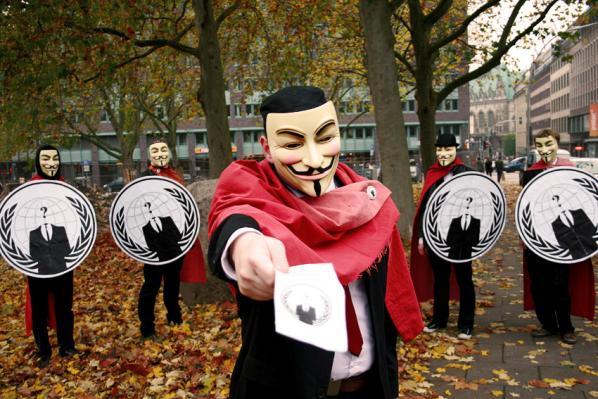
Another dissonance between the Occupy Movement and conventional politics is the perceived lack of agenda. This is due to its dispersion of discourse in giving its constituents collective importance in voice. What is the agenda of the disempowered 99% of Americans, or world citizens marginalized by global concentration of wealth? Simply put, the agenda is for the disempowered to be heard. What does that mean? It means anything from forgiveness of student loans to jobs to redistribution of wealth to affordable health care, and so on. It isn’t a list; it is a call to systemic change of the means of production, distribution of wealth and empowerment in political discourse. It isn’t as simple as “We want a 5% cut in taxes for those making under $30,000.” It’s more akin to “We’re tired that there are so many sick, hungry, poor and uneducated, and we want it to end. Let’s figure it out.” It is the invitation to the beginning of a conversation that has no simple answers other than the very alteration of a paradigm of disparity that has arisen over the past 40 years through American capitalism.
The last challenge to the traditional power discourse is that of passive resistance. This is not a new strategy, especially under the aegis of Gandhi and King’s movements. However, it is traditional power’s mere tolerance of nonviolent resistance that does not result in violence. As we can see from the UC Davis assaults and the dispersions after the second month anniversary, conventional power exerts its force against, as Brian Holmes put it, “anomalies” so that the system can be restored and the commodifiable classes are reintegrated into the system to reproduce its agendas. As long as resistance does not present undue inconvenience for the circulation of power and capital, it is allowed. Once it loses its patience with non-orthogonal forces, or if materially sacralized spaces, like Wall Street are threatened, the hegemonic order is reified. The irony of the technical loophole of Zucotti Park being privately owned and having few rules allowed the Occupy movement also highlights the tenuousness of public discourse in Millennial America. However, even with this oddity, on the two-month anniversary of Occupy Wall Street, force has begun to be used against the occupiers as traditional power’s patience grows thin with amorphous politics. In the streets, the marches are split up, and rules about occupation begin to be enforced with cupidity. As said before, hegemonic patience has worn thin, with assaults/dispersions taking place in Oakland, Davis, Philadelphia, and New York, among others. However, the movement moves forward for the moment.
Amorphous politics is based on plurality, collectivism, dispersion and ideas. The hierarchical nation-state has no idea what to do with the amorphous blob as it grows except to try to contain it, but as with Anonymous, it is a whack-a-mole game. If one smacks down one protest, two pop up across town, or five websites pop up on the Net. Shut down Wikileaks, and a thousand mirror sites show up. People in the streets swarm New York and other cities throughout the US, and the world, and conflict arises. Asymmetry and amorphousness are dissonances to traditional power. Ideas in themselves are not hierarchical.
Desires sometimes have no agendas.
Sometimes people want what is right, and all of it.
Dragana Zarevska and Jasna Dimitrovska are visual and performing artists, cultural workers and activists from Macedonia, who also, often work together under the artistic pseudonym Ephemerki. While at the same time loving and teasing the rigidity of academism, they like decoding magic, making it transparent, go behind Wizard of Oz’s curtain and put his pants down. The name of the duo is a funny derivate of Bapchorki (band of few grannies who used to sing Macedonian traditional songs in a rustic nasal style). It suggests that Ephemerki are their ephemeral version, or at least, the ones doing the ephemeral part of tradition. Their work is driven from and inspired by Donna Haraway, Judith Butler, Deleuze and Guattari, Agamben, and other contemporary thinkers and practitioners within arts, technology, society.
The Lele method is their latest performance (a performative event for a bunch of people, as they like to call it) and so far was performed at AKTO 6, Festival for Contemporary art in Bitola and Kondenz & Locomotion, Performing arts festivals organized in Skopje and Belgrade. Here is the story behind the project.

Darko Aleksovski: ‘Lele’ (Мac: леле) is a word that has profound significance in the Macedonian language. It is a universal word that can be used in different contexts and can imply several different emotional states. Can you describe what was the inspiration for this project dedicated to the word ‘lele’? What is the subjective meaning of this word for you?
Dragana Zarevska/ Jasna Dimitrovska: The particular situations this word implies and the problems it addresses might sound quite confusing for the non-Macedonian readers, but, if any of them have visited, or will visit our country, it’ll be deadly surprising how many “leles” per minute one hears around. The word “lele” is totally devoid of meaning, but it is being used to emphasize certain emotions, wondering, shock, great happiness and similar. It is just a shout out, like…the French “oh-la-la” for instance, the Bulgarian “ma-leeeh” or like the Serbian “yoooooy”. The project is being titled “The Lele Method”, directly and totally driven from the local obsession with lele and its possible application.
For us, this word sometimes depicts the shortly shaken numbness and the apathy of our current socio-political constellations, but only with a shout, and then again – everything goes on as usual.
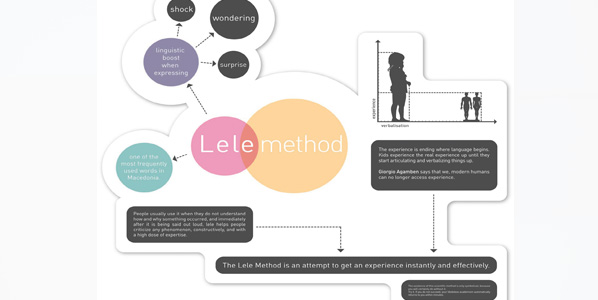
Darko Aleksovski: What is the ‘lele method’? Considering the performative act of the ‘lele’ word, and its everyday use in Macedonian speech, do you think that a method like this can still function as relevant? Can the ‘lele method’ be appropriated by anyone, or it is just a method that you as an artist use?
Dragana Zarevska/ Jasna Dimitrovska: Sure. It can be appropriated by anyone, but it is still a joke. You will certainly do without it as a method. Using it will not bring anything to your life what you’ve not had before. This is how we define it: Lele is one of the most frequently used words in Macedonia… people usually use it when they do not understand how and why something occurred, and immediately after it is being said out loud, Lele helps people criticize any phenomenon, constructively, and with a high dose of expertise. Try it. If you do not succeed, your libidoless academism automatically returns to you within minutes.
These instructions can help a lot in experiencing this useless experience through this useless method. But, stating the obvious with The Lele Method is what we enjoy the most. We give people what they already have, like selling snow to Eskimos.
Recently, in an interview we gave for the Canadian .dpi Magazine we discussed some particular effects we achieved by performing Lele. Nobody is aware of performing it daily here in Macedonia, and while we were preparing the performance out of it/about it, we realized the power of defamiliarization. You perform something which is being performed daily in a constant automatization. By naming a method Lele and putting it on a stamp, we gave the word a particular relevance and a different form. We made it “unfamiliar” and “difficult”, and by that, we prolonged the process of perception of that word. By trying to remove the automatism of perception, we got a new perspective of a word, of a problem. This technique has been used in the literary criticism of Russian formalism to differentiate prose from poetry, but we use it to differentiate and to delay perception. As Russian formalist critic Viktor Borisovich Shklovski has said in his well-known essay “Art as Device,” – the purpose of art is to impart the sensation of things as they are perceived and not as they are known.
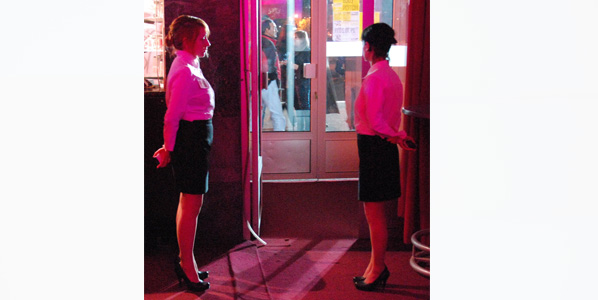
Darko Aleksovski: You have presented this project two times so far – as a performance accompanied by the printed version of the scheme of the ‘lele method’. How much performance is a necessary medium for this project?
Dragana Zarevska/ Jasna Dimitrovska: We’ve shown the performance at this year’s Akto Festival for Contemporary Art during August (Bitola/Macedonia), and at the Kondenz & Locomotion curatorially joint festivals for performing arts organized in Skopje and Belgrade during October. We must admit we entertain ourselves a lot during the performance because people enter the room and they perceive it as some irrelevant and boring employees who put a stamp on everyone’s hand at the venue’s door. Then, they look at the stamped hand/arm and shout “Leeeeeh-leeeeeh!” because that’s being engraved on our stamps.
During the performance we are dressed in our Lele uniforms which are extremely office-like and conservative, our faces are shit-serious, and inside the room there are printed materials (scattered leaflets on the tables, or printed panels on the wall) with diagrams on them explaining the empirical part of the Lele Method. The concept behind the Lele Method is being driven by our love and respect towards Giorgio Agamben’s work and his ideas on experience shown in his work Infancy and History. The experience is ending where language begins. Kids have the real experience until they start articulating and verbalizing things up. Giorgio Agamben says that we, modern humans can no longer access experience. The Lele Method is an attempt to get an experience instantly and effectively. The existence of this scientific method is only symbolic, because it is just mocking the academia and the naive ones simultaneously, as – all of the work we did/do by far.
Much of this performance auto-perpetuated, it is happening by itself. Performance is always a necessity. It is better for us to be aware of it, because we all perform all the time. This performance is all about being aware that we perform something of which we usually forget, but is actually performable – something automatized like the word Lele.
Darko Aleksovski: The project was very well received by the audience, other artists and critics. Does it have another aspect of it, that is directed as a critique towards the whole Macedonian art system?
Dragana Zarevska/ Jasna Dimitrovska: Thank you for this notion. Actually it was fantastic how great it was received. Our work can often be seen as an overlap between theory, movement, process and production. The contextualization of these things shapes the performative events we present that test and deconstruct different versions of reality and its geography, directly related to awareness of the possibilities of language. We criticize language/es through language.
Darko Aleksovski: Do you see ‘lele’ differently, now that you have made a project out of it?
Dragana Zarevska/ Jasna Dimitrovska: Yes we do. We got de-familiarized with it (by getting hiper-familiarized), while, at the same time we started to think of it as of our own word, which is pretty selfish. We totally “adopted” it. Other people who came to our performances also tell us they experience it a bit differently than before, one friend said “Whenever I say Lele I think of you!”. We know this might sound weird and vain, but it seems we assimilated it as our own piece of art, and the truth is – it is so not ours, it is everyone’s. We surely assimilated the illusion of having it as ours though.
more about the artists: zarevska [at] gmail.com, yasna.dimitrovska [at] gmail.com
The Transborder Immigrant Tool (TBT) is a project created by the University of California at San Diego’s Electronic Disturbance Theater (EDT) 2.0/b.a.n.g. lab, and still evolving today. Here Ricardo Dominguez, co-founder of EDT (with Brett Stalbaum), Principal Investigator of b.a.n.g. lab, and Associate Professor in the Visual Arts Department at UCSD, discusses the project with Lawrence Bird. The interview includes input from other members of the collective: Brett Stalbaum, Micha Cardenas, Amy Sara Carroll and Elle Mehrmand.
Lawrence Bird: Simply put, the Transborder Immigrant Tool is a hand-held device to aid crossers of the Mexico-US border. As far as the cultural and political implications of this device, it’s loaded. But as a starting point, could you tell us a little bit about the technical side of the device?
Ricardo Dominguez: We began with the basic question: what ubiquitous technology would allow us to create an inexpensive tool to support the finding of water caches left in the Southern California desert by NGO’s? Our answer was that the sub-$20 iMotorola phone series could be made useful for emergency navigation. The early generation of the platform we targeted can be made reasonably useful in a better-than-nothing scenario. Meanwhile, later phone generations (that don’t yet cross our price barrier but are getting closer everyday) are already fully useful as practical aids without even a SIM card installed or an available network service. With proper use, the GPS performance of newer phones equals any GPS designed for desert navigation, and their used prices are falling. Moreover, GPS itself does not require service and has free global coverage, courtesy of the United States government. In an emergency scenario, we trust these later mobiles to direct a lost person to a nearby safety site. The TBT’s code is also available on-line to download at walkingtools.net, sans water cache locations, for any individual or community to use for their GPS investigations.

Lawrence Bird: It’s an interesting instance of technology intersecting with geography. You have referred to Donna Haraway’s work in your own comments on the intersection between “border crossing” and other forms of “trans”-being. Would it be accurate to see the TBT as a cyborg component; and if so, what does this mean for the relationship between technology, politics and poetics?
Ricardo Dominguez: Part of the TBT project is to call into question the northern cone’s imaginary about who has priority and control of who can become a cyborg or “trans” human – and immigrants are always presented as less-than-human and certainly not part of a community which is establishing and inventing new forms of life. When in fact these flowing in-between immigrant communities are a deep part of the current condition that Haraway’s research has been pointing towards – for us it is a queer turn in its emergence, both as unexpected and as desire. The investigation of queer technology and what this queering effect has been or might be is an important part of our conversations – especially via Micha Cardenas’ research. This gesture dislocates the techno-political effect with aesthetic affects that become something other than code: a performative matrix that fractalizes and reverses the disorder of things with excessive transbodies acting from the inside-out of those enforced borderless borders. These affects assemble new empirico-tran(s)cendental forms of multi-presence(s) incommensurable with the capitalist socius of the so called “immaterial” Empire. As the Zapatistas say, “we do not move at the speed of technology, but at the speed of dreams” – the heart of the trans-border-borg.
Lawrence Bird: As you say, that –borg is spatial. Do you do any work with professionals of space design – for example, you have mentioned elsewhere the architect Teddy Cruz, who’s done design projects and spatial analyses focused on the Mexico-US border, especially urban borders?
Ricardo Dominguez: We have not worked directly with any urban space designers, such as Teddy Cruz, who teaches here at the Visual Arts Department at UCSD as well – but we have learned a great deal about the nature of the border-as-design and auto-assemblage – especially from the Political Equator gatherings that he has been at the forefront in creating. But recently we were invited to create a gesture for Political Equator 3 that we really enjoyed and offered a poetic materialization of bringing TBT into Mexico: at 12:30 p.m on June 4th, 2011 the Transborder Immigrant Tool was walked into Tijuana, Mexico via an aquaduct from the U.S. side of the border by artist Marlène Ramírez-Cancio (a video of this event is embedded above).
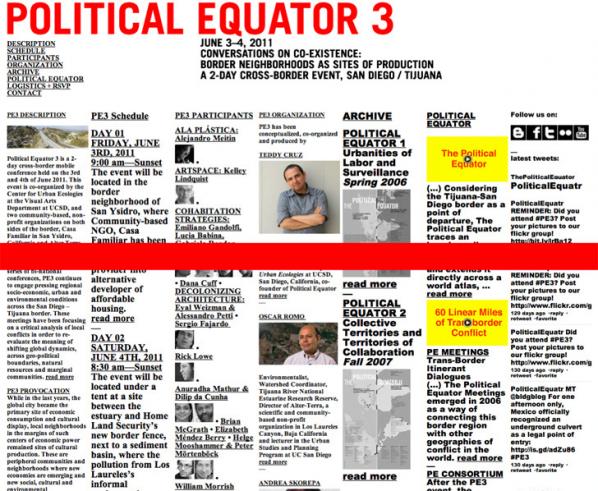
Lawrence Bird: Does any of this work intersect with American fear over border permeability to terrorism? The criticisms of TBT seem to focus on economic migration but the reaction bleeds into fears over security.
Ricardo Dominguez: TBT does crisscross a number of these types of affective conditions that have been floating around the border since 9/11; or one might push it back to early formations of the Mexico/U.S. border. And yes, it intersects with the growing state of fear in the U.S. (and around the world) about immigrants dismantling the U.S. economy – which has always struck me as extremely ironic – since as we have encountered in these past couple of decades, neo-liberal economics on a global scale have done much more to dissolve the romance of the nation via a series of self-made economic bombs than any immigrant “invasion.”
Lawrence Bird: In fact your development of this tool has come at a significant personal cost. You’ve been accused of supporting illegal activity and misuse of public funds. You’ve been called a traitor. Your position at UCSD was threatened. Could you talk about that and where this situation stands today?
Ricardo Dominguez: The entire group of artists who are part of Electronic Disturbance Theater 2.0/b.a.n.g. lab working on the Transborder Immigrant Tool (TBT) was being investigated by UCSD and 3 Republican Congressmen starting on January 11, 2010. Then I came under investigation for the virtual sit-in performance (which joined communities statewide against the rising students fees in the UC system and the dismantling of educational support for K–12 across California) against the UC Office of the President (UCOP) on March 4, 2010. This was then followed by an investigation by the FBI Office of Cybercrimes. So, it was three investigations in total— and they were all seeking to find a way to stop TBT and threaten to de-tenure me for doing the very work I was hired to do and then tenured for. In the end all the investigations were dropped. I did agree not to do another virtual sit-in performance on the UCOP for four years, but the day I signed the agreement, a number of supporters across the nation did a virtual sit-in on UCOP again. One strange element about the agreement that they wanted me to sign without even giving me or my legal team time to look it over was that I would never speak or write about what had happened, create any artwork that might disturb anyone and refrain from an artivist performances. Of course I agreed to none of it.
Lawrence Bird: The vitriol in the attacks on you is remarkable, and disturbing: you received a great deal of hate mail and a number of death threats because of this project. You mention in your play Sustenance (published in Artists & Activists 12) that these messages “constellate into remarkable patterns”, form a chart as it were of the agitated contemporary discourse over immigration, security, and national purity vs. liberty. It’s significant that you’ve built a play around this. Do you see the political and popular response to your project (you refer to it as “viral reportage”) as part of the TBT’s performative aspect?
Ricardo Dominguez: Part of the history of the Electronic Disturbance Theater 1.0/2.0 and b.a.n.g. lab (stands for bits, atoms, neurons and genes) at CALIT2/UCSD has been to develop works that can create a performative matrix that activate and take a measure of the current conditions and intensities of power/s, communities and their anxieties or resistances. So, for us the U.S. Department of Defense launching “info-weapons” at us for a virtual sit-in on September 9th, 1998 or the current confluence of “viral reportage” and the affective contagion of hate about the project that followed are all part of the performance – of course we would much rather the hate-mail never occurred – dominant media is bad enough to deal with. The aesthetics of working in the zones of post-contemporary artivist gestures cannot really escape these types of encounters; it is part and parcel of the patina of our work. But, we also feel that the hate mail or the general fear of losing national purity is co-equal in importance with the poetry that they were attacking. In fact Glenn Beck, an extreme right wing pundit on the Fox News Channel, attacked not only TBT’s use of poetry, but that the poetry itself had the power to “dissolve” the nation. The performative matrix of TBT allows viral reportage, hate-mail, GPS, poetry, the Mexico/U.S. border, immigrants, to encounter one another in a state of frisson – a frisson that seeks to ask what is sustenance under the sign of globalization-is-borderization.

Lawrence Bird: Can you tell us a little more about the poetry that accompanies the guidance system? How was this chosen, what does it concern? How do you envision the poetry developing as the project continues?
Ricardo Dominguez: Electronic Disturbance Theater 1.0/2.0 has always been invested in experimental poetry as part of its gestures – from the found poetry of the “404 file not found” of our ECD performances in 90’s to the border hack actions with the Zapatista Tribal Port Scan in 2000 on U.S. Border Patrol servers, where we would scan and upload Zapatista poems that we had written into their servers. When we started to develop TBT it became important once again to have a core impulse of the gesture. In 2008 I asked my partner, Amy Sara Carroll, who is an experimental poet and scholar, at University of Michigan, Ann Arbor – one of the areas of her research is on art and Mexican/U.S. border. She thought that TBT becoming a geo-poetic-system (gps) could expand the frame of experimental poetry and artivism. She then began to work with us and established two geo-poetic tracks – one conceptual and the other an echoing of desert survival manuals in multiple languages, which speaks to the multiple borders that are crisscrossing the planet and the multiple languages that are crossing Mexican/U.S. border via immigrants. Here is Amy speaking about TBT:
“…my collaboration with Electronic Disturbance Theatre (EDT) on the Transborder Immigrant Tool…(is) imagined as a global project under development, my own involvement in that ongoing process is linked to the question of what constitutes sustenance in the quotidian of the conceptual, on the varied musical scales of the micro- and macro-. For, often—rightly enough—conversations about crossing the Mexico-U.S. border refer to disorientation, sun exposure, lack of water. The Transborder Immigrant Tool attempts to address those vicissitudes, but also to remember that the aesthetic—freighted with the unbearable weight of ‘love’—too, sustains. A poetic gesture from its inception, the Transborder Immigrant Tool functions, via the aspirations of such a dislocative medium, as dislocative media, seeking to realize the possibilities of G.P.S. as both a ‘global positioning system’ and, what, in another context, Laura Borràs Castanyer and Juan B. Gutiérrez have termed, a ‘global poetic system.’ The Transborder Immigrant Tool includes poems for psychic consultation, spoken words of encouragement and welcome, which I am writing and co-designing in the mindset of Audre Lorde’s pronouncement that ‘poetry is not a luxury.’ … speaks to the Transborder Immigrant Tool’s overarching commitment to global citizenship. For, the excerpt, itself infused with the ‘transversal logic’ of the poetic, acts as one of the Transborder Immigrant Tool’s internal compasses, clarifying the ways and means by which I and my collaborators approach this project as ethically inflected, as transcending the local of (bi-)national politics, of borders and their policing.” http://bang.calit2.net/xborderblog/?tag=poetry
Here is a poem that made Glenn Beck extremely angry:
TRANSITION
(song of my cells)
Gloria Anzaldúa writes, “We have a tradition of migration, a tradition of long walks. Today we are witnessing la migración de los pueblos mexicanos, the return odyssey to the historical/mythological Aztlán” (1999 [1987]: 33). The historical? The mythological? Aztlán? It’s difficult to follow the soundings of that song. Today’s borders and circuits speak at “lower frequencies,” are “shot through with chips of Messianic time.” Might (O chondria!): imagine the chips’ transliteralization and you have “arrived” at the engines of a global positioning system—the transitivity of the Transborder Immigrant Tool. Too: when you outgrow that definition, look for the “trans-” of transcendental -isms, imperfect as overwound pocketwatches, “off”-beat as subliminalities (alternate forms of energy which exceed Reason’s predetermined star maps). Pointedly past Walden-pondering, el otro lado de flâneur-floundering—draw a circle, now “irse por la tangente”—neither gray nor grey (nor black-and-white). Arco-iris: flight, a fight. Of fancy. This Bridge Called my Back, my heart, my head, my cock, my cunt, my tunnel. Vision: You. Are. Crossing. Into. Me.
Here is a beautiful video version that Micha Cardenas and Elle Mehrmand did of the poem: http://bang.calit2.net/xborderblog/?p=49
In the strongest possible sense poetic practice has emerged in TBT that is co-equal with Brett Stalbaum’s idea of a “last mile” tool and his development of the code necessary to have it work. In fact we also think of the code-as-poetry as well – an expansion of codeswitching – literally.
Here is one of the desert survival poems:
En última instancia, muchos dirán que
la naturaleza establece el estándar de
la neutralidad. A diferencia de los seres
humanos, la naturaleza no hace lazos
de lealtad con la nación, la familia, los
negocios o la religión. Usted sabe bien
que el mayor peligro que enfrentará en el
desierto puede no ser el clima o el terreno.
Habrá quienes no tengan en consideración
su bienestar. Los rescatistas tienen el
compromiso de ayudar a quien lo necesite;
exíjales cumplir esa promesa. No confíe su
vida a nadie más, a ningún extraño.
All them are available in multiple languages to the user on TBT.

Lawrence Bird: How do you navigate the legal issues? Did you have a strategy in place ahead of time for dealing with these, or have you had to deal with them ad-hoc? Does your strategy/defense link up at any level with that of apprehended border-crossers?
Ricardo Dominguez: We are not attempting to navigate “legal” (national or international) issues – but we are trying to establish a reconfiguration of the border and immigration in terms of what we are calling transborder justice – the question of a “higher law” doctrine that David Henry Thoreau established in On Civil Disobedience. Also, in a more speculative manner as artists we see TBT as still in the process of becoming – it is still shape shifting and performing itself into potential spaces of use and poetics. TBT is border disturbance art that constitutes a visible geo-aesthetic/geo-ethics gesture against the boundaries and borderless borders that are crisscrossing every single body on the planet – we call for a geo-aesthetics that starts at the nanoscale and reaches to the GPS (Global Position System) grid system that floats around the planet, we call for a geo-aesthetics that connects both the human and the inhuman, geography and ethics, we call for a geo-aesthetics that crosses into and dislocates the smooth space of geo-spatial mobility with ethical objects for multiple forms of sustenance. We live in a world where only goods and services have rights to cross borders – a world that is a chaosmosis of markets that demand global exchange and aggressive state social filters. We need a geo-aesthetics that can construct ethical and performative complexities for the new earths to come, that can touch new geographies for new bodies – transbodies with transborder rights – artwork that can function as a geo-philosophy for bodies that are flowing as transborder bodies across all the borders the world – a flowing-trans-nation the planet cannot survive without.
Lawrence Bird: Have you considered applications of the TBT more globally, in Europe for example, or the Canada/US border, which has its own tensions relating to indigenous sovereignty? Or would this take it out of the specific politics you want to focus on?
Ricardo Dominguez: We imagine TBT’s code and gesture as open to use on multiple borders and that it is not bound to just the Mexico/U.S. border. One way that we have attempted to promote this possibility is by making the code available to anyone or any group at walkingtools.net.
Lawrence Bird: How extensively has your system been used on the Mexico/U.S. border? Or is it primarily rhetorical so far (it’s certainly been successful that way). How is it coordinated with others’ humanitarian efforts for border-crossers?
Ricardo Dominguez: On a very practical level our work with NGO’s has been focused on working with groups in Southern California who have established networks of water caches for immigrants crossing that area of the border – specifically Water Stations Inc. and Border Angels. Water Stations Inc., the longest running NGO working on this issue, has been very open to helping us test TBT and has also offered us extremely important insights into what the real conditions on the ground and what problems immigrants are facing. We recommend that if folks have funds to donate to these groups – please do. They were very wary of us at first – but they have now become much more supportive – especially because of the work that Brett Stalbaum and his partner, artist Paula Poole, have done in with them beyond TBT.
On the rhetorical end of the gesture much of the work that we do at b.a.n.g. lab is to start our research as a politics of rehearsal, a rehearsal of politics, as part of our art practice – to create an aesthetic of minor-signals and lower-frequencies…”like physics, aesthetics is a science whose primary object is signals, the physical materiality of signs….”– to quote from a recent tweet by Jussi Parikka. To manifest a type of science of the oppressed or engineering of the oppressed that imagines creating speculations that automatically, conceptually, begin to disturb not only the lines of thinking that criss-cross not only our bodies, but the ecologies of the Americas, and certainly the globe. And, so it becomes necessary to create these speculative disturbances that can allow one to think about another possibility, another impossibility, that these systems both manifest and, at the same time, call for an “anti-anti-utopian” potentiality, so that the engineering of the oppressed, the science of the oppressed, is about rehearsing the fictions that will then become realities. Our work in one sense is simply a gesture of “plagiarism”—a cutting and pasting of what is already an assemblage or a system that exists because immigrants are crossing multiple spaces around the world and GPS is everywhere in our cloudy global Empire. And so TBT itself is an attempt to create the multiple layers that manifest the social frictions, the speculative fictions, the rehearsal of politics, and of a counter-machine aesthetics—a machine of difference that can only really be performed by more than the multitude, if you will, to interrupt what Mary Pat Brady calls the U.S/Mexico border, “a state-sponsored aesthetic project.” We can see how these speculative gestures do create social responses on a global scale.
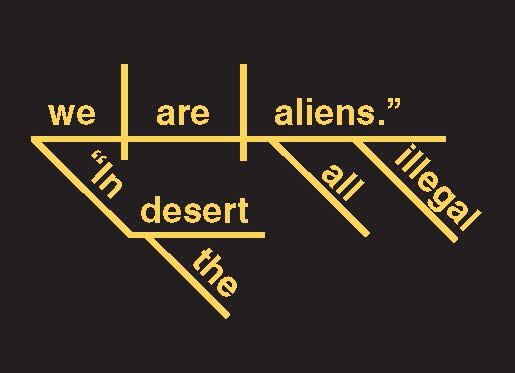
Lawrence Bird: TBT doesn’t just provide a map and way of locating oneself, it offers directions to various support services – where to find water, medical help. How are such safe sites managed and their position made public without making them vulnerable to border patrols? Are there any ethical issues involved here?
Ricardo Dominguez: The water cache sites are already well known by the U.S. Border Patrol, Homeland Security and anyone else who cares to take a trip along the Anza-Borrego desert in Southern California – in fact they have large flags signaling their locations. So TBT at this point is only doing one thing – offering the location of these known and established water caches – as a last-mile safety tool and nothing more. The cell phones we are using are not robust enough for anything else – now as more cheap high-end phones come on the market TBT will be able to offer more on multiple levels. So the ethical questions about TBT on the U.S. side of the border are not as complicated as those on the Mexico side of the border: these are questions about how TBT would interact with the coyote networks, would it be just one more material burden to those crossing, how does the extreme violence of the narco-war shut down the abilities of NGO’s etc., to work on distributing TBT with us – these questions seem much more important in terms of the ethics of the project – would it do more harm than good? Or is it a gesture that would offer a way out for some immigrants from the violence of these dangerous networks that they have to deal with in order to cross? At this point due to all last year’s issues we have not been able to formally present TBT to the immigrant communities preparing to cross to have a dialogue about these questions – but we are hoping to move forward with these encounters – sans any further investigations.
Lawrence Bird: And how has TBT been taken on the Mexican side – what is it’s perception on the part of Mexican citizens, politicians, media? I’m curious how their reaction compares to the response on the American side, which approached violence.
Ricardo Dominguez: It is difficult for us to access Mexico’s response to TBT in relation to coyote economies or the narco-war on the border – these are zones that we have not attempted to have conversations with or have correspondences with. But EDT 2.0 is concerned about how TBT might function within or alongside these violent enclosures that immigrants have to deal with on multiple levels. We do not want TBT to become an attractor for immigrants who are already targets for these groups. But what we can say is that Mexico’s dominant media and alter-media networks, from Tijuana to Chiapas, have been very responsive and supportive of TBT. One of the first awards TBT received was in 2007 from the new media arts festival Transito_MX, who awarded TBT the “trans-communities award,” and the award was handed to us by a representative of the U.S. Embassy in Mexico. So at this time the response to TBT is both unknown and known. Another concern that we have and that we hope to be able to have a better sense of by the end of the year is how the design works for immigrants, and to what degree do they consider it useful as an art work and “last mile” safety tool – this will be done via workshops with potential immigrants in Tijuana, Mexico. Also one of the core questions we will have, based on all the materials that immigrants leave in the desert while crossing – the heat and difficulty of crossing call for dropping as much away from the body as possible, from money, to telephone numbers, to pictures of loved ones, etc. – is one more thing to weigh one down really necessary? These are EDT 2.0’s concerns at this time in relation to the border on the Mexican side.
Lawrence Bird: You mention that what drives border crossers is a hope that amounts to a “hope for the unknown”? Could you elaborate on this? At any level do you see a contradiction between this and the technologies of transparency, like GPS?
Ricardo Dominguez: The radical gesture of transparency was extremely important to EDT 1.0 in relation to Electronic Civil Disobedience as theory and practice and it still is in relation to the general distribution of TBT – who were are, where we are, and why we are doing it. But we are also very interested in the notion of translucency as an aesthetic possibility for TBT that functions to dislocate the readability of GPS (Global Positioning System) and gps (a geo-poetic system) – a minor form of the technology that is no longer bound to the total vision of GPS that is now embedded in almost everything. This translucency functions as a single-bounce GPS that initiates the database of TBT and then shuts off – thus making triangulation impossible – unless the user decided to turn the function on during the crossing. TBT’s gps creates an aesthetic disturbance that dislocates GPS as a transparent device and instead offers a navigational translucency of the “last mile” with hope-as-sustenance as its guiding wave-point.
Lawrence Bird: In Sustenance you refer in passing to Baudrillard’s “desert of the Real”. It’s a compelling way of looking at the border desert where migrants are abandoned in their pursuit of the American fantasy. But adopting a perhaps more humanist attitude, would it be remiss to recall Saint-Exupéry’s words that “Ce qui embellit le desert…c’est qu’il cache un puits quelque part.” / “What makes a desert beautiful is that, somewhere, it hides a well.” Perhaps based on that juxtaposition, how would you place your project in relation to the tension between poetry, activist politics, and humanitarianism?
Ricardo Dominguez: TBT is still in a (gps) process of becoming – it is still shape-shifting and performing itself into potential spaces of use for activists and expanding the frame of dislocative poetics. TBT is border disturbance art that constitutes a waterwitching tool that indeed crosses the desert of the Real, the hard simulations of the border which seek to target and kill. It offers another possibility – with the anti-anti-utopian offer of the desert’s “beauty” that you are keying into the conversation. We imagine that this gesture echoes practices that fractalize the desert’s geo-aesthetics as: artivism, tactical poetries, hacktivism(s), new media theater, border disturbance art/technologies, augmented realities, speculative cartographies, queer technologies, transnational feminisms and code, digital Zapatismo, dislocative gps, intergalactic performances, [add your own______].

Face to facebook is the final project in a three part series named “Tha Hacking Monopolism Triology” by the two Italian artists Paolo Cirio and Alessandro Ludovico. It was launched on the 2nd February 2011, with a mixed media installation at the Transmediale festival in Berlin, and a press release announcing a new dating website called lovely-faces.com.
The set-up for the ‘Face to facebook’ project was to steal 1 million facebook profiles and re-contextualize them on a custom made dating website (lovely-faces.com). The data collected from the profiles was only information available publicly on the internet, like the users name and profile picture. No facebook account was needed to access it. The 1 million facebook profile pictures were then checked for images that were usable in a dating webstie context. The remaining 250,000 profile pictures were then fed through various face recognition filters to assign an assumed personality to the subjects and a new profile was created ready for the dating website. Once published on lovely-faces.com, interested pursuers could get in contact with the people behind the original facebook profiles through facebook messages.

On the 10th February, 8 days after its launch, the dating website lovely-faces.com was shut down. This was following a cease and decease letter from Facebook[1]. Back in 1999, the net artist Heath Bunting was also subject to a cease and decease letter, that time from American Express. The letter sent to Paolo Cirio and Alessandro Ludovico in 2011 (as PDF) can be seen here, and the letter sent to Heath Bunting in 1999 is published here.
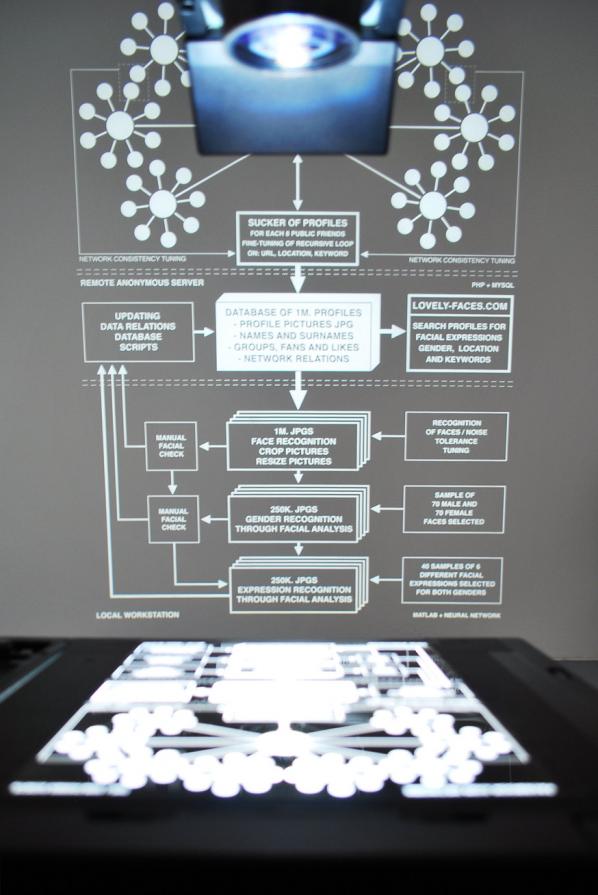
This project, and the ripples it left on the media water, highlights an ambiguous relationship many have with facebook. Many people sign up, upload a smiling profile picture of themselves and declare personal details to the large corporation that is Facebook without concern. Not until these identities and personal images were scavenged and then reused, the ownership and potential audience of this personal data is questioned. As the artists state themselves: “The final step is to be aware that almost everything posted online can have a different life if simply recontextualized. “
“The process is always illustrated in a diagram that shows the main directions and processes under which the software has been developed. We found a significant conceptual hole in all of these corporate systems and we used it to expose the fragility of their omnipotent commercial and marketing strategies. In fact all these corporations established a monopoly in their respective sectors (Google, search engine; Amazon, book selling; Facebook, social media), but despite that their self-protective strategies are not infallible. And we have been successful in demonstrating this.”
Web 2.0 Suicide machine (http://suicidemachine.org/) is another project which deals with your online identity. It allows you to automatically delete all your social network profiles and it simplifies the process – according to their website 8.5h quick then a manual deletion. Incidentially, the facebook is not one of the profiles subject to deletion in the suicide machine anymore, following another cease and decease letter: http://suicidemachine.org/download/Web_2.0_Suicide_Machine.pdf.
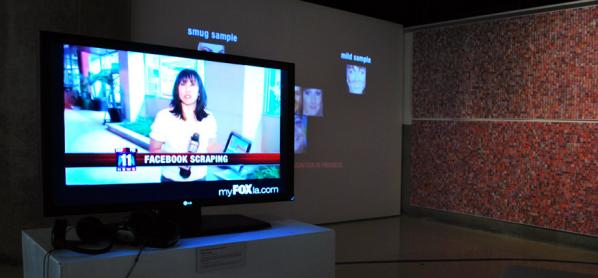
Since the lovely-faces.com dating website is still closed down, the project now (September 2011) consists of: documentation of the process used to acquire the facebook profiles; documentation of the global mass media hack performance, in the form of news broadcasts, magazine articles and blog post referring to the project; legal correspondence between the lawyers of the artists and Facebook; a mixed media installation; a touring lecture given by the authors. The latter two being re-performed and installed in various venues around Europe and beyond. The former are all available on the website face-to-facebook.net
The ever changing nature of this project therefore makes it a great example of a piece of contemporary art of variable nature, one which is in constant flux and is formed by the cultural, networked and physical landscape surrounding it. It does not only challenge the ownership of your online identity, it is also a nuisance for a mainstream contemporary art market based on institutional preservation and commercial commodification. These disruptions may also be linked. On the one hand there is an action to copy a system collecting and commodfying people and then use them as assets in one’s art expression and experience. “In all the three projects, the theft is not used to generate money at all, or for personal economic advantage, but only to twist the stolen data or knowledge against the respective corporations.” And then on the other hand, it is an art project which is not straightforward to see what the remaining artefacts actually are, whilst defying the process of being added to traditional art collections.
Other Info:
The Hacking Monopolism Trilogy. Face to Facebook is the third work in a series that began with Google Will Eat Itself and Amazon Noir. http://www.face-to-facebook.net/hacking-monopolism-trilogy.php
Elin Ahlberg is studying Art and Visual culture at the University of the West of England in Bristol. She has been living in the UK, and Bristol, since her move from Sweden in 2006. As an artist, she works in a variety of mediums and produces work which aims to both amuse and provoke. Her practice and research is informed by quasi-anthropological observations and an interest in technology. “One year ago I gave up Facebook for lent. It was quite an interesting experiment and I realised how integrated my life was with the social networking website as I actually felt that I missed out on things.” Ahlberg’s essay Meanings constructed around Facebook can be found here http://elinahlberg.wordpress.com/2011/07/18/essay-meanings-constructed-around-facebook-2011/
Marc Garrett interviews John Jordan and Gavin Grindon about their collaborative publication, A Users Guide to (Demanding) the Impossible.
Published by Minor Compositions
“This guide is not a road map or instruction manual. It’s a match struck in the dark, a homemade multi-tool to help you carve out your own path through the ruins of the present, warmed by the stories and strategies of those who took Bertolt Brecht’s words to heart: “Art is not a mirror held up to reality, but a hammer with which to shape it.”
Marc Garrett: In the introduction of your publication it says that it, “was written in a whirlwind of three days in December 2010, between the first and second days of action by UK students against the government cuts, and intended to reflect on the possibility of new creative forms of action in the current movements. It was distributed initially at the Long Weekend, an event in London to bring artists and activists together to plan and plot actions for the following days, including the teach-in disruption of the Turner Prize at Tate Britain, the collective manifesto write-in at the National Gallery and the UK’s version of the book bloc.”
I think readers would be interested to know how the ‘teach-in disruption’ and the ‘collective manifesto write-ins’ went?
John Jordan: I was not at the first Turner teach-in so can’t give first hand account. From what I’ve heard it was a wonderful moment where the sound of the action penetrated into the room where the Turner Prize were being held, as the back drop of the channel 4 live link up. Kind of perfect, because it was a sound artist who got the award.
As for the National Gallery event – this was held during the evening after one of the big days of student action. Having spent the day being trampled on by her majesties police horses, a load of us went up to the National Gallery and mingled in front of Manet’s Execution of Emperor Maximillian, opposite a corridor that held a Courbet painting. It was a perfect placement as Courbet of all the 19th artists was really the one who understood the role of art within an insurrection, putting down his paintbrushes to apply his creativity directly to the organising of the Paris Commune of 1871 just as the impressionists fled the city to the quiet of the countryside. Only to return a few years later when Impressionism was launched, as a kind or artistic white wash over the massacres of the Commune, a return to normal bourgeois representation. Courbet had used the rebel city, a “paradise without police” as he put it, as a canvas to create new forms of social relationships and new ways of public celebration, including the destruction of the monument to Empire and Hierarchy, the Vendome column.
Several hundred artists and art students at a given moment sat down and occupied room 43, telling the staff that we would leave once a collective manifesto had been written. Which is what happened. Small groups of 10 or so were formed as the guards and director of the gallery paced up and down unsure of how to react, each group worked on points for the manifesto which were then read out and merged in ‘The Nomadic Hive Manifesto’ – http://www.criticallegalthinking.com/?p=998 – it was an extraordinary moment of collective, emergent intelligence, a reclaiming of a public cultural space from the realm of musefication and representation.
MG: ‘A Users Guide to (Demanding) the Impossible’ features quotes by individuals and groups, who have inspired many of us in the networked, Furtherfield community. But, I am also aware that you may be part of a younger generation, presently experiencing the brunt of education cuts imposed by the current government coalition. Could you explain how these cuts are effecting you and your peers?
JJ: Well I wish I was a younger generation !!! I’m 46 years old, it was written for the youth !! You should talk to some arts against cuts folk, I can put you in touch if you need to?
Gavin Grindon: I’m not exactly ‘the younger generation’ either, but I guess I’m in a strange position between. I recently finished my PhD, so a lot of my friends are either students or just becoming teachers. There aren’t many jobs about, academic or otherwise, and most of them are doing multiple part-time, short-term jobs to make ends meet, without the assumed security or career progression of a generation before, and the cuts are only going to exacerbate that situation. I guess what’s new is a recession on top of these kind of precarious work conditions, which extend far beyond the University. With part-time, hourly-paid and non fixed positions, replacing real jobs.
Of course it’s damaging, but it’s also been inspiring to see students responding to turning over lessons to discuss the cuts and seeing them on the streets. It’s politicised a lot of young people, and there’s an opportunity there. At one of the University’s I work at, it was great to see the art students working together to make protest banners, not in their studios but in the foyer, where other people could see and join in. And when I started talking with them, we began to realise that with all the technical resources of an art school at their disposal, it was possible to be much more ambitious and imaginative than just making banners or placards, the standard objects of protest. But the history of a lot of art-activist groups who had these kind of ambitions isn’t taught, never mind the more popular history of the arts of social movements itself. And it’s not just about knowing and being inspired by some great utopian tales of adventure, or understanding yourself as part of a historical legacy – it leaves you strategically disadvantaged about what can be done. So starting a conversation with these students, was, as JJ says, kind of the idea behind the guide.
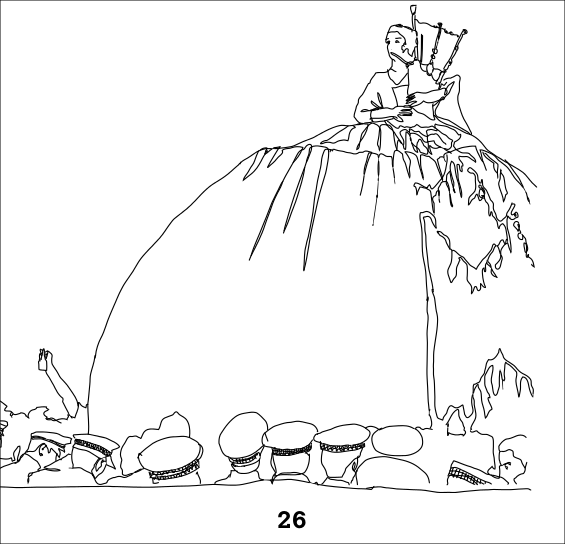
MG: There are various other creative protest groups such as UK Uncut (http://www.ukuncut.org.uk/) and the University for Strategic Optimism (http://universityforstrategicoptimism.wordpress.com/), whom I interviewed live on Resonance FM, December last year (http://www.furtherfield.org/radio/8122010-university-strategic-optimism-and-genetic-moo). Are you connected to any of these creative activist groups, and are there any others in the UK you would like us to be more aware of?
JJ: Yes – I’ve worked with UK Uncut, and was unfortunately arrested in Fortnum and Mason, whilst recording the BBC 4 afternoon play, but that’s another story! There are lots of interesting groups that work on the edge of art and activism, right now a space to keep an eye out for and to visit is THE HAIRCUT BEFORE THE PARTY – http://www.thehaircutbeforetheparty.net/ – set up by two radical young art activists who have opened a hair dressers that offers free hair cuts and political discussion about organising and friendship, rebellion and the material needs to engage in it. The salon is in 26 Toynbee Street, near Petticoat Lane and open till November. It’s an interesting example of a medium to long term, art activist project that attempts to create new forms of relationship and affinity, and sees itself as building radical movement and not simply representing them.

GG: Yeah, again the idea of the text was to build on the connections that are already there, which THBTP does too in a more informal, social way. And for sure, you shouldn’t be seen at the June 30th strikes or UK Uncut’s support actions without a flash new haircut. I should also get a plug in for Catalyst Radio – http://www.catalystradio.org/ a new 24/7 DIY UK-wide activist radio station, which started up the other week and is still growing, and brings together a lot of radical radio projects from around the country.
MG: Do you share a mutual empathy and respect for other protesters elsewhere such as those in Spain and in Greece, and in the Middle East?
JJ: Of course. Although it feels like the camp protests are lacking a conflictual approach and without the mixture of conflict and creativity, protest can easily be ignored, which is a bit what has happened with all the European camps. Although sitting here in the British library its easy to be critical ! Whatever happens, those involved in the camps will have tasted politics, new friendships, alternative ways of organising etc… As for the middle east, its all still in flux, who knows what will happen and the role of artists and musicians has been pretty key in setting the powder kegg alight there..
GG: Yeah, though I think there’s a tension between the symbolic solidarity of occupying city squares and the strategic differences between activist practices in different countries. I think solidarity between these struggles is massively important, though I’m personally not sure how it’s best to manifest that here right now.
MG: In the User’s guide, it mentions the workshops in art and activism at the Tate Modern, held by the Laboratory of Insurrectionary Imagination (Labofii), entitled it ‘Disobedience makes history’. And that Laboffii “was told, in an email, by the curators that no interventions could be made against the museum’s sponsors (which happen to be British Petroleum) [..] decided to use the email as the material for the workshop. Projecting it onto the wall they asked the participants whether the workshop should obey or disobey the curator’s orders.”
What I find interesting regarding this episode is both that a big institution would take the risk of inviting in art and activist culture to their usually, protected environment whilst being sponsored by British Petroleum; and the different forms of controversies reaching the public from such situations. I am surprised that Laboffii would even consider doing such a project in the Tate Modern in the first place, but also pleased, because of the dialogue that has come out of the clash of different political contexts. So, isn’t it the case that we need to explore issues of corporate corruption further within these big institutions so that those who would not usually consider such things are suddenly faced with the issues?
GG: I’m sure JJ has plenty to say about this. But more generally, it depends *how* they function as a platform. An art gallery or a university can be a great discursive space to explore issues, but the bounds of that debate are also strictly limited in lots of ways. This is a problem with the idea of a bourgeois public sphere. Most often, that boundary is that you can debate whatever you like but questioning the basic systemic assumptions on which such spaces rest isn’t possible, at least not in a practical way. The lab’s workshop at the Tate tried to question exactly that kind of assumption about what culture is for, and who it benefits. But for many activists from social movements, who have less faith in the public sphere and its institutions to resolve issues by discussion, that neutered debate is more of a problem than a benevolent gift to the public, and they have to take a different approach. Its not necessarily opposed to those institutions as a whole, but just asks them to make good on what they claim to be.
JJ: It’s a long story, but the key is to be able to put one foot inside these institutions and to be not frightened to KICK. But not to KICK symbolically, to really kick, to really shake them up and to be able to let go of one’s cultural capital. The Labofii will NEVER be re-invited to do anything at the TATE, bang goes all our chances of a retrospective in the fashionable art activism world !!! 😉 But, what we gain is that we were free ! When the curators told us that we could not do anything, could not take action against BP and we refused to obey them, we were free, we could do what we wanted because they could not give us anything in return. The Zapatistas say, “we are already dead so we are free” – when power can give you nothing you want, you can do anything.. this is a very powerful moment. To see the faces of the curators, the head of public, the head of security etc during the meeting where they tried to censor the lab, was priceless – they had always had power over artists, because artists will normally do ANYTHING to get their work in the Tate, but we did not care, we cared about the politics, about the actions, about climate change and social injustice – we were more powerful than the institution in that moment because we were no longer dependent on them.. it was one of the most beautiful moments… and now the movement against oil sponsorship is spreading everywhere. The message is simple, give up your cultural capital throw away your dependence on these institutions and be free…
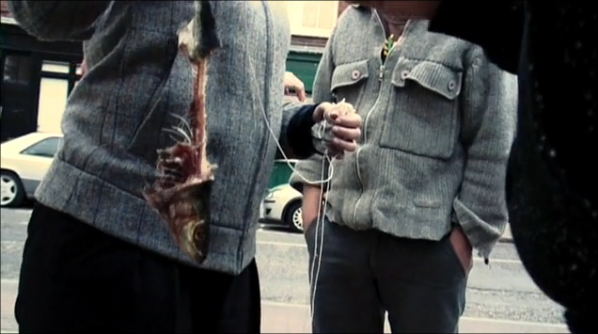
MG: I come from a background of hacking, social hacking and D.I.Y culture, and instead of going to University I chose to be self-educated, creating alternative groups for self discovery and art with dedication to social change. And even though, many are fighting the education cuts right now, what are your own ideas around self-education, do students really need to go to college now that there are so many different forms of information and ways in creating one’s own place in the world ‘with others’?
GG: A lot of experiments with autonomous self-education have sprung up recently which ask just this question, like the Really Free School (http://reallyfreeschool.org/), there are even some more institutional business-model experiments online with peer-to-peer education. But at the same time the catchment of both of these is relatively narrow at the moment, so I think there’s still a place for these kind of education institutions, and there are interesting radical experiments going on all over, either by individuals or whole departments, although the cuts to institutional funding for education by the government changes the playing field again, so there’s an opportunity for something like this to become less marginal, both inside and outside the university.
MG: JJ, In 2005 you wrote, Notes Whilst Walking on “How to Break the Heart of Empire”, in it you write “Radicals are often vulnerable souls. Most of us become politically active because we felt something profoundly such as injustice or ecological devastation. It is this emotion that triggers a change in our behaviour and gets us politicised. It is our ability to transform our feelings about the world into actions that propels us to radical struggle. But what seems to often happen, is that the more we learn about the issues that concern us, the more images of war we see, the more we experience climate chaos, poverty and the every day violence of capitalism, the more we seem to have to harden ourselves from feeling too much, because although feeling can lead to action we also know that feeling too much can lead to depression and paralysis…” How the hell do you remain positive when you know how many horrible and disgusting things are being done to decent folks and the planet all of the time?
JJ: Unfortunately there are no magic recipes that can protect us from such feelings, a lot depends on context on our particular situations etc. But here are a few tips that have helped me keep the despair of capitalism at bay:
1) Resist the spell of individualism that capitalism tries to weave around us, a spell that chains us to the fantasy of autonomy and keep us in a state of sadness and paralysis. Break this spell and its toxic chains by realising that you are part of a greater whole, that working with others gives us strength, that seven minutes making real friendships (face to face) is more political than seven days glued to a computer browsing social networks in a trance, that inevitably fails to shake the loneliness of modern life.
2) Build a gang, a group, a collective, a crew – remember the joy of plotting things together, the power and possibilities when work and imagination is shared. In fact, imagination finds it’s insurrectionary potential when we share it, when it’s freed from the privatised ego, escapes from shackles of copyright and the prison’s of the art world.
3) Learn the skills to work together with others, consensus decision making, group facilitation, conflict resolution etc. We need to re learn collective working methods, capitalism has destroyed all our tools of conviviality and we need to reclaim them back, recreate new forms of being together.
4) Redefine Hope. Not as something that will come and save us, like a saviour, but as something that comes from not knowing what will happen next, something that takes place when we act in the immediate moment and don’t know what will happen and trust that history is made from acts of disobedience that did not necessarily have any idea of what the next step was…
5) Remember that victory is not always what happens, but what did not happen. Social movements tend to forget this. Look at all the nuclear power stations that WERE not built, all the wars that did not happen, the laws that were never passed, the free trade agreements that were never agreed on, the repressions that the state could not get away with, the gmo’s that were never planted. One of my favourite books, what I call prozac on paper, is Rebecca Solnit’s HOPE IN THE DARK (http://www.goodreads.com/book/show/28048.Hope_in_the_Dark) – it’s a lovely little book which redefines hope in the most beautifully optimistic way, recommended reading when capitalism seems irresistible.
6) When everything appears useless, try to change your conception of time… think deep time, not shallow modern now time, but think about the generations that went before you and those that will come after you. Try to imagine what the generations of the future will think about your actions, imagine those from the past that fought for the emancipation of slaves and yet never saw the results of their actions, those who died for the eight hour day, for the right to build a union, the right to vote or publish an independent magazine. Spend time imagining how those alive in 50, 100 years will view your life and work…

MG: In the publication, you mention Marx and Debord. “We can all be engineers of the imagination”…”that our “general intellect”, all the collective knowledge and skills we use in making things, are taken away from us and embodied instead in the machines of our work. What would happen if we somehow re-engineered these machines if we did what Guy Debord argued and started, “producing ourselves… not the things that enslave us.” Do you see the recent cuts across the board as an example of how the powers that be are actively dis-empowering the working classes?
GG: Definitely. The cuts aren’t just about an experience of ‘austerity,’ however long term, but constitute a historical attack on poor and working people. They’re an attempt to technically recompose the material of the institutions, structures, ideas and habits people live through, in order to limit their ability to resist and remake them for themselves. In factory production, that involved the local restructuring of machine-labour, but later at a wider level Keynesian economic restructuring. This neoliberal restructuring of education is an extension of capitalist discipline into a new area, an attack on a social space which has historically been a base for social change. The government has made this pretty clear by, for example, David Willetts’s dictate amidst these massive cuts, to the Arts and Humanities Research Council, that the Tory party’s vacuous advertising slogan “the big society” become a core research area, replacing the less ideologically narrow area of ‘communities and civic values’; and the Department for Business and Innovation’s concomitant rewriting of the 1918 Haldane principle, that research directions are best decided by researchers through peer review.
The optimistic take on this is not that it’s an inevitable recuperation of resistance, which was the position Debord tended towards in the end, but that capital is always on the back foot – that its own developments are driven by and a response to social movements. That it’s an open dialectic (or if you prefer, not a dialectic at all). There’s a kind of neurosis to it, although rather than excluding the other to maintain its ego, the state is including everything to stave off other possibilities – you can see this in the language. The whole discourse of ‘participation’ and networks in business (and since the 1990s, also in art), is as Boltanski and Chiapello observed in their book the New Spirit of Capitalism, a recuperation of the language and terms of 1960s social movements – movements which first properly gave birth on a mass scale to the kinds of self-consciously autonomous and creative politics, or art-activism, which we talk about in the guide. Likewise, the big society is focused on mutuality, and there’s a strange recuperation of libertarian and radical thought by the thinkers behind it like Phillip Blonde. In this case, you’re left with a stunted vision of the anarchist idea of mutual aid, without any institutional aid, and structurally limited mutuality. But rather than simply critique this, I’m interested to look at how we might otherwise structurally and materially embody other kinds of social relation. Obviously this starts on a much smaller scale, and is often more directly materially embodied. University departments’ attempts to support radical philosophy within existing institutions and setting up new autonomous radical art institutions are two possible, but not mutually exclusive, directions here. As, of course, at the most local, accessible level, are the art-activist practices and objects we discuss in the guide.
Our new book-film is out “Les Sentiers de L’utopie”
Free online (in french) : http://www.editions-zones.fr/
Our blog: http://lessentiersdelutopie.wordpress.com/
our twitter: @nowtopia
3 different links to download the publication:
http://www.minorcompositions.info/usersguide.html
http://artsagainstcuts.wordpress.com/2010/12/06/a-users-guide-to-demanding-the-impossible
http://www.brokencitylab.org/notes/required-reading-a-users-guide-to-demanding-the-impossible
The Font used was Calvert is by Margaret Calvert, designer of our road signs.
Words: Gavin Grindon & John Jordan Design: FLF Illustration: Richard Houguez Original Cover: The Drawing Shed Produced by the Laboratory of Insurrectionary Imagination, London, December 2010. www.labofii.net Anti-copyright, share and disseminate freely.
More about Minor Compositions – a series of interventions & provocations drawing from autonomous politics, avant-garde aesthetics, and the revolutions of everyday life.
http://www.minorcompositions.info/
Crude awakening: BP and the Tate. The Tate is under fire for taking BP sponsorship money. Does corporate cash damage the arts — or is it a necessary compromise? We asked leading cultural figures their view. Interviews by Emine Saner and Homa Khaleeli. guardian.co.uk, Wednesday 30 June 2010. http://www.guardian.co.uk/artanddesign/2010/jun/30/bp-tate-protests
Featured image: Walled out and hammered by Marc Garrett
A young guy in his early Twenties becomes curious about the world of the arts. He decides to do what others would do in these circumstances: he picks up a few arts magazines from a local newsstand and browses their content looking for the latest trends. However, he increasingly becomes frustrated with the amount of advertisements that fill these magazines, that appear to prevail over any sustained discussion on the arts. He dislikes the way art looks more like a big commercial circus than the honest display of creative talent. He grows disaffected with the patronizing tones of editors and so-called authorities in the field.
He decides to denounce this publicly by creating an online fake of Flash Art online, the current leading contemporary art magazine in Italy, choosing the telling URL of ashartonline.com (as opposed to flashartonline.com), and filling it with his own content. Following the magazine’s distribution (for a fee) of a publication that claims to contain the contacts of over 30000 galleries and curators (the Arts Diary), he decides to compile his own list of 3300 artists and art dealers contacts searchable online and to make it available for download (for free) to anyone. Noticing the patronizing tone and the rude replies that Flashart director, Giancarlo Politi, dispenses to whomever objects to his artistic and editorial choices, he creates a forum (letters to the Director, part 2) that encourages disgruntled artists and critics to voice their discontents. The website grows and receives a considerable number of hits. Not enough for being properly considered mainstream, but still a pesky doppelgänger and a welcome critique of Flash Art. The success that this modest détournement enjoyed during the six months of its existence showed that Luca Lo Coco, the young creator of ashartonline definitely had a point.
At this point the story sounds a lot like many other stories of netartists and netactivists who have directed their criticism towards institutions and corporations, or towards other fellow artists and arts databases, by cloning, hacking, spoofing, and mocking websites to short-circuit the usually lethargic and cynical flow of information that characterizes institutionalized outlets. Countless groups and collectives like the Yes Men, 0100101110101101.org, and later Ubermorgen, Paolo Cirio and Alessandro Ludovico, to different degrees, have practiced and supported this and similar tactics for years. Posing as WTO representatives or Spokespeople of major corporations, The Yes Men have made the fake as their main tactic since the mid-nineties to draw attention to the shady practices that organizations such as the GATT and WTO were conducting under the nose of unaware and apathetic individuals; operating within the independent art world and often turning their attacks towards this very domain, the 0100101110101101.org have perfected the practice of forgery of logos, artists and artworks to unveil the laziness of an art establishment more interested in the popularity of the artist signing the artwork than in the quality of the artwork itself, more focused on ways to sell art rather than honestly evaluating it, more preoccupied with establishing powerful networks with other equally powerful art critics and dealers rather than actually doing some genuine research. Inspired by Andy Warhol, Dadaism and the avant-garde and empowered by the technical potentials of digital media, the pranks and actions of these artists and media practitioners have become well-known among anyone interested in media activism and artivism, or among anyone who finds at least some cursory interest in media creativity.
Given the precedents, Luca Lo Coco’s take on Flashartonline is not an exception. Ashartonline was a website that exploited the spoof against the formulaic and uninspired direction of the arts publishing in Italy and the condescending attitude of a bunch of self-elected gate-keepers of the arts. In a typical situation however, maybe this site would have been remembered as one among many actions, a grain of sand in a desert. Maybe, the website would have enjoyed some short-lived popularity among a relatively limited supporters, but as it often happens in these circumstances, it would have likely been ignored by the director and the magazine it was criticizing, or just forced to shut down. In the end, Ashartonline was a clever website, but it was also fairly innocuous, barely scratching the surface of the colossal enterprise it was targeting.
Disregard, or pretending nothing has happened, has always been the most effective reaction of a targeted institution against spoofs, parodies and fakes. Unsurprisingly, when the Yes Men appeared on BBC posing as Union Carbide reps announcing that the company was ready to take responsibility for the Bhopal disaster on its twentieth anniversary, the real reps retracted the announcement but then didn’t bother going after the pranksters, behaving as if the episode hadn’t even occurred. They knew that starting a legal action would have drawn too much negative attention to the company and given free publicity to the Yes Men [1]. When the 0100101.org recently revealed that an installation of a cat in a cage [2] had not been executed by art star Maurizio Cattellan but had been created by the duo themselves, no fuss was made and no legal charges were issued. Instead, a simple disclaimer was issued [3]. The piece, as the artists themselves explained, went “back to the Internet,” from which the idea (and the picture of the cat) had originally emerged.
However, for reasons that we all fail to understand, the story of ashartonline took quite a different direction. Luca Lo Coco found himself at the center of a vicious attack initiated by the director of Flash Art Giancarlo Politi himself: not only was the website shut down, a surprising, but not totally unexpected outcome, but a judicial case which lasted for over three years ensued. Politi, it turned out, sued Lo Coco for infringement of intellectual property and other counts of damage for a total amount of 200,000 Euros. Even the judge didn’t find Ashartonline damaging enough to justify the absurd indemnity. However, he admitted, the website could have been the cause of a certain confusion (meaning that it had achieved his goal, a small consolation for Lo Coco). Thus, Lo Coco was given a deadline to pay a much smaller, yet still unaffordable fee of around Euro 7,000, a mix of legal fees and other bureaucratic expenses. When he did not produce the money, officers showed up at his door to confiscate his furniture.
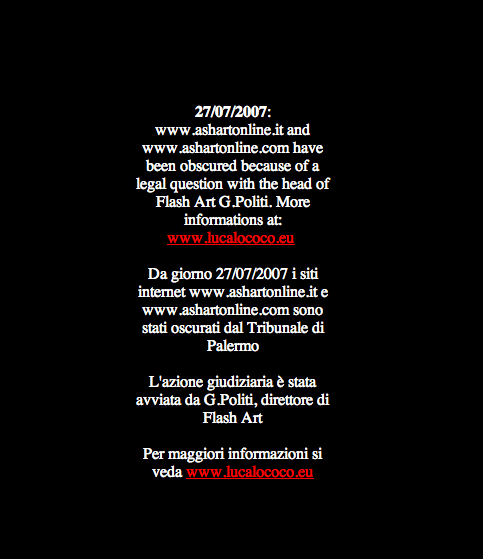
Now, some might contend that Politi, might not responsible for the cruel epilogue of this story, an extraordinary and strangely efficient move by the justice system, especially considering that the whole story takes place in Italy. Apparently, it was Politi who insisted that the confiscation went ahead as quickly as possible. This last bit adds even more outrage to this already absurd story, whose unfolding has already catalyzed a number of incendiary discussions on various Italian-based listservs and arts magazines [4]. In fact, to add insult to injury, the value of the furniture confiscated from Lo Coco falls short the amount he owes Politi. One wonders whether this is the end of the story or we should expect more surprises.
What makes this ordeal especially controversial and absurd is not the style Lo Coco used to splash his criticism on a website. It is the exaggerated reaction of the director of a respectable arts magazine who should have known better, but went all the way against an individual who was no particular threat to the publishing giant and who had no way to seek protection against his ire. At least a couple of reasons should have prevented Politi from keeping going at Lo Coco: first, if the precedents set by the egregious examples of 01001.org and the Yes Men may teach us anything, no counterattack has ever turned out to be the best reaction against spoofs and satires; second, as most of these examples have been recognized as forms of creative activism or as arts interventions, they should have been known to an arts publisher who claims to be knowledgeable on the emerging and most recent contemporary arts. Why this ridiculously ruthless reaction? Did Politi really fear (mistakenly) that Lo Coco website could constitute a threat to his magazine and its readership? Why didn’t he stop once he had obtained to have the website obfuscated? Did he think that letting a lone challenger have his way would have unleashed a whole horde of jackals just waiting for the right opportunity to disrupt his undisturbed realm? Was this an exemplar punishment?
Lo Coco, with his young age and, at the time Politi pressed charges, with a limited experience of the arts world as well as a almost non-existent network of allies to consult for mentorship and advice, was a really easy, too easy target. Thus, this action appears to be a rather gratuitous show off of power (both symbolic and material) towards someone who was virtually defenseless. Even more disturbing is the ludicrous amount of money that was asked from Lo Coco for the so-called damages caused to Flash Art. Politi’s move to silence (and of course defeat) Lo Coco using financial superiority is a trend that actually reveals the director’s personal view of where power resides, confirming exactly what Lo Coco wished to demonstrate with his website: power in the arts business is not measured on the basis of some cultural, or intellectual value and skills, but on money.
Second, Politi’s exaggerated reaction appeared to become gradually an act of intimidation directed to the whole independent arts community rather than a personal affair between him and Lo Coco. The latter, on the other hand, was the perfect scapegoat, the sacrificial lamb that would serve to re-affirm loudly and ostensively the power of BIG ART, authority, hierarchy, and institutions against the younger, subversive, independent emerging arts. The message sounds loud and clear: see what happens when you dare criticizing the powerful and dare not playing by the rules established by the Artsworld? This sounded like a warning to all young and independent artists, just in case they have the temptation in the future to challenge the existing power dynamics hierarchies. Had art star Maurizio Cattellan created something similar to Lo Coco’s, asks journalist Helga Marsala in an article dedicated to the episode, “…what would have happened? Clearly, no accusation, no lawsuit. On the contrary, Politi would have even dedicated a magazine cover to this work [5]”
Ultimately, what happened might have been a source of great (financial) discomfort to Lo Coco. He probably would have never thought that such dispute would be taken this far. However, the circumstances of this episode unleashed a great deal of solidarity and sympathy towards Lo Coco-David fighting against the taxidermized and conventional Politi-Goliath. Many individuals offered to get the voice out or to write notes and articles about this outrageous episode. This means that there exists a –somehow—unified network out there ready to take action when such crises ensue. In the long run then, this unexpected cohesion might cause more discomfort to Politi. He thought he would just get away with annihilating his enemy. However, if Lo Coco really bothered him, suing him might have just been the wrong move. In fact, If he had done his homework he would have probably known what happens when you try to defeat your adversary in this way: you might inadvertently create more publicity for him. This story has already given Lo Coco much more visibility and respect than he would have gotten, had he not being sued and humiliated in this way. In other words, this story has already put his name among those subversive artists who have no problem challenging the system. In addition, the same sudden emergency that cost Lo Coco his furniture and that initiated the just mentioned encouraging wave of support, also caused a great deal of thinking and brainstorming on how to react (creatively, of course) against Politi and other’s bold attack. Thus, we should all thank Politi for having given us an idea for future critical (and humorous) actions against his magazine and his arrogant attitude, as well as for having reinvigorated and definitely strengthened our network.
An Interview with Julian Oliver By Taina Bucher.
I met the Berlin-based media artist and programmer Julian Oliver in Toronto as part of the Subtle Technologies festival, where he taught a workshop on the Network as Material. The aim of the workshop reflects Oliver’s artistic and pedagogical philosophy nicely; to not only make people aware of the hidden technical infrastructures of everyday life but to also provide people with tools to interrogate these constructed and governed public spaces.
Julian Oliver, born in New Zealand (anyone who has seen him give a talk will know not to mistake him for an Australian) is not only an extremely well versed programmer but is increasingly as equally knowledgeable with computer hardware. His background is as diverse as the places he has lived and the journeys it has taken him on. Julian started out with architecture but became increasingly interested in electronic art after working as Stelarc’s assistant on ‘Ping Body’, Auckland,1996. He moved on to Melbourne, Australia, and worked as guest researcher at a Virtual Reality center. Later he established the artistic game-development collective Select Parks and in 2003 left for Gotland to work at the Interactive Institute of Sweden’s game lab. He then moved on to Madrid where he had extensive involvement with the Media Lab Prado. Several countries, projects and residencies later, he made Berlin his preferred base, setting up a studio there with colleagues. Julian is also an outspoken advocate of free software and thinks of his artistic practice not so much as art but more in terms of being a ‘critical engineer’, a term that he applies particularly to his collaborations with his studio partner Danja Vasiliev.
Their latest collaboration called Newstweek, was recently announced as winners of the Golden Nica in the Interactive art category of the Prix Ars Electronica 2011. The project leverages on the network as a medium for rigorous, creative investigation, exploring the intersection between the perceived trustworthiness of mass media and the conditions of networked insecurity.
His artistic practice clearly reflects his hacker and gaming background, playing around and messing with routers, capturing data from open wireless networks, visually augmenting commercial billboards in the cityscape, sonifying Facebook chats, visualizing protocols and otherwise manipulating networks for artistic purposes. I sat down with Julian on June 1st to talk about his most recent art projects, his reflections on software and digital media arts more generally. The interview was transcribed from a voice recording in a busy cafe to the best of my ability.
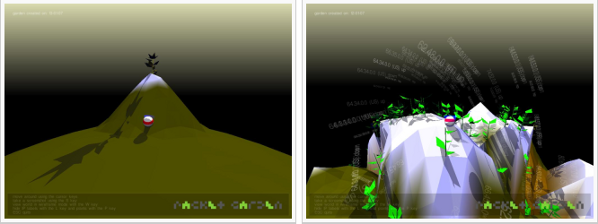
Taina Bucher: You started out with architecture and then moved over to games. How did that transition come about?
Julian Oliver: I realized quite early on that I was less interested in buildings than I was in exploring architecture in the context of the language within which it operates. I was more interested in hypothetical architecture. Like impossible structures such as what Buckminster Fuller proposed, and when I ended up working in a virtual reality centre in Melbourne I found that sitting behind a bunch of SGI machines dedicated to rendering virtual experiences, that I no longer really needed to invest in the idea to build something. I was more interested in something more plastic and mutable. The bridge from there to games came about around 1997-1998. Source code from games started to become available and it became apparent to me that it was possible to modify these games to explore an artistic practice, an architectural and sculptural practice really, using the medium of computer games. There were only 4-5 of us in the world working on this and we quickly made contact with each other. I left the VR centre and started an artistic game based modification lab in Melbourne called Select Parks. For about six years we did a whole bunch of projects based on computer games. We also established an online archive of the ever-increasing experiments and artistic investigations into computer game technology under selectparks.net. The archive is still there now.
TB: Was it the same interest in the mutability of the medium that led you to work with software more generally?
JO: I’ve been programming since I was pretty young and I’ve been around computers since I was a boy and working with them, but it was when I started to increase my freedom of movement with the medium of computer games that I became a programmer. I started to learn C, C++ and scripting languages and I quickly became hooked with the mix between technical challenges and rigorous creative exploration. I think the balance of the two still remains in my work.
TB: In one of your academic papers on games you ask the question of how much of the medium, as a raw field of possibilities, really is available to the artist. Well, let me ask you the same question in relation to software given that software always comes with a certain kind of aesthetic expectation.
JO: Definitely. I think it is a bit of a shame that much of what is called digital art is in fact made by using software suits built by large corporations. Macromedia, now the Adobe suite, is almost an infrastructure of the media arts. Painters of 200 years ago would never have accepted this brand attached to their canvas. They would never have accepted that their tools would be designed with such a generic mass audience in mind. I think that while the digital arts are certainly an exciting field there is an unadmitted dependency on a food chain that comes entirely from a corporation. The contemporary artist would then talk about breaking these tools, or you know, misusing them. But who is really holding the power? I think at a certain point for me, this was the reason why I moved entirely into free software. I really wanted to look at software as a core medium itself and I wanted to get at the guts of it. I wanted to have a rigorous personal relationship with technology so that I could bend it to my needs rather than my needs being bent.
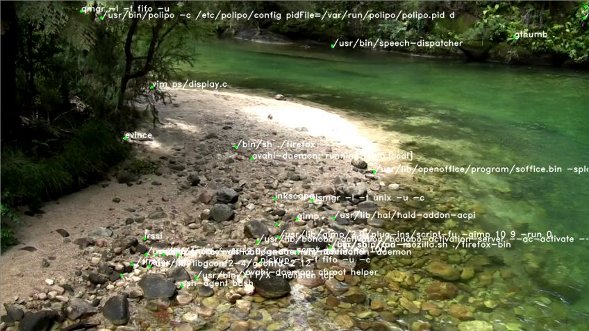
TB: How do you picture a genuinely critical media arts practice then, moving away from the Adobe suites of the world?
JO: No, I think it is fine to use Adobe if it satisfies your expectations. However I think that the expectations themselves are already defined by these external corporate market inputs. I think it is really important for digital artists to understand what digits are. They call themselves software artists but they do not really write software or know what it is. By using it their works become symptomatic of a process that they themselves have not defined.
TB: Does this mean we have to know code in order to be critical of code?
JO: Yes. I think you need to speak the language. It is the same thing with other cultural practices; you need to know the basics of how a violin or a guitar works before you can pass a judgement on the player. There is a parallel history to the new media arts that is not written and that’s all of those technical and cultural contributions that artists and technologists make when they are producing a work of new media. There is certainly a very well written history for the work of art in the galleries but there is nothing of the sorts for the fundaments of the technical achievements. I mean we have that with music for instance, with the evolution of the piano, but there are things happening in the new media arts all the time that no one other than the technologists can really appreciate. These are significant contributions that actually shape the way in which media are used in the future. This is certainly the case with the development of a new programming language that a historian might not necessarily notice. A language like Python or a framework like open frameworks has shifted media arts in such an influential way. Most people only see the end product. Understanding just a little in this regard is enough for enriching the history of the field I think.
TB: One could certainly argue that the ‘democratization of code’ with web 2.0 technologies and open APIs potentially lets anyone produce software art?
JO: Yes certainly. Take Processing for instance, anyone can make a digital square if they want. There is nothing inherently wrong with that. What I am interested in is to make people understand what’s behind it. I think we as artists need to describe what we do and part of this is to publish the source code. For me personally this is an obligation. By publishing the source code I am enriching the scene by allowing other people to have an insight into how it works. Take the project that Danja and I have been doing with Newstweek. If we would hide the way it works it would not enrich anything. We’d only be contributing to our own careers. We therefore publish all our code. You can download it now and already be learning how we did it and so together as a whole we move forward.
TB: Is code ever finished?
JO: That’s a really good question. Probably not. Someone could come along and improve what you think is finished. Every problem can be solved in a multitude of different ways. What constitutes being finished for one program might be elegance of expression. For another one it might be its performance. There are different value systems for programmers. Code in an open context, that is published openly, tends to be living or have the opportunity to live and be contributed to.
TB: You mentioned that most people do not know what software is, would you mind elaborating on that?
JO: Software in its simplest form is a group of instructions that work together somewhat contiguously to process data with an intended outcome. Data itself is everything that is not program code and program code itself is instructions written in a human readable language that are compiled into a form that the computer can understand. Computers have their own language; they are interpreters in a sense. You can really understand software as an automation of multitudinous processes to speed up the production of an intended or desirable outcome. Decision-making can occur, so it is not just a one-dimensional procedure. For the user though, software is generally just a skin of metaphors. If you think about it, clicking a picture becomes an initiation of an event and software is made to allow for the clicking of pictures to allow it to start a program. I mean software is many things at the same time, a field of illusions and metaphors.
TB: To what extent can you be taken by surprise by the software as an artistic medium given that it is your instructions?
JO: Well it depends on the scale of the project. Much of the time the software is a field of limitations. Working with software is about finding ways to make these limitations work and move within them. Unless you (of course) do something in Processing and you just want it to make a square then you just want the program to do exactly this. But for more complex projects I’d describe computer programming as a process of self-humiliation. It is about finding out how poor your initial assumptions about your own abilities are, you feel frustration and you need to fight against your own attention deficit disorder. It is a conversation with yourself, self-development ultimately. Secondly, it is a process of breaking down big problems into smaller ones until so much of the smaller problems are solved that the big one is solved too. But first and foremost I think that software development is self-development.
TB: Speaking of self-development. It is interesting to note that you have in a way returned to architecture, the difference being that you are not sculpting the physical space but the immaterial space. Maybe more so than building things one could say that you deconstruct them, take them apart through intervening and disrupting space.
JO: Yeah. Danja and I work together a lot these days and we refer to ourselves less as artists than as critical engineers. We firmly believe that the most transformative language of our time, one that defines whole economies, I mean how we trade, how and what we eat, how we converse with each other, how we move around the world is engineering. Art itself is increasingly diluted in transformative power, it has become more like entertainment than necessarily anything that is intrinsically rigorous. In the early days of the 1920s and 1930s we had interventionists’ strategies that are now known as art but they didn’t call themselves artists at the time. So as I have been saying to myself quite a lot recently it doesn’t matter if I call what I do art, others will do it for me anyway. So I better describe myself as a critical engineer by taking the language of engineering and lifting it out from a strictly utilitarian space and look at it as a language for rich, critical inquiry and really take on that challenge. It is really about taking the language of engineering and blowing it wide open, taking it away from this kind of black box reality, of big companies making stuff for civilians. This is essentially our relationship to technology. The companies and government make technologies upon which we depend and I think as any technology becomes more ubiquitous like smart phones our ignorance increases. With ubiquity comes ignorance and it seems to be a plottable, predictable curve. The idea of being a critical engineer is to intervene at this point and say “No! Stop!”. We need to reflect on what we are working with and how what we depend upon is shaping us. So learning this hard stuff in order to evade the top down superstructure is necessary.
TB: This might be a good transition to talking about Newstweek, a project that precisely seeks to evade the top down superstructure that you mentioned. How did this project that you’ve collaborated on with Danja Vasiliev come about?
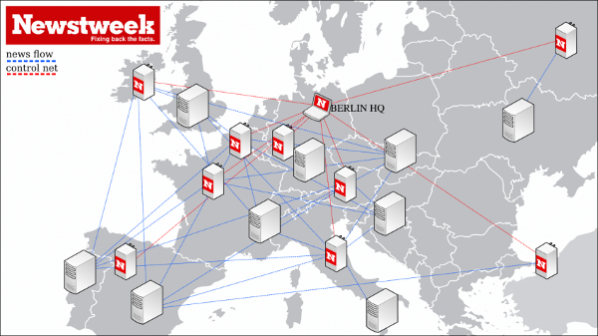
JO: We were at the Chaos Computer Club early this year and we put a little plug into the wall where we put a small router inside. Our goal was really simple, to go into the Berlin congress centre with thousands of hackers and put the thing into the wall and see how long it would last without anybody noticing. We expected it would last a few hours but it was there for the entire conference. One could see it from hundreds of meters away but nobody did something about it, so we realized we were onto something. So we wanted to build a device that looks so much like part of the infrastructure that it would appear harmless.
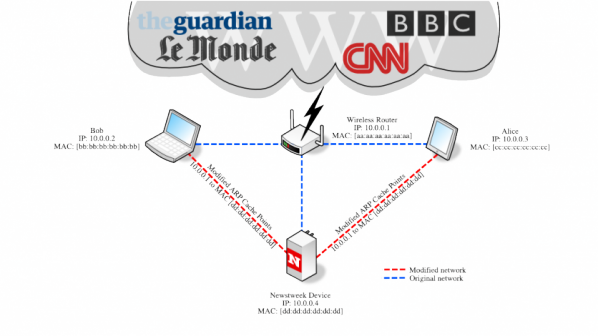
Newstweek: fixing the facts from newstweek on Vimeo.
The second thing was to couple it with a man-in-the-middle attack and to interrogate what we increasingly refer to as a browser-defined reality. Meaning that if it manifests in the browser, it is somehow authentic. It is this idea of going to a major news site, and as long as what one sees comes from this imaginary thing called a server and propagates in your browser, it is somehow trustworthy. We wanted to explore the limits of the impossibility of intervening in an otherwise top-down distribution of news. We wanted to find an on-the-ground way for civilians to intervene with this authority by manipulating the facts. It is really about allowing for a lateral interception of news sources, such as the BBC, the Guardian and CNN.
TB: Did you also record or document people’s reactions to their suddenly altered or tweaked news?
JO: Yeah, we have done this. The thing for us though was merely to provide a platform. People didn’t really believe that Newstweek worked. So we released the how-to saying here is where you buy the hardware, how you open it up, the firmware, the script, and so forth. Only then we had this quiet retrospect where people were going “aha”. What we have changed is their relationship with their environment. It doesn’t matter whether there has been a Newstweek-device in the environment or not. The very fact that they are looking around them and thinking that what is happening in their browser may have been tweaked is the most desirable outcome. This is exactly what happened. Most of the comments are of that nature, saying, “I will never trust the news again”. I mean, even when the attention for the project falls back to the sleepy town of acceptance, I think we can still be very proud of ourselves.
TB: Not just Newstweek, but much of your work is about intervening in public space and exploring the meaning of place. What do these concepts mean to you?
JO: Well I am very interested in the writings of Edward S Casey and the phenomenologist’s Husserl, Mearleau-Ponty and Heidegger of course. One of the great things that has come out of that thought is that Space in itself does not really exist, just as there is no number 2 in the universe. What we have done is to create a concept in order to pre-empt space, to reduce contingency, and in this way so much scientific thought is about reduction of contingency. Space of course is a projection of mathematical constituents to make determinations. Through mathematics and cartography and the like we have seen a growth in trust in the space model rather than the place model. So what I am really interest in, is that rationalization of place has allowed us to live in cities, which have been atomically and economically particularized, privatized. I am interested in how the distinctions between public and private is often extraordinarily blurry. A good example is the fact that a company can pay to put a huge picture outside your apartment during construction for instance yet when it is a millimetre or two away from your wall it no longer belongs to you. Or when you are drilling a hole through your wall in your house at a certain point you are going to hit the neighbours next door. Where does it begin and where does it end? It really shows that territory and place are just constructions. The same goes for wireless technology.
TB: Why is it important to question the ways in which we experience public space?
JO: Well take my work Artvertiser as an example. We have come to accept that our cities are covered in proprietary imagery. So I find it important to question this read-only space much in the line of ad busting and culture jamming. We just did a big streetwise exhibition in Helsinki where artists chose their brands and they made concise commentary simultaneously finding a new way of being in their city.
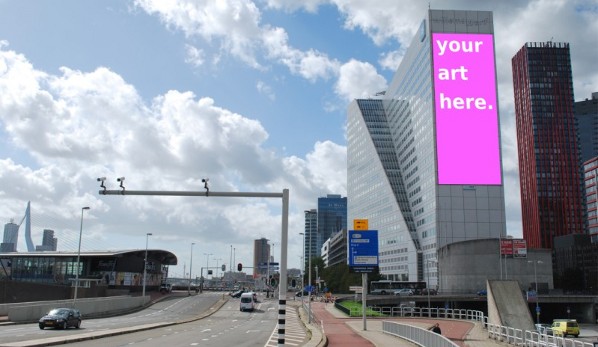
TB: Place often resides in memory and to a certain extent requires permanence. With Artvertiser it is only a temporary intervention. In the end the proprietary imagery stays. What do you hope people take away from an artwork like the Artvertiser?
JO: True. But again, the most productive outcome is conversation. We have the public coming up and looking again and again, through the binoculars at the modified billboards. We even had security guards getting angry. I mean all we are doing is producing a new experience in the visual cortex. Why would a member of the public like the security guard get angry that we are modifying our own experience voluntarily? It is kind of curious.
“At the dawn of the new millennium, Net users are developing a much more efficient and enjoyable way of working together: cyber-communism.” Richard Barbrook.
Dmytri Kleiner, author of The Telekommunist Manifesto, is a software developer who has been working on projects “that investigate the political economy of the Internet, and the ideal of workers’ self-organization of production as a form of class struggle.” Born in the USSR, Dmytri grew up in Toronto and now lives in Berlin. He is a founder of the Telekommunisten Collective, which provides Internet and telephone services, as well as undertakes artistic projects that explore the way communication technologies have social relations embedded within them, such as deadSwap (2009) and Thimbl (2010).
“Furtherfield recently received a hard copy of The Telekommunist Manifesto in the post. After reading the manifesto, it was obvious that it was pushing the debate further regarding networked, commons-based and collaborative endeavours. It is a call to action, challenging our social behaviours and how we work with property and the means of its production. Proposing alternative routes beyond the creative commons, and top-down forms of capitalism (networked and physical), with a Copyfarleft attitude and the Telekommunist’s own collective form of Venture Communism. Many digital art collectives are trying to find ways to maintain their ethical intentions in a world where so many are easily diverted by the powers that be, perhaps this conversation will offer some glimpse of how we can proceed with some sense of shared honour, in the maelstrom we call life…”
Marc Garrett: Why did you decide to create a hard copy of the Manifesto, and have it republished and distributed through the Institute of Networked Cultures, based in Amsterdam?
Dmytri Kleiner: Geert Lovink contacted me and offered to publish it, I accepted the offer. I find it quite convenient to read longer texts as physical copies.
MG: Who is the Manifesto written for?
DK: I consider my peers to be politically minded hackers and artists, especially artists whose work is engaged with technology and network cultures. Much of the themes and ideas in the Manifesto are derived from ongoing conversations in this community, and the Manifesto is a contribution to this dialogue.
MG: Since the Internet we have witnessed the rise of various networked communities who have explored individual and shared expressions. Many are linked, in opposition to the controlling mass systems put in place by corporations such as Facebook and MySpace. It is obvious that your shared venture critiques the hegemonies influencing our behaviours through the networked construct, via neoliberal appropriation, and its ever expansive surveillance strategies. In the Manifesto you say “In order to change society we must actively expand the scope of our commons, so that our independent communities of peers can be materially sustained and can resist the encroachments of capitalism.” What kind of alternatives do you see as ‘materially sustainable’?
DK: Currently none. Precisely because we only have immaterial wealth in common, and therefore the surplus value created as a result of the new platforms and relationships will always be captured by those who own scarce resources, either because they are physically scarce, or because they have been made scarce by laws such as those protecting patents and trademarks. To become sustainable, networked communities must possess a commons that includes the assets required for the material upkeep of themselves and their networks. Thus we must expand the scope of the commons to include such assets.
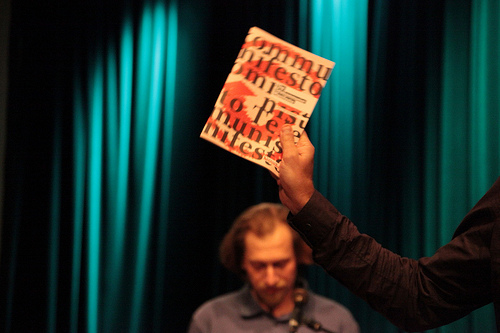
MG: The Manifesto re-opens the debate around the importance of class, and says “The condition of the working class in society is largely one of powerlessness and poverty; the condition of the working class on the Internet is no different.” Could you offer some examples of who this working class is using the Internet?
DK: I have a very classic notion of working class: Anyone whose livelihood depends on their continuing to work. Class is a relationship. Workers are a class who lack the independent means of production required for their own subsistence, and thus require wage, patronage or charity to survive.
MG: For personal and social reasons, I wish for the working class not to be simply presumed as marginalised or economically disadvantaged, but also engaged in situations of empowerment individually and collectively.
DK: Sure, the working class is a broad range of people. What they hold in common is a lack of significant ownership of productive assets. As a class, they are not able to accumulate surplus value. As you can see, there is little novelty in my notion of class.
MG: Engels reminded scholars of Marx after his death that, “All history must be studied afresh”[1]. Which working class individuals or groups do you see out there escaping from such classifications, in contemporary and networked culture?
DK: Individuals can always rise above their class. Many a dotCom founder have cashed-in with a multi-million-dollar “exit,” as have propertyless individuals in other fields. Broad class mobility has only gotten less likely. If you where born poor today you are less likely than ever to avoid dying poor, or avoid leaving your own children in poverty. That is the global condition.
I do not believe that class conditions can be escaped unless class is abolished. Even though it is possible to convince people that class conditions do not apply anymore by means of equivocation, and this is a common tactic of right wing political groups to degrade class consciousness. However, class conditions are a relationship. The power of classes varies over time, under differing historical conditions.
The condition of a class is the balance of its struggle against other classes. This balance is determined by its capacity for struggle. The commons is a component of our capacity, especially when it replaces assets we would otherwise have to pay Capitalist-owners for. If we can shift production from propriety productive assets to commons-based ones, we will also shift the balance of power among the classes, and thus will not escape, but rather change, our class conditions. But this shift is proportional to the economic value of the assets, thus this shift requires expanding the commons to include assets that have economic value, in other words, scarce assets that can capture rent.
MG: The Telekommunist Manifesto, proposes ‘Venture Communism’ as a new working model for peer production, saying that it “provides a structure for independent producers to share a common stock of productive assets, allowing forms of production formerly associated exclusively with the creation of immaterial value, such as free software, to be extended to the material sphere.” Apart from the obvious language of appropriation, from ‘Venture Capitalism’ to ‘Venture Communism’. How did this idea come about?
DK: The appropriation of the term is where it started.
The idea came about from the realization that everything we were doing in the free culture, free software & free networks communities was sustainable only when it served the interests of Capital, and thus didn’t have the emancipatory potential that myself and others saw in it. Capitalist financing meant that only capital could remain free, so free software was growing, but free culture was subject to a war on sharing and reuse, and free networks gave way to centralized platforms, censorship and surveillance. When I realized that this was due to the logic of profit capture, and precondition of Capital, I realized that an alternative was needed, a means of financing compatible with the emancipatory ideals that free communication held to me, a way of building communicative
infrastructure that was born and could remain free. I called this idea Venture Communism and set out to try to understand how it might work.
MG: An effective vehicle for the revolutionary workers’ struggle. There is also the proposition of a ‘Venture Commune’, as a firm. How would this work?
DK: The venture commune would work like a venture capital fund, financing commons-based ventures. The role of the commune is to allocate scarce property just like a network distributes immaterial property. It acquires funds by issuing securitized debt, like bonds, and acquires productive assets, making them available for rent to the enterprises it owns. The workers of the enterprises are themselves owners of the commune, and the collected rent is split evenly among them, this is in addition to whatever remuneration they receive for work with the enterprises.
This is just a sketch, and I don’t claim that the Venture Communist model is finished, or that even the ideas that I have about it now are final, it is an ongoing project and to the degree that it has any future, it will certainly evolve as it encounters reality, not to mention other people’s ideas and innovations.
The central point is that such a model is needed, the implementation details that I propose are… well, proposals.
MG: So, with the combination of free software, free code, Copyleft and Copyfarleft licenses, through peer production, does the collective or co-operative have ownership, like shares in a company?
DK: The model I currently support is that a commune owns many enterprises, each independent, so the commune would own 100% of the shares in each enterprise. The workers of the enterprises would themselves own the commune, so there would be shares in the commune, and each owner would have exactly one.
MG: In the Manifesto, there is a section titled ‘THE CREATIVE ANTI-COMMONS’, where the Creative Commons is discussed as an anti-commons, peddling a “capitalist logic of privatization under a deliberately misleading name.” To many, this is a controversy touching the very nature of many networked behaviours, whether they be liberal or radical minded. I am intrigued by the use of the word ‘privatization’. Many (including myself) assume it to mean a process whereby a non-profit organization is changed into a private venture, usually by governments, adding extra revenue to their own national budget through the dismantling of commonly used public services. Would you say that the Creative Commons, is acting in the same way but as an Internet based, networked corporation?
DK: As significant parts of the Manifesto is a remix of my previous texts, this phrase originally comes from the longer article “COPYRIGHT, COPYLEFT AND THE CREATIVE ANTI-COMMONS,” written by me and Joanne Richardson under the name “Ana Nimus”:
http://subsol.c3.hu/subsol_2/contributors0/nimustext.html
What we mean here is that the creative “commons” is privatized because the copyright is retained by the author, and only (in most cases) offered to the community under non-commercial terms. The original author has special rights while commons users have limited rights, specifically limited in such a way as to eliminate any possibility for them to make a living by employing this work. Thus these are not commons works, but rather private works. Only the original author has the right to employ the work commercially.
All previous conceptions of an intellectual or cultural commons, including anti-copyright and pre-copyright culture as well as the principles of free software movement where predicated on the concept of not allowing special rights for an original author, but rather insisting on the right for all to use and reuse in common. The non-commercial licenses represent a privatization of the idea of the commons and a reintroduction of the concept of a uniquely original artist with special private rights.
Further, as I consider all expressions to be extensions of previous perceptions, the “original” ideas that rights are being claimed on in this way are not original, but rather appropriated by the rights-claimed made by creative-commons licensers. More than just privatizing the concept and composition of the modern cultural commons, by asserting a unique author, the creative commons colonizes our common culture by asserting unique authorship over a growing body of works, actually expanding the scope of private culture rather than commons culture.
MG: So, this now brings us to Thimbl, a free, open source, distributed micro-blogging platform, which as you say is “similar to Twitter or identi.ca. However, Thimbl is a specialized web-based client for a User Information protocol called Finger. The Finger Protocol was orginally developed in the 1970s, and as such, is already supported by all existing server platforms.” Why create Thimbl? What kind of individuals and groups do you expect to use it, and how?
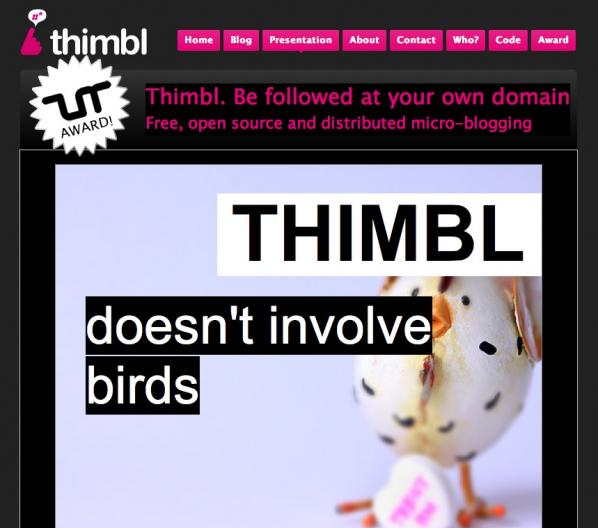
DK: First and foremost Thimbl is an artwork.
A central theme of Telekommunisten is that Capital will not fund free, distributed platforms, and instead funds centralized, privately owned platforms. Thimbl is in part a parody of supposedly innovative new technologies like twitter. By creating a twitter-like platform using Finger, Thimbl demonstrates that “status updates” where part of network culture back to the 1970s, and thus multimillion-dollar capital investment and massive central data centers are not required to enable such forms of communication, but rather are required to centrally control and profit from them.
MG: In a collaborative essay with Brian Wyrick, published on Mute Magazine ‘InfoEnclosure-2.0’, you both say “The mission of Web 2.0 is to destroy the P2P aspect of the Internet. To make you, your computer, and your Internet connection dependent on connecting to a centralised service that controls your ability to communicate. Web 2.0 is the ruin of free, peer-to-peer systems and the return of monolithic ‘online services’.”[2] Is Thimbl an example of the type of platform that will help to free-up things, in respect of domination by Web 2.0 corporations?
DK: Yes, Thimbl is not only a parody, it suggests a viable way forward, extending classic Internet platforms instead of engineering overly complex “full-stack” web applications. However, we also comment on why this road is not more commonly taken, because “The most significant challenge is not technical, it is political.” Our ability to sustain ourselves as developers requires us to serve our employers, who are more often than not funded by Capital and therefore are primarily interested in controlling user data and interaction, since delivering such control is a precondition of receiving capital in the first place.
If Thimbl is to become a viable platform, it will need to be adopted by a large community. Our small collective can only take the project so far. We are happy to advise any who are interested in how to join in. http://thimbl.tk is our own thimbl instance, it “knows” about most users I would imagine, since I personally follow all existing Thimbl users, as far as I know, thus you can see the state of the thimblsphere in the global timeline.
Even if the development of a platform like Thimbl is not terribly significant (with so much to accomplish so quickly), the value of a social platform is the of course derived from the size of it’s user base, thus organizations with more reach than Telekommunisten will need to adopt the platform and contribute to it for it to transcend being an artwork to being a platform.
Of course, as the website says “the idea of Thimbl is more important than Thimbl itself,” we would be equally happy if another free, open platform extending classic Internet protocols where to emerge, people have suggested employing smtp/nntp, xmmp or even http/WebDav instead of finger, and there are certain advantages and disadvantages to each approach. Our interest is the development of a free, open platform, however it works, and Thimbl is an artistic, technical and conceptual contribution to this undertaking.
MG: Another project is the Telekommunisten Facebook page, you have nearly 3000 fans on there. It highlights the complexity and contradictions many independents are faced with. It feels as though the Internet is now controlled by a series of main hubs; similar to a neighbourhood being dominated by massive superstores, whilst smaller independent shops and areas are pushed aside. With this in mind, how do you deal with these contradictions?
DK: I avoided using Facebook and similar for quite some time, sticking to email, usenet, and irc as I have since the 90s. When I co-authored InfoEnclosure 2.0, I was still not a user of these platforms. However it became more and more evident that not only where people adopting these platforms, but that they were developing a preference for receiving information on them, they would rather be contacted there than by way of email, for instance. Posting stuff of Facebook engaged them, while receiving email for many people has become a bother. The reasons for this are themselves interesting, and begin with the fact that millions where being spent by Capitalists to improve the usability of these platforms, while the classic Internet platforms were more or less left as they were in the 90s. Also, many people are using social media that never had been participants in the sorts of mailing lists, usenet groups, etc that I was accustomed to using to share information.
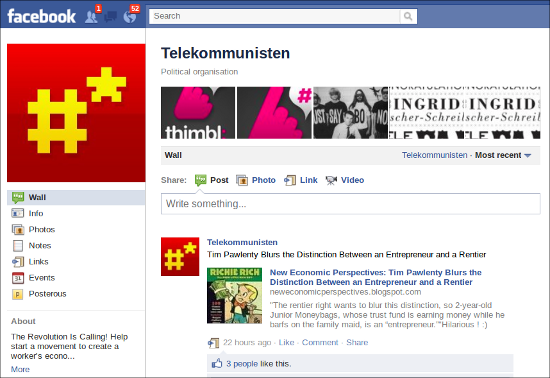
If I wanted to reach people and share information, I needed to do so on the technologies that others are using, which are not necessarily the ones I would prefer they use.
My criticism of Facebook and other sites is not they are not useful, it is rather that they are private, centralized, proprietary platforms. Also, simply abstaining from Facebook in the name of my own media purity is not something that I’m interested in, I don’t see capitalism as a consumer choice, I’m more interested in the condition of the masses, than my own consumer correctness. In the end it’s clear that criticizing platforms like Facebook today means using those platforms. Thus, I became a user and set up the Telekommunisten page. Unsurprisingly, it’s been quite successful for us, and reaches a lot more people than our other channels, such as our websites, mailing lists, etc. Hopefully it will also help us promote new decentralized channels as well, as they become viable.
MG: So, I downloaded deadSwap (http://deadSwap.net) which I intend to explore and use. On the site it says “The Internet is dead. In order to evade the flying monkeys of capitalist control, peer communication can only abandon the Internet for the dark alleys of covert operations. Peer-to-peer is now driven offline and can only survive in clandestine cells.” Could you explain the project? And are people using it as we speak?
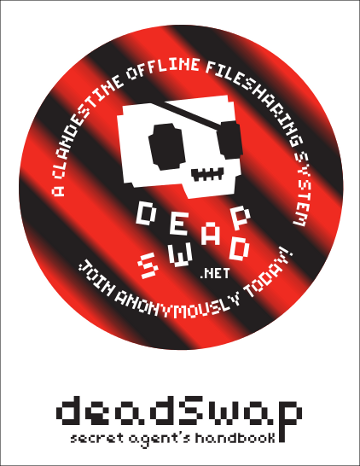
DK: I have no idea if people are using it, I am currently not running a network.
Like thimbl, deadSwap is an artwork. Unlike thimbl, which has the seeds of a viable platform within it, deadSwap is pure parody.
It was developed for the 2009 Sousveillance Conference, The Art of Inverse Surveillance, at Aarhus University. deadSwap is a distopian urban game where participants play secret agents sharing information on usb memory sticks by hiding them in secret locations or otherwise covertly exchanging them, communicating through an anonymizing SMS gateway. It is a parody of the “hacker elite” reaction to Internet enclosure, the promotion of the idea that new covert technologies will defeat attempts to censor the Internet, and we can simply outsmart and outmaneuver those who own and control our communications systems with clandestine technologies. This approach often rejects any class analysis out-of-hand, firmly believing in the power of us hackers to overcome state and corporate repressions. Though very simple in principal, deadSwap is actually very hard to use, as the handbook says “The success of the network depends on the competence and diligence of the participants” and “Becoming a super-spy isn’t easy.”
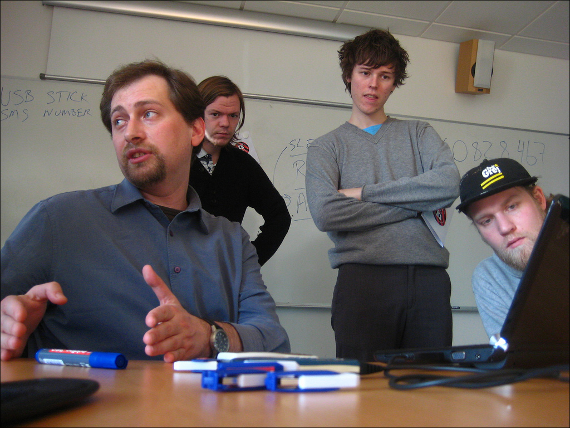
MG: What other services/platforms/projects does the Telekommunisten collective offer the explorative and imaginative, social hacker to join and collaborate with?
DK: We provide hosting services which are used by individuals and small organizations, especially by artists, http://trick.ca, electronic newsletter hosting (http://www.freshsent.info) and a long distance calling service (http://www.dialstation.com). We can often be found on IRC in#telnik in freenode. Thimbl will probably be a major focus for us, and anybody that wants to join the project is more than welcome, we have a community board to co-ordinate this which can be found here: http://www.thimbl.net/community.html
For those that want to follow my personal updates but don’t want don’t use any social media, most of my updates also go here: http://dmytri.info
Thank you for a fascintaing conversation Dmytri,
Thank you Marc 🙂
=============================<snip>
Top Quote: THE::CYBER.COM/MUNIST::MANIFESTO by Richard Barbrook. http://www.imaginaryfutures.net/2007/04/18/by-richard-barbrook/
The Foundation for P2P Alternatives proposes to be a meeting place for those who can broadly agree with the following propositions, which are also argued in the essay or book in progress, P2P and Human Evolution. http://blog.p2pfoundation.net
In the essay ‘Imagine there is no copyright and no cultural conglomerates too…” by Joost Smiers and Marieke van Schijndel, they say “Once a work has appeared or been played, then we should have the right to change it, in other words to respond, to remix, and not only so many years after the event that the copyright has expired. The democratic debate, including on the cutting edge of artistic forms of expression, should take place here and now and not once it has lost it relevance.”
Issue no. 4 Joost Smiers & Marieke van Schijndel, Imagine there are is no copyright and no cultural conglomorates too… Better for artists, diversity and the economy / an essay. colophon: Authors: Joost Smiers and Marieke van Schijndel, Translation from Dutch: Rosalind Buck, Design: Katja van Stiphout. Printer: ‘Print on Demand’. Publisher: Institute of Network Cultures, Amsterdam 2009. ISBN: 978-90-78146-09-4.
http://networkcultures.org/wpmu/theoryondemand/titles/no04-imagine-there-are-is-no-copyright-and-no-cultural-conglomorates-too/
TO BOOK YOUR PLACE NOW please email ale[at]furtherfield[dot]org
Over the last decade the awareness of anthropogenic climate change has emerged in parallel with global digital communication networks. In the context of environmental and economic collapse people around the world are seeking alternative visions of prosperity and sustainable ways of living.
While the legacy of the carbon fuelled Industrial Revolution plays itself out, we find ourselves grappling with questions about the future implications of fast-evolving global digital infrastructure. By their very nature the new tools, networks and behaviours of productivity, exchange and cooperation between humans and machines grow and develop at an accelerated rate.
The ideas for this transdisciplinary panel have grown out of Furtherfield’s Media Art Ecologies programme and will explore the impact of digital culture on climate change, developing themes adopted in grass-roots, emerging and established practices in art, design and science. The discussion will inform a second event in September at ISEA 2011 where we will be joined by artists Tom Corby and Helen Varley Jamieson.
Chair: John Hartley
Speakers: –
Michel Bauwens – On how Peer to Peer thought and technology point towards alternative production methods and a sustainable future.
Catherine Bottrill – On working with producers and consumers to consider the environmental long-tail of digital culture.
Ruth Catlow – On ecological approaches to tools, networks and behaviours in a digital art community.
Who this is for: any interested members of the public, cross-disciplinary (science, art, technology) practitioners, academics, students, researchers with an interest in digital culture, technology, sustainability.
Where: CREAM (Centre for Research in Education Art and Media), University of Westminster
Building: 309 Regent Street Campus
Room: RS 152 Cayley Room
Date/ Time: Friday May 13, 2011 from 6:00pm to 8:00pm
Maximum Seats: 60
Catherine Bottrill – Associate Director, Research Julie’s Bicycle
Catherine’s PhD research at the University of Surrey is studying the response of the UK Music Industry to climate change. The research is examining the efforts of the industry to organise itself to collectively take action to reduce greenhouse gas emissions. The study is exploring the possible opportunities, limitations and contradictions for the industry to support a cultural shift towards sustainable energy lifestyles. The research investigates the perspectives of music businesses, artists and audience.
Michel Bauwens – Founder of The Foundation for Peer 2 Peer Alternatives
Michel works in collaboration with a global group of researchers in the exploration of peer production, governance, and property. He has been an analyst for the United States Information Agency, knowledge manager for British Petroleum (where he created one of the first virtual information centers), eBusiness Strategy Manager for Belgacom, as well as an internet entrepreneur in his home country of Belgium.
Ruth Catlow – Co-founder and Co-director of Furtherfield
Ruth is an artist, curator and educator. As co-founder and co-director of Furtherfield.org a grass roots media arts organisation and its gallery (formerly HTTP) in North London, she works at the intersection of art, technology and social change with artists, curators, musicians, programmers, writers, activists and thinkers from around the world. She is currently developing the artistic programme and organisational infrastructure with a focus on Media Art Ecologies, aspiring to engender shared visions and infrastructures for other possible worlds. Ruth is Course manager for digital art and design degrees at Writtle School of Design, where she is currently developing a new BA and MA in Fine Art and Environment.
John Hartley – Art and Ecology Strategist
In his recent role as Arts Council England’s Arts and Ecology Strategy Officer, John supported the development of practice and infrastructure in the face of changing contexts. Also on the Arts Council’s Arts and Ecology partnership with RSA, on the GLA steering group for Greening London’s Theatres and the DCMS Climate Change Project. John led on developing ACE’s self-assessment toolkit to help arts organizations implement effective energy management programs. Implementation of the program can reduce energy usage and carbon emissions, potentially reducing energy costs by up to 20%. He is now a free-lance consultant, also a practicing artist, directs a collaborative experimental music group and has co-written a book published by Transworld.
Re-rooting digital culture is part of Furtherfield’s Media Art Ecologies Programme. This unconference event is partnered by CREAM (Centre for Research in Education Art and Media)
The four day event at the Showroom collated a series of practitioners, artists, theorists and historians, to examine, test and explore ideas stemming from cybernetics and information theory and more specifically the idea of feedback.
Described as an ‘experimental cross-disciplinary research project’, Signal : Noise was a fusion of talks, lectures, performances, screenings and debates that made diverse contemporary evaluations of the legacy of cybernetics using an inter-disciplinary approach. It tackled subjects as seemingly diverse as economic theory; urbanism and the arrival of the motor car in London; game theory; linguistics; media-performance art from the 1970’s; and the problematic legacies of the recent UK arts funding system on artists – all viewed using the concepts and terminologies of cybernetics and systems.
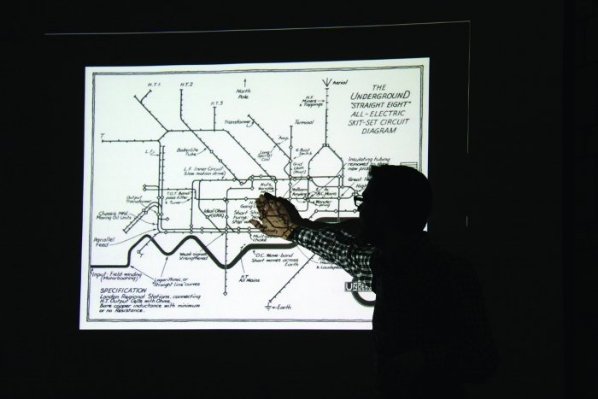
Signal : Noise, in part, played out like a small conference, mainly set in The Showroom Gallery space with one wall covered with a network diagram drawing by Stephen Willats, and fly posted theoretical systems diagrams from his recently re-published 1973 book, or maybe manual, ‘The Artist as Instigator of Changes in Social Cognition and Behaviour’.
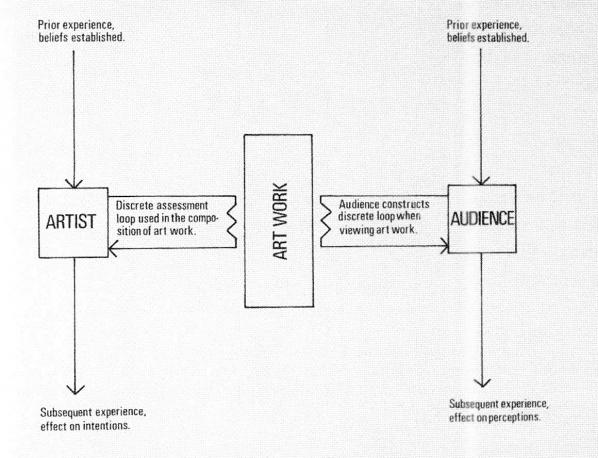
This visual reference served as a backdrop to the proceedings and served as an on going reminder that despite the deep theoretical and historical base being presented and discussed in its many forms, Signal : Noise was ultimately attempting to re ignite debates, and help reset the ideas of cybernetics and systems into a contemporary context of practical application. Willats’ book describes his process as an ‘investigation by the artist into the processes, procedures and models’ of the ‘Art Environment’ using ‘cybernetics as a research tool’.
The first night introductory presentations by Charlie Gere and Steve Rushton provided an overview of many ideas explored throughout the weekend. Artist and writer Steve Rushton on ‘How Media Masters Reality’ used an array of examples, from conceptual and media architecture group Ant Farm using pioneering ideas of investigating media feedback, through to the 500 millions votes (!) on US TV programme American Idol; the latter an example of how contemporary applications of media feedback loops are now often conceptually embedded into the core of television productions, and in turn, are now part of the audiences expectations and involvement.
Ant Farm’s 1975 work ‘The Eternal Frame’, screened later during the weekend, along with Gary Hill’s Why Do Things Always Get in a Muddle (Come on Petunia), based on Gregory Bateson’s Metalogues.
Ant Farm’s 1975 work ‘The Eternal Frame’, screened later during the weekend, was their carefully staged, somewhat trashy live ‘re enactment’ of the 8mm film footage of the Kennedy assassination, complete with a drag version of Jackie Kennedy and sunglass wearing suited security. This film sequence is familiar today, but in 1975 it had yet to reach the public domain. Working to a tightly choreographed moment derived from a bootleg of the 29 seconds of 8mm film, Ant Farm’s grotesque mimicry of the assassination was performed as an ongoing loop, complete with car driving around the block (interestingly, the random people watching in the street in 1975 took photographs like they were at a theme park).
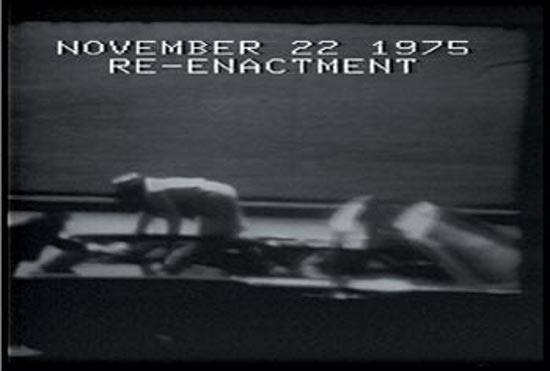

Despite being conceived in the mid ‘70s media environment of portable video and cassettes, the documentation of Ant Farm’s performance resonated with something surprisingly familiar and contemporary in our era of the internet, social media and rolling 24 hour news, and what Rushton termed our “society of self performance”.
Rushton’s historical threads from the origins of Cybernetics and to the Whole Earth Catalogue and the WELL served as a excellent base for the oncoming proceedings of the weekend, and showed that the arrival of the contemporary mass information network in the form of the internet, has habituated it’s millions of users into a kind of cybernetic practice based on input, observation, control, intervention, response, feedback, and adaptation but without necessarily using or being aware of its lexicon.
Nearby, in the Cockpit Theatre, was ‘Closed Circuit’ a performative work by Rod Dickinson (along with Rushton), which consisted of two actors staged and dressed, in a precise duplication of a set for political announcements; wooden lecterns, curtained background, complete with an array of flags – but all carefully neutralized by the removal of logos and national flags identities into plain white.
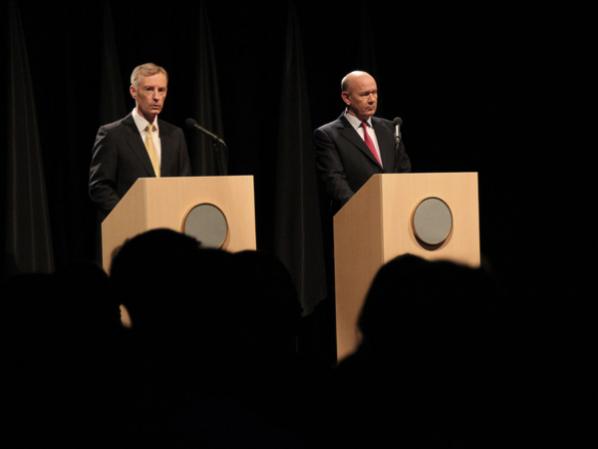
What followed was a series of political speeches utilizing the familiar language and tone of grandeur and crisis, delivered by the actors in the style of a world leader address. What they delivered, was a carefully sequenced remixed script derived from political speeches over the past 50 years; Margaret Thatcher; Richard Nixon; Ronald Reagan; Tony Blair; Yasser Arafat and others. All the details from each specific event they were referring to had been carefully edited out. The only way to differentiate one world leader, country or event from another, were the large projected auto cues for the actors, situated behind the audience at the rear of the theatre. Each one gave the full scrolling speech text and also the year and original context for each leaders’ delivery. Looking towards the stage, it sounded like a single coherent speech, but eluding any specific meaning, isolating the language of threat and authoritarian political control, leaving us just the husk of political presentation and the transparency of the format itself.
Ideas explored in Stephen Willats’ network drawing were expanded further during his talk in the final morning session of Signal : Noise, where he gave a refreshing clarion call to abandon ‘last century thinking’ during his prescient and timely discussion. His seminal works have persistently and methodically challenged the process, structure and meaning of art making and display. Willats made his earliest system diagrams in the late 1950’s, and was the first artist to make the artwork itself a map of communication. But maybe it is this century, rather than our last, that will connect with his provocations to the hierarchical, highly codified, object obsessed ‘Art Environment’, as he terms it, to see that ‘object based thinking is still a hangover from last century attitudes’.
Willats was an early reference for emerging net art and media art in the mid 90’s, with artists then clutching for any art historical roots that gave the field of networked and computer based practice some practical grounding.
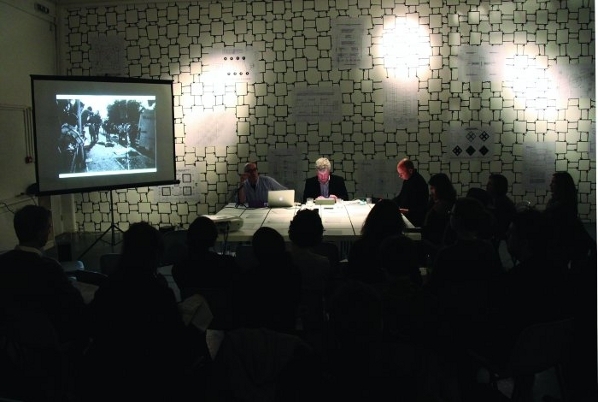
This in-conversation with Emily Pethick surveyed his own personal development and immersion in Cybernetics in its differing stages, a short history lesson, moving from Norbert Weiner to Gregory Bateson and Gordon Pask, but always resolutely en route to the practical issues in the present and what Willats defines as the artist as an ‘instigator of transformation’.
In parallel to Willats, was a presentation and discussion hosted by Emma Smith and Sophie Hope which began to interrogate the legacy of a the New Labour arts commissioning process. It discussed how the criteria for successful funding was intrinsically linked to a social agenda, audience and location set by government policy. Discussions followed about how the arts commissioning process may turn out to have skewed a generation of artists practice, as they slowly lost control of their own output, became tagged with being an ‘artist facilitator’, and began conceiving works to fit in with the criteria of funding bodies, with each funder slowly extending their own prospective reaches. All this supported by an immense drive to build ‘Cultural Industries’ into mechanisms for regeneration.
Seeing this placed against Willats, whose ongoing practice could initially seem in tune with the past decades cultural policies and its overtly prescribed socially engaged agenda, in fact served to show how contrasting, distinct and rich his rigourous thoughtful approach is by comparison.
All this made for a timely discussion. With the approaching withdrawal and decimation of arts funding in the UK, Signal : Noise could prove to be a prescient event. With presentations, workshops and panels by Stuart Bailey and David Reinfurt of Dexter Sinister, Charlie Gere, Matthew Fuller, Marina Vishmidt and others, the interdisciplinary approach of Signal : Noise worked well despite its fairly dense timetable.
Using the gallery as a discursive space, with theorists and writers set within context of practice, is a good base for the next event in this on going series. What it maybe didn’t allow for, which is easily rectified, is a more unpredictable agenda, and more intervention by the ‘audience’. The whole event could function more as a real feedback working system, an adaptable structure that potentially allows for input from its participants (both presenters and audience) letting things move in unexpected directions both on line and offline, leaving a physicalised network as a residue after the event. With the decision to include food and beer in the ticket price (great dumplings, fresh vegetables and miso soup), there is potential here to expand this type of event even further.
With the on coming cultural landscape in the UK moving into un-chartered territory, it is potentially events like Signal : Noise which might begin to unearth and test new ideas and ignite debate within a less rigid format than a ‘curated’ show. In the future this type of event may even re-claim the word ‘radicalise’ from its current narrow, negative media usage, and re-purpose it for artists who decide to reject art market values, in favour of a exploring new ways of working within the emerging (and significantly less funded) ‘Art Environment’.
Signal : Noise. The project was led by Steve Rushton, Dexter Sinister (David Reinfurt and Stuart Bailey), Marina Vishmidt, Rod Dickinson and Emily Pethick. http://www.theshowroom.org/research.html?id=161&mi=254
The Artist as an Instigator of Changes in Social Cognition and Behaviour. 1973. Stephen Willats. http://www.occasionalpapers.org/?page_id=825
Closed Circuit, Rod Dickinson in collaboration with Steve Rushton.
http://www.roddickinson.net/pages/closedcircuit/project-synopsis.php
Dr Charlie Gere. Reader in New Media Research. Department: Lancaster Institute for the Contemporary Arts. http://www.lancs.ac.uk/fass/faculty/profiles/charlie-gere
ANT FARM. ART/ARCHTECTURE/MEDIA [1968-1978]. http://artsites.ucsc.edu/faculty/lord/AntFarm.html
The Eternal Frame by T.R. Uthco and Ant Farm: Doug Hall, Chip Lord, Doug Michels, Jody Procter. 1975, 23:50 min, b&w and color, sound. http://arttorrents.blogspot.com/2008/02/ant-farm-eternal-frame-1976.html
Emma Smith. Social practice that is both research and production based and responds to site-specific issues. http://www.emma-smith.com/www.emma-smith.com/Homeindex.ext.html
Sophie Hope’s work inspects the uncertain relationships between art and society. http://www.welcomebb.org.uk/aboutSophie.html
In 2002, when Monochrom was invited to act as the representative of Austria at the Sao Paulo Biennial, instead of going as yourselves, you sent Georg Paul Thomann, one of the country’s most prominent avant guard artists, and also a complete fabrication.
Yes, we were asked to represent the Republic of Austria at the Sao Paulo Art Biennial, Sao Paulo (Brazil) in 2002. However, the political climate in Austria (at that time, the center-right People’s Party had recently formed a coalition with Jorg Haider’s radical-right Austrian Freedom Party) gave us concerns about acting as wholehearted representatives of our bloody nation. We dealt with the conundrum by creating the persona of Georg P. Thomann, an irascible, controversial (and completely fictitious) artist of longstanding fame and renown. Through the implementation of this ironic mechanism – even the catalogue included the biography of the non-existent artist – we tried to solve with pure fiction the philosophical and bureaucratic dilemma attached to the system of representation.
It gave me something of a hearty guffaw to hear about how you and your fellows, manning the Austria country booth as the artist’s technical support staff – the lowliest of low in the art world hierarchy – went about revealing the fictitious nature of the artist.
Yes, we turned the tables. When members of the administration, journalists, or curators asked about the whereabouts of Thomann, our irritated answer was that he hadn’t cared to show up so far, and that he hadn’t helped with anything, because he was supposedly watching porn in his hotel room all day, while we – the members of his technical crew – didn’t care about that bullshit at all. But we informed other technical support teams about the basic idea of the project. They were also given detailed information about Thomann’s non-existence but we did not give them any hierarchic directives about what to do with their knowledge but left it up to them if they wanted to reveal the fake or keep spinning the story. Most people enjoyed doing the latter and they also kept telling different versions of the heard information until finally a bubbling geyser kept erupting in various ways and constantly led to new outbreaks of tittle-tattle.
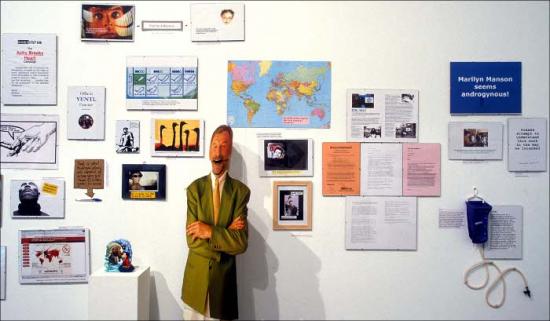
What happened next, as I heard you describe it, was that “bubbles and bubbles of rumors” began to form around the expansive floor of the biennial. I found this moment in the arc of the project to be particularly interesting and was hoping you could perhaps share some of your thoughts and recollections.
Let’s give you a brief summary of the background. The basic principles of an art-super-structure like a Biennial is simple: lots of little white boxes in which art was set up – and little artists, spreading business cards like prayers. There is a nice German term: “die Warenformigkeit des Kunstlers” (“the commodity value of the artist”). We hardly had any contact with other artists… and that was bad. They came from more than 80 different countries, but they were hiding in their white boxes. Everyone was busy building his or her own little world. Then, during the final setup phase we found out about an incident, which took place in our neighborhood through a copied note.
One year before the Biennial, Chien-Chi Chang had been invited to be the official representative of Taiwan at the Biennial. But then, three days before the opening, his caption – adhesive letters – had been removed from his cube virtually over night. ‘Taiwan’ was replaced with ‘Museum of Fine Arts Taipeh.’ But to Chien-Chi Chang the status as an official representative of Taiwan was very important, because his photography artwork dealt directly with the inhumane psychiatric system in Taiwan.

Chien-Chi was trying to get in contact with the Biennial administration and the chief curator (the German Alfons Hug), but didn’t succeed. Communication was refused. After that he decided to write an open letter, but the creative inhabitants of all the little white art-combs didn’t seem too interested in the artist’s chagrin, who by now wanted to leave the Biennial out of protest.
We were interested in the situation and did some research. We found out that the Chinese delegation had threatened to withdraw their contribution and to cause massive diplomatic problems. To them, Taiwan was clearly not an independent country (c/f ‘One China Policy’) and they put pressure on the Biennial management to get that message out. The management did not make this international scandal public and it was quite obvious why.
monochrom decided to show solidarity with Chien-Chi. We wanted to set an example and show that artists do not necessarily have to internalize the fragmentation and isolation that is being imposed upon them by the structure of the art market, the exhibition business, as well as the economy containing them. For us, though, this is not about taking a stand for either the westernized-economical imperialism represented by Taiwan or for China’s old-school Stalinist imperialism. This is about integrity and solidarity, values that we chose to express through a collaborative act. Together with other artists from various countries we launched a solidarity campaign: we took off some adhesive letters of each collaborating country’s signature and donated them to Chien-Chi Chang. monochrom sponsored the ‘t’ of Austria, while the Canadians donated one of their three as. The other participating artists were from Croatia, Singapore, Puerto Rico and Panama. A lot of artists and curators from other countries refused to support the campaign for fear of – as they would call it – “negative consequences.” WTF? But at least some of the artists were pulled out of their self-referential and insular national representation cubes which, in themselves, so rigorously symbolized the artists’ work and his or her persona as commodities.

After some time we managed to attach a trashy, yet legible ‘Taiwan’ to the outside wall of Chien-Chi Chan’s cube. Numerous journalists took notice of the campaign and Chien-Chi opened his exhibition in front of a cheering audience. Some days later, we found out that Chinese and Taiwanese newspapers massively covered the campaign. One Taiwanese paper used the headline “Austrian artist Georg Paul Thomann saves ‘Taiwan’.” In other words, a non-existing artist saved a country pressed into non-visibility. Who said that postmodernism can’t be radical?
What was it like – even from a kind of phenomenological sense – to be in the midst of this bubbling, to experience the formation of a scandal from its very embryonic moments? Is there something in the interiority of situations like this that you see as essential to the creation of new kinds of solidarity?
First we would have to define what “new kinds of solidarity” mean. What would be the ‘new’ part of it? Does it go beyond old and traditional forms of solidarity? And why should it? I think that classic forms of solidarity were carried out by political groups or other collective entities. They tried to express their (let’s label it as) “old-school solidarity” by pointing their collective fingers at someone who they thought were mistreated: “Look, look this human being is being oppressed!” And they always did it “in the name of something”. Old-school solidarity was one more frickin’ medium that people used to get a message across. Thus it was always part of the realm of representation. Your act of solidarity represents the one you show solidarity with, but your act is also advertisement for yourself, your cause and the (political) identity you wish to construct. Politics is always drama. Best example for this would be the “supporters of Palestine”. There are tons of ethnic groups on this rusty little planet who have to suffer under worse conditions. But nobody seems to be interested in showing solidarity with them. Where are Henning Mankell and Noam Chomsky when you really need them? Involved in some stupid fast-food anti-imperialism. We have to understand that the “object of solidarity” is something you pick for a reason… and most of the time it’s to feel good as a group and to impress your peers. But that has nothing to do with factual, non-reductionist political analysis. Collective entities define themselves through acts of representation and this representation is comparable to the construction of national pride or patriarchal family structures and values. Solidarity can be read as an act of defining identities. And that can be very dangerous, because old school solidarity always wants to be “right”. You are always “the good one” supporting the poor bastards. Smash dichotomies!
What we experienced at the Biennial of Sao Paulo back in the spring of 2002 was a very non-collective act. We were no real group, no leaflets, we had no common agenda, we were a psycho-geographic swarm. There was no basis for acting or speaking as a collective and there was no need to bundle our powers or form an identity. Yes, we tried to recruit other artists to join in our little act of solidarity. But it was no protest, we didn’t protest a certain political agenda because we didn’t want to end up in the old black and white world that, for example, all the apeshit Pro-Tibet supporters live in. Bah! Their ugly flags! Their patriarchal projections! Richard Gere! Yuck! So it was a kind of “free flowing solidarity”, not to be abused to form a political movement or statement. The only form of identity that was formed was the simple idea that even bourgeois artists can decide whether they want to be part of the Biennial and its stupid rules or whether they want to be part of action and fun.
To make it short: we are interested in micro-political solidarity, temporary solidarity that can’t fossilize. Solidarity is important if it can evolve and vanish within a short span of time and all that’s left is rumors and vague commemorations. Let’s call it a process of counteracting – that might be well-known in the field of the urban guerrilla but that so rarely pops up at art shows.
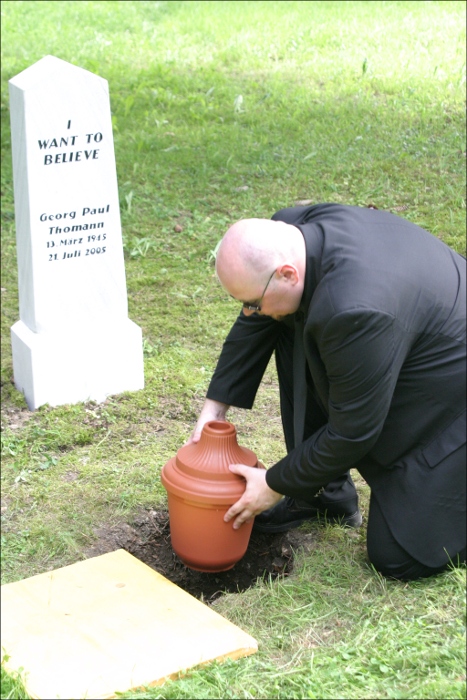
Read Part 1 of the Interview
http://www.furtherfield.org/interviews/interview-johannes-grenzfurthner-monochrom-part-1
Read Part 3 of the Interview
http://www.furtherfield.org/features/interviews/interview-johannes-grenzfurthner-monochrom-part-3
Above image taken by Scott Beale, Laughing Squid.
Marc Da Costa interviews the ever dynamic Johannes Grenzfurthner, founder of monochrom. This is the first of three interviews, where he talks about the project ‘Soviet Unterzoegersdorf’; the fake history of the “last existing appanage republic of the USSR”. Created to discuss topics such as the theoretical problems of historiography, the concept of the “socialist utopia” and the political struggles of postwar Europe. In March 2009 Monochrom presented ‘Soviet Unterzoegersdorf: Sector II’. The game features special guest appearances of Cory Doctorow, Bruce Sterling, Jello Biafra, Jason Scott, Bre Pettis and MC Frontalot.
Since 1993, the Monochrom members have devoted themselves to the grey zones where systems intersect: the art (market), politics, economics, pop, gaiety, vanity, good clean fanaticism, crisis, language, culture, self-content, identity, utopia, mania and despair. The technique underlying Monochrom’s work is that of being and working in the fields of Pop/avant-garde, theory/reflection, interventionism/politics, gaiety/lust/tragedy, (self-)configuration/mystification. The project Monochrom pushes into and beyond these fields is, ‘networking’ events, people, possibilities, material, impetus and identities.” (Zdenka Badovinac, Moderna Galerija Ljubljana)
Grenzfurthner has collaborated with groups such as ubermorgen, Billboard Liberation Front, Esel and Mego (label). Grenzfurthner writes for various online/print magazines and radio stations (e.g. ORF, Telepolis, Boing Boing). Grenzfurthner has served on a number of art juries (e.g. Steirischer Herbst, Graz). He holds a professorship for art theory and art practice at the University of Applied Sciences, Graz, Austria and is a lecturer at University of Arts and Industrial Design in Linz, Austria.
Recurring topics in Johannes Grenzfurthner’s artistic and textual work are: contemporary art, activism, performance, humour, philosophy, sex, communism, postmodernism, media theory, cultural studies, popular culture studies, science fiction, and the debate about copyright.
The ‘Soviet Unterzoegersdorf’, a game created by monochrom, is described as being at once the “last existing appendage republic of the USSR” and located inside the Republic of Austria. Could you speak a bit about the project and its background?
From a conceptual background we have to state that we have been occupied with the construction, analysis and reflection of alternative worlds for quite a long time. A lot of our projects are treating this field partly as a discussion with concepts deriving from popular culture, science and philosophy, and partly as a direct reference to science fiction and fantasy fan culture. We first created the fake history of the “last existing appendage republic of the USSR” in 2001 — ten years after the ‘mighty Soviet Union’ went into this nation-state-splitting-up-process and new countries emerged like Firefox pop-ups that you can’t manage to click away.
We wanted to discuss topics such as the problems of historiography, the concept of “utopia” and “socialist utopia” and the political struggles of postwar Europe in a playful, grotesque way. You have to bear in mind that the real village of Unterzoegersdorf was part of the Post WWII Soviet zone from 1945 until the foundation of the ‘neutral’ Republic of Austria in 1955. Reactionary Austrians talk about 1955 as the ‘real liberation’… and I have to mention that that’s rather typical: cheering when Hitler arrives and being proud members of the Third Reich, afterwards proclaiming that Austria was the first victim of Nazi Germany and complaining about the allied occupation forces — especially the Soviet.
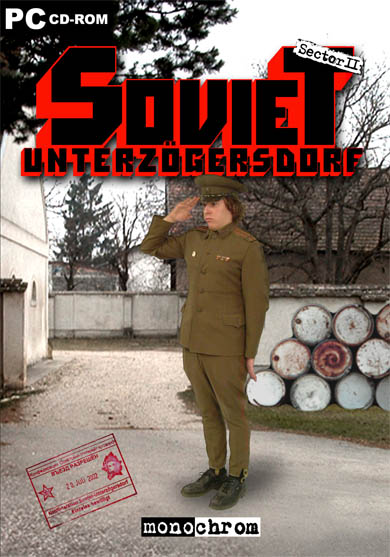
We transformed the theoretical concept into an improvisational theatre/performance/live action role-playing game that lasted two days. That means we really organized bus tours to Unterzoegersdorf — a small village that really exists — and acted the setting; beginning with the harsh EU Schengen border control. Later, in 2004, we started to think about a possible sequel to the performance. We thought that the cultural format of the “adventure game” provided the perfect media platform to communicate and improve the idea.
We started to work in February 2004 and presented ‘Sector 1’ — the first part of the trilogy — in the form of an exhibition in Graz/Austria in August 2005. We released ‘Sector 2’ in 2009, featuring guest stars as Cory Doctorow, Jello Biafra or Bruce Sterling. As the game series uses a 3rd person perspective with photo backgrounds and pictures of real actors as sprites, it took us quite a while to digitize and image process all of the material. This technique was actually first used by Sierra On-Line during the early and mid-1990s — but we are quite proud that we managed to get the feeling of discovering an old computer game that never existed on your old 500 MB hard drive. One aspect of the game is playing with memories and the future of the past. The future is a kind of carrot, the sort tied just in front of the cartoon donkey’s nose so it goes to work, goes off to war, learns Javascript and knows which bits to laugh at in Woody Allen’s Sleeper. You can imagine.
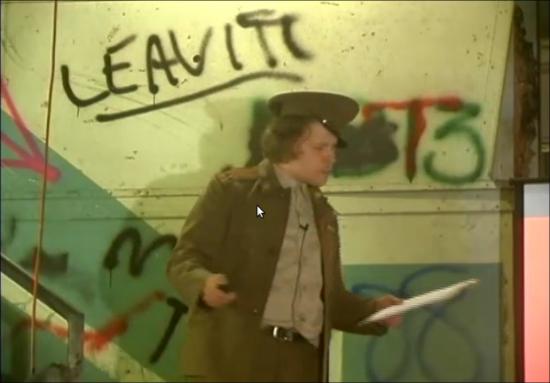
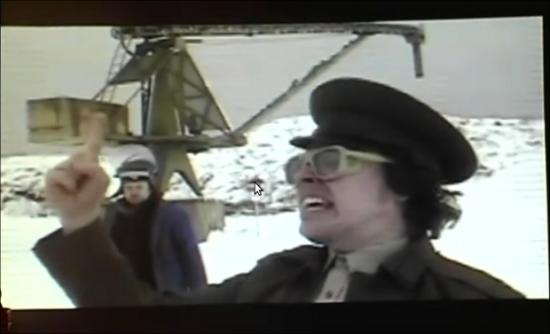
At a HOPE conference a few years back I was interested to hear you talk about the framing of the project as somehow deeply connected with a certain understanding of historiography that you and the other members of monochrom share. Could you elaborate on this a bit?
Debates triggered by postmodern culture have directed our attention towards questions of representation and the relevance of “history” and stories — i.e. The challenging proclamation of a post-histoire, the realization of the impossibility of a meta-narrative of history; the clash between reality and sign systems, the difference between fact and fiction, the impossibility of neutral contemplation or witnessing as well as the positioning of subjective awareness within such representations, etc. All these forms of representation have been playing a central part in the development of national, ethnic and tribal identities since WWII. And (as a by-product of military technology) computer game development is hardly aware of these discourses.
We wanted to combine (retro)gaming and (retro)politics and (crypto)humor to delve into this ongoing discourse. We wanted to harvest the wonderful aesthetic and historic qualities of adventure gaming. It is a commemoration and resurrection, and one more reminder that contemporary gaming (in its radical business-driven state-of-the-artness) should not dare to forget the (un)dead media of the past — or they will haunt them.
If you compare the status of the adventure game in the context of the economic growth of the computer game industry you could state that it is gone. Less than 1% of all computer games written are adventure games. Adventure games are nearly extinct… but only nearly. If media and media applications make it past their Golden Vaporware stage, they usually expand like giant fungi and then shrink back to some protective niche. They just all jostle around seeking a more perfect app.
For many people in the Soviet Unterzoegersdorf team, adventure games are part of their media socialization. For the computer industry it is one of the most successful gaming formats of the past. And for the feminist movement it is proof that a woman — I’m talking about Sierra On-Line’s Roberta Williams — was able to shape the form of a whole industry totally dominated by men.
Computer games are embedded in the cultural framework of technological developments. In the study of technological development and creativity, focusing attention on the failure, the error, the breakdown, the malfunction means opening the black box of technology. Studies have convincingly demonstrated that the widespread inability to understand technological artifacts as fabricated entities, as social and cultural phenomena, derives from the fact that in retrospect only those technologies that prove functional for a culture and can be integrated into everyday life are “left over.” However, the perception of what is functional, successful and useful is itself the product of social and cultural–and last but not least–political and economic processes. Selection processes and abandoned products and product forms are usually not discussed. According to Langdon Winner, there is a sense in which all technical activity contains an inherent tendency toward forgetfulness. Quote: “Is it not the point of all invention, technique, apparatus, and organization to have something and have it over with? (…) Technology, then allows us to ignore our own works. It is license to forget.”
Could you also perhaps talk about the choice of selecting the genre of an adventure game as the incarnation of this downtrodden republic. At the risk of being literal minded, is there any sense in which the existence of ‘Soviet Unterzoegersdorf’ as a kind of place that comes alive through players’ interactions with a program downloaded from the internet has anything to say to how you imagine being able to engage/critique/disrupt the idea of the nation-state?
We are postmodern leftists. A little bit melancholic… but you can count on us. We love to play with layers of consciousness and layers of layers of consciousness. On first view our project could be interpreted as a mock-up of the Soviet Union and the communist state structures that really existed. But, why on Earth do we need so many references to 1980s and 1990s metal music? Or Marvin Minsky? Or Negri? Or Austrian post-WWII history? Or geek adumbrations? Mocking the Soviet State would be much easier. In fact it’s about the wonderful clash between reality and sign systems, the impossibility of neutral contemplation or witnessing as well as the positioning of subjective awareness within such representations. The traditional humanists tend to see the whole philosophic aesthetic postmodern line of thought — from Judith Butler to Lyotard and Derrida — from the wrong angle. Okay, you can’t explain Sun Ra to a Green Day fan now, when he’s laying in the corner, piss-drunk and crooning “Anarchy”. But we think that the (radical) nature of postmodernism is often simply not grasped because people just copy it down into the conservative pattern of thinking which has been indoctrinated into us since the Enlightenment. Of course, on the other hand, it functions as a virus, and there’s nothing wrong with that.
Contemporary art — the field we are usually working in because there’s money — is mostly concerned with systems or systematic concepts. In the context of their work, artists adapt models of individual art-specific or economic or political systems like in a laboratory, to reveal the true nature of these systems by deconstructing them. So would it be fair to say that by their chameleon-like adaptation they are attempting to generate a similar system? Well… the corporate change in the art market has aged somewhat in the meantime and looks almost as old as the ‘New Economy’. Now even the last snotty brat has realized that all the hogwash about the creative industries, sponsoring, fund-raising, the whole load of bullshit about the beautiful new art enterprises, was not much more than the awful veneer on the stupid, crass fanfare of neo-liberal liberation teleology. What is the truth behind the shifting spheres of activity between computer graphics, web design and the rest of all those frequency-orientated nerd pursuits? A lonely business with other lonely people at their terminals. And in the meantime the other part of the corporate identity has incidentally wasted whole countries like Argentina or Iceland. That’s the real truth of the matter.
Read Part 2 of this Interview
http://www.furtherfield.org/features/interviews/interview-johannes-grenzfurthner-monochrom-part-2
Read Part 3 of this Interview
http://www.furtherfield.org/features/interviews/interview-johannes-grenzfurthner-monochrom-part-3
Introduction:
As media attention wanes, the impact of British Petroleum’s Deep Horizon, off-shore drilling disaster continues to unfold. Artists worldwide respond to this new ecological catastrophe in a group show organized by Transnational Temps, an arts collective exploring the interstices of art, ecology and technology. For Andy Deck, one of the founding members of Transnational Temps and the curator of the show, “After a decidedly unsuccessful round of climate negotiations in Copenhagen, the disaster in the Gulf of Mexico frames this exhibition of Earth Art for the 21st Century.”
Now hidden from view by BP’s media campaigns and other de facto censoring actions, the images of oil-covered birds struggling to breathe and fly, oil and dispersant-coated fish, dolphins and whales washing up dead while most sink to the ocean floor, have all but vanished. Partially filling the void are the artists showing here who are recreating topographies: mapping the course of a deadly shadow over our shores and waters; and reinterpreting the sea, its rising levels and largesse, before the vicissitudes of man and nature. Transnational Temps.
———-
Spill >> Forward by Transnational Temps describes itself as an Online Exhibition. It is a website containing images and other media on the theme of oil spills. Some of the images were shown at the MediaNoche gallery from July 30th – November 19th, 2010, with works added or removed so it isn’t just an online catalogue of a meatspace show.
The front page of the site warns that you’ll need a browser that supports HTML5 video and audio, and states that you can view it using patent-free media codecs. From a Free Software and Free Culture point of view this is excellent, your ability to view the art is not restricted by anyone else’s technological or legal machinations. This is also good from an artistic point of view. The software used to view the art can be run and maintained by anyone, making it more accessible, exhibitable and archivable. But this freedom doesn’t extend into the work itself. some of the art uses proprietary software, and none is under a free Creative Commons licence.
The image on the front page, or possibly the image exhibited at the entrance to the exhibition, is not advanced HTML5 video or canvas tag animation but an animated GIF. A Muybridge-ish series of still images of a pelican in flight flickers rapidly up and down as it descends behind an iridescent oil slick that solarizes the bottom half of the image. It’s an effective image in itself, a visually and net.art-historically literate statement that also serves to set the stage for the rest of the show.
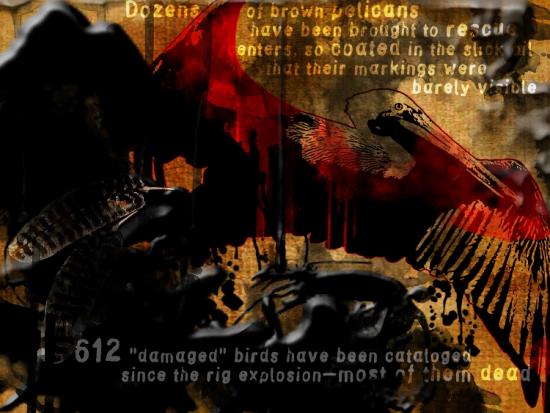
This is clearly a politically motivated exhibition, with the theme of the exhibited art centred on a specific historical event (the Deepwater Horizon disaster). Oil spill and petrol station imagery dominates . The resulting art varies from cooly ironic asethetics (Ubermorgen), photo and video journalism (Guillermo Hermosilla Cruzat, S.Slavick & Andrew E.Johnson, Chris Dascher, Adrian Madrid), agitprop (Eric Benson, Geoffrey Michael Krawczyk, Alyce Santoro, Russ Ritell, Terri Garland, Patrick Mathieu), photography(Jessica Eik, Sabina Anton Cardenal), painting(Jessie Mann), collage(Ume Remembers), performance art(Graham Bell), interactive multimedia (Gavin Baily, Tom Corby, Jonathan Mackenzie, Chris Basmajian, Matusa Barros, Mark Cooley), augmented reality (Mark Skwarek and Joseph Hocking) and drawing (Cristine Osuna Migueles, Adrienne Klein, Jesus Andres, Sereal Designers) to video and audio art (Irad Lee, Luke Munn, Gene Gort, Tim Geers, Gratuitous Art Films, Alex George, Collette Broeders, Fred Adam and Veronica Perales, Virginia Gonzalez, Henry Gwiazda, Maria-Gracia Donoso, Jeremy Newman).
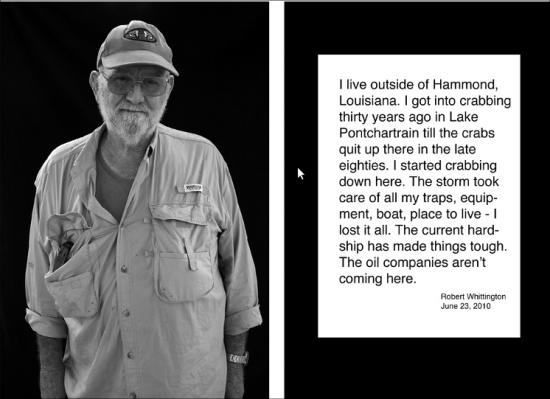
This is a lot to take in but the diversity of the work is a strength rather than a weakness, building a broad and visceral response to the Deepwater disaster. Verbal responses to the disaster from politicians seem unconvincingly nationalistic and corporate in comparison. It might seem hypocritical for artists to criticise the source of the energy that feeds us and allows us to make new media art. But we are trapped in that system, and we must be free to criticise it.
Politically inspired artworks have a difficult history, tending to be either bad politics or bad art. The art in Spill >> Forward is excellent, though. Some has a more direct message than others. Again the diversity of the exhibition plays a positive role here. The immediacy of the agitprop images doesn’t need art historical baggage to be effective, but that immediacy provides a social context for the more contemplative or abstract works. The more contemplative or abstract works don’t hammer home a simple political message but they provide an aesthetic context for the more direct images. They work very well together.
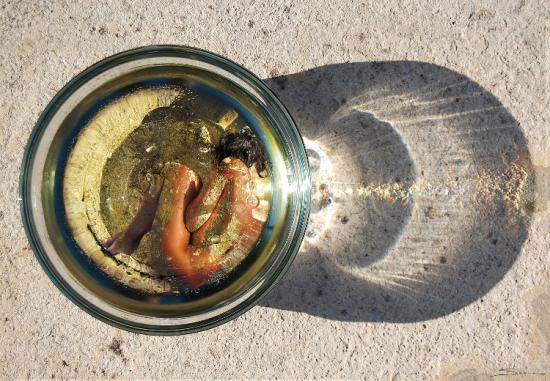
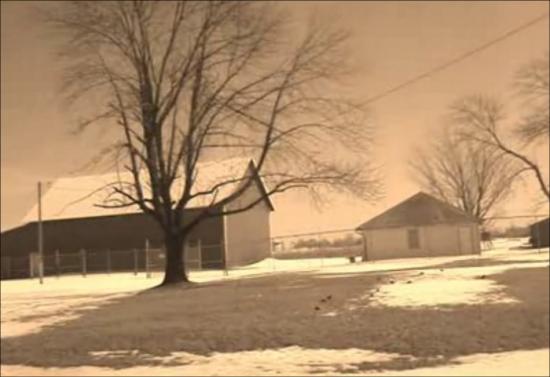
Some of the pieces in the show are clearly illustrations or recordings of work, some are electronic media that can be played on a computer, some are clearly designed to be experienced specifically through a computer system. If you removed the political theme of the show it would still be a visually (and audially) and conceptually rich cross-section of contemporary art. I was going to write “digital art” there but the show includes painting, drawing, performance, and other analogue or offline media recorded digitally for presentation online. The celestial jukebox is hungry.
If I had to pick out just a few pieces from the show I’d say that I was struck by the sounds of Luke Munn’s Deepwater Suite, by the visuals of Ubermorgen’s DEEPHORIZON, by the monochrome images and text of Terri Garland’s photography, by the video mash-up of Colette Broeders’ Breathe and by the critical camp of Graham Bell’s Radical Ecology. I think my favourite is Mark Skwarek and Joseph Hocking’s “The Leak in Your Home Town”, an iPhone app that uses the BP logo as an Augmented Reality marker to super-impose a 3D animation of the Deepwater leak over live video of your local BP petrol station. It is art that could only be made now, technologically, aesthetically and socially.
The aesthetic and conceptual competence of the artistic responses to the environmental and human crises of the oil spills in Spill >> Forward make the case for art still being a relevant and capable answer to society’s need to make sense of unfolding events. Art can still provide a much-needed space for reflection, and Spill >> Forward creates just such a space in a very contemporary way.
The text of this review is licenced under the Creative Commons BY-SA 3.0 Licence.
Ambient Information Systems
English, some texts in German. Translator: Nicholas Grindell
400 pages, 6-colour hardbound, 17.5 x 23 cm
edition of 1,500 unique & numbered.
now available at ambient.publishing.
ISBN-13: 978-0-9556245-0-6
Ambient Information Systems by Manu Luksch and Mukul Patel is a hardback book that presents writing, images and art by and about ambient.tv (Luksch and her collaborators) from during the last decade. Its purple and yellow cover tempered by a tracing paper slip-cover, contains almost four hundred pages of sans-serif text cleanly laid out among images and sidebars. As intermedia artists with a strong emphasis on research and dissemination. Recent works have addressed surveillance, corporate data harvesting, and the regulation of public space.
The material presented in the book ranges from written essays and project proposals through preparatory sketches, computer server log files and video screen grabs to modification of the printed book iteslf by unique rubber stamps and scribbling over sections of text. This diverse and detailed presentation of ambient.tv’s work provides an insight into the inspiration, planning and production of some conceptually and aesthetically rich new media art.
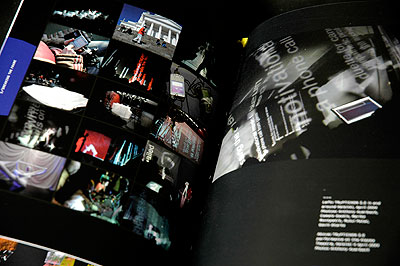
There’s a report from Kuwait during Ramadan 2002, a description of using cutting-edge wearable PCs, a discussion of the role of television, information about the harp in mythology, cyborg markets, the UK Data Protection Act, climate change, anti-gentrification, art and systems theory, UAVs, the Pacific plastic dead zone, and much, much more. There are projects that create free networks, dangerous musical instruments, taped-out surveillance camera boundaries, video installations, photographic images, movies of CCTV footage gained through freedom of information requests, manifestos, snowglobes, and cocktails.
(It’s a fascinating pleasure to read but it’s overwhelming to try and review.)
The portrait of Ambient.tv that emerges from all this is of intensive cultural critique pursued through a playful low-fi digital aesthetic. This isn’t a contradiction, the latter is in the service of the former. Ambient.tv’s projects and proposals tackle serious social and political issues. They do so through skilled use of the aesthetics and attitude of low-fi new media art and technological activism.
The wealth of ideas contained in the essays and other writing in the book show how historical, political and philosophical knowledge grounds the resulting art and indicates how it embodies a critique of contemporary culture.
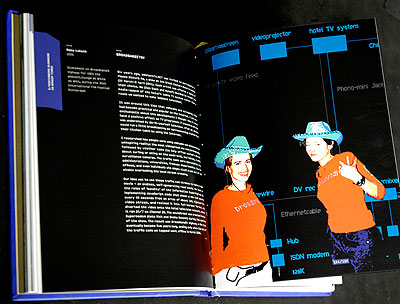
Contemporary culture as seen by Ambient.tv is surveillance culture, the database state with its DNA databases and laws that protect freedom by removing freedom. Ambient.tv is a realistic project, depicting the hidden forms of contemporary society that intrude into our lives. This is heavy stuff, and to air it critically without alienating the audience it requires precisely the playful touch that ambient.tv often bring to their art.
To take the example of FACELESS, 2007, (the first project I personally saw Luksch present), there is an exquisite balance between the disturbing idea of pervasive surveillance, the practical limitations of Freedom Of Information requests, and the visual and science-fictional narrative aesthetic that emerged from this. On their web site it states that it was produced “…under the rules of the Manifesto for CCTV Filmmakers. The manifesto states, amongst other things, that additional cameras are not permitted at filming locations, as the omnipresent existing video surveillance (CCTV) is already in operation.” The result is something more interesting and disturbing to watch than a simple collage of CCTV footage would be. The fact that the work can be made like this, that it can look like this, means something.
This strategy can be seen in “Mapping CCTV around Whitehall”, 2008, as well, which I also reviewed for Furtherfield here, and in many other pieces by Ambient TV.
Reading the proposals and essays shows the depth I suspected to this work, when I first saw it projected in a darkened room is there in its conception and execution.
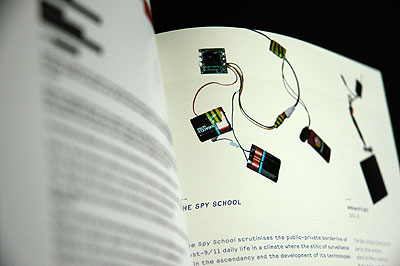
It’s an intense and inspiring experience to be faced with the textual equivalent of a decade-long open studio. The first essay in the book, a theory-laden piece by Fahim Amir, is almost overwhelming in a different way. It’s pure Theory, which will hopefully sell Ambient.tv to the artworld sectors that thrive on that sort of thing, but it isn’t the best introduction for newcomers to the project’s very accessible art.
But what a rare pleasure to be given such a wealth of insight into art that so acutely depicts our times. “Ambient Information Systems” is an important resource for contemporary artists and critics, an insight into the ideas and development of a very successful new media art practice. The grungey, playful, important realism of Ambient.tv’s work deserves presentation in a context that shows just what has gone into the art and just what people can get out of it. This is it.
The text of this review is licenced under the Creative Commons BY-SA 3.0 Licence.
Helen Varley Jamieson’s account of working collaboratively in Madrid at the Eclectic Tech Carnival. On a ‘sprint’, with five women coming together for a week to rebuild the group’s website, physically & remotely.
In the last week of June I went to Madrid for the Eclectic Tech Carnival (/ETC) website workweek – the collective effort of five women coming together for a week to rebuild the group’s website. This is sprint methodology, a concept that I first met in Agile software development, but one that is being increasingly applied as a successful creative collaboration methodology. During the workweek I blogged about the process and this article is an assemblage of the blog posts.
Thinking about the concept of the sprint, I realised that over the years, I’ve participated in a number of theatrical “sprints” although we didn’t call them that. In fact it could be argued that the normal development process for theatre productions in New Zealand is the sprint – a three or four week turnaround of devising/rehearsing/presenting. Except that it doesn’t usually continue the Agile process after the first sprint – evaluation, refinement then the next sprint and iteration – and as a result, the work is often undercooked. But theatre projects that better fit the sprint analogy are some of the workshop-performance processes that I’ve participated in at theatre festivals, where a small group comes together for a few days to create a performance, then some time later meets again in another situation, perhaps a slightly different configuration of people, for another sprint. Each sprint generates a stand-alone performance or work-in-process showing, as well as contributes to a larger evolving body of work that forms the whole collaborative project. Two such projects that I’ve been part of are Water[war]s and Women With Big Eyes (with the Magdalena Project).

Recently I participated remotely in a Floss Manuals sprint, developing a manual for CiviCRM (which is something that I use with the Magdalena Aoteroa site). In this sprint, a group of about 15 people met somewhere in the USA to create a manual for CiviCRM. A few more of us were online, doing things like copy-editing the content. Most of the time there were people active in the IRC channel, chatting about the project and other things going on around them, so I got a sense of their environment, time zone and the camaraderie generated by the intense process.
Sprinting seems like a very logical and effective way to work in many situations: in software development, where each sprint focuses on specific feature development, and allows for a lot of flexibility and adaptation as the project progresses; in theatre, where limited resources make it a practical way to work, and the time pressure forces us to be resourceful and imaginative and also with networks, such as the Eclectic Tech Carnival, whose organisers don’t get to meet physically very often. It also makes sense in the context of our hectic lives, to block out a week or a few days when we agree to put everything else on hold and commit to intense, focused work instead of trying to juggle and multitask, with deadlines pushing out and out.
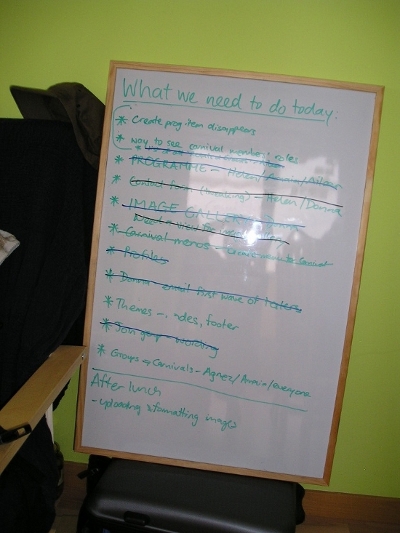
By halfway through the second day of the workweek, the wiki we used to plan and manage the project was filling up with tech specs, user requirements, design ideas, etc. We were getting encouraging emails from others in the network, and chatting to each other across the table and in the IRC. After lunch we did the new Drupal install and things seemed to be moving forward quickly in an organised and collaborative way.
Wednesday afternoon and the heat was oppressive; I put a little rack under my laptop because she was so hot, and my hands were too sweaty to use the trackpad. It wasn’t just Madrid’s weather that was making me sweat – we’d all been working hard on the new site since our late start in the morning (following on from a late night …). Agnes was busy developing the theme for the site, Aileen was working on profiles and user roles while Donna and Amaia were trying to configure mailing list integration and I was using the command line to drush download modules – much easier and quicker than the process of downloading, unpacking, ftp-ing and installing! And very exciting for me to use the command line, which I generally only get to do when hanging out with the /ETC crowd.

We were in that murky middle phase of the process: we’d done a lot of groundwork in terms of defining users, content types, general structure and the functionality required, but everything was still very bitsy and amorphous. But the installation of the test site had happened very easily yesterday, using drush, so that meant we now had something tangible to work with.
Working with Drupal can be pretty frustrating; it seems that every step of the way, another module is required to do what we want – then that module requires other modules, and then every little thing has to be finely configured to work just right with every other piece of the puzzle. From my previous experience with the Magdalena Aotearoa site, I knew we are doing a lot better this time in terms of defining what we need first, but some things we just can’t define until we know what’s possible, which we don’t really know for sure until we actually try it. We *think* we’re going to be able to do everything we want, but getting there isn’t simple. Also, the naming of different components and modules is sometimes ambiguous or confusing – the documentation ranges from really clear and detailed to non-existent. And some things just didn’t seem intuitive to me.
But, with five brains and our different complementary experiences and skills, I was still confident that we would have a new site by the end of Friday; maybe not a completely finished one, but a web site is never finished, is it?
On Friday morning the heat broke with a thunder storm and cooling welcome rain, but it didn’t last long. For some reason I woke up at 7.30am, ridiculously early as we hadn’t gone to bed until 2am. But I was wide awake so I enjoyed a couple of hours of quiet before everyone else awoke, drinking coffee and answering emails. The day before, Agnez and I had got up early to do yoga on the terrace, but the intense rain prevented that on Friday.
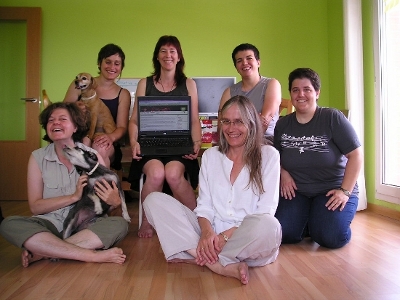
The test site was up and some of the others not present in Madrid were looking at it and trying things out. We’d solved a lot of problems but there were still a number of things not working. I had learned heaps about Drupal in the previous four days, particularly about organic groups, roles, permissions, and views. Altogether it is potentially incredibly flexible and powerful, however it takes time to work out how things need to be done and sometimes it is a confusing and circular process. Changing a setting in one place can stop something in a completely different place from working. However the combination of skills and experience between the five of us meant that usually one of us had at least an idea about how to do things and a couple of times we drew on external expertise via IRC or email.
On the last day, Agnez worked on finishing the theme while Aileen and I tried to work out why our groups are no longer displaying in the og_my view, and how to make the roles of group members visible. Donna had found that mailhandler and listhandler didn’t seem to be a practical way to integrate our mailman lists with Drupal after all – for the time being we’ll stick to the old system – and Amaia had been working on a way to create a programme for each event. The idea is that each /ETC event can be created as an organic group with the organisers having control over content and members within that group, but not being able to edit the rest of the site content. By Friday, we had this working pretty much how we wanted it.
We had planned a barbecue to celebrate the end of the workweek, but the rain prevented that. Instead, we ate inside then took turns to suffer humiliation and defeat with Wii Fitness (Amaia had clearly been practising!). In fact it wasn’t really the end of the sprint – rain again on Saturday morning meant that we decided to keep working longer and only went into the city in the afternoon, for a wander around and then the Gay Pride parade. On Sunday as we began to scatter back to our different parts of the globe, the site was still not live, as we were waiting for more feedback from testers and the finishing of the design themes. However, the site is essentially functional and should be live very soon.
The sprint process enabled us to achieve a considerable amount in a short space of time, sharing our knowledge and developing our skills. We also had great conversations over meals, explored Madrid and Colmenar Viejo, learned how to make Spanish tortilla, attempted a bit of Spanish, went swimming and did yoga. I even fitted in a performance on the first night, with Agnez, and dinner with friends another night. It’s amazing what you can do when you put the rest of your life on hold for a week; the only downside is the catching up afterwards.
In episode five of the popular Israeli sitcom, Arab Labor, Amjad and his family are invited for Passover to the home of a reform family whose son goes to kindergarten with Amjad’s daughter. Amjad is enthusiastic about the Seder ceremony and decides to adopt the concept of the Haggadah into Eid al-Adha (The Festival of Sacrifice). In this way Amjad attempts to balance his life as an Israeli Arab by using some food, a bit of ceremony, and a lot of comedy!
Eating together is a central theme in many religions, going back to ancient Greece. The basic diet in Greece consisted mostly of grains. Meat was only eaten collectively after sacrifices to the gods, which anyone who can get through the first book of the Iliad without drooling will tell you.
It is hard not to bond with people when you eat together. Sometimes the act of eating together can be a tool of influence: business lunches, awards dinners, naked brunches, etc. Even a breakfast might be an opportunity to bond, as Thomas Macauly once said: “Dinner parties are mere formalities; but you invite a man to breakfast because you want to see him.” But can take-away meals be a way to disseminate culture and spread knowledge?
A new take-out restaurant that only serves cuisine from countries that the United States is in conflict with has open in Pittsburgh, PA. It is called Conflict Kitchen. This eatery is similar in concept to Michael Rakowitz’s 2004 project called Enemy Kitchen. The purpose of Enemy Kitchen was to use food to “open up a new route through which Iraq can be discussed. In this case, through that most familiar of cultural staples: nourishment.”
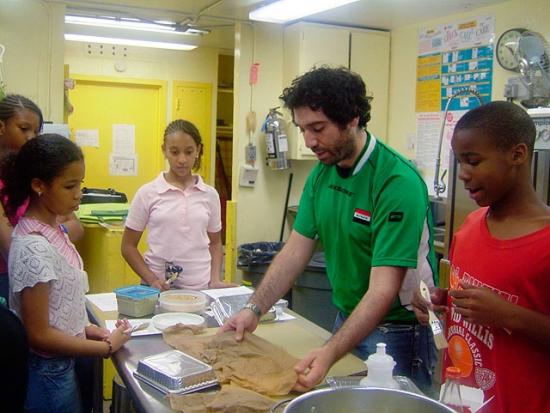
Enemy Kitchen, an ongoing project where Rakowitz collaborates with his Iraqi-Jewish mother. Compiling Baghdadi recipes, teaching the dishes to different public audiences. The project functioned as a social sculpture: while cooking and eating, the students engaged each other on the topic of the war and drew parallels with their own lives, at times making comparisons with bullies in relation to how they perceive the conflict.
Conflict Kitchen is a more commoditized version of Rakowitz’s project, using Iranian cuisine as a vehicle to market “rogue” state culture. Conflict Kitchen will have rotating menus, the next being Afganistan and then North Korea. In an interview with We Make Money Not Art, the creators of the project said that most Pittsburghers don’t know what the restaurant is all about, despite its having made international headlines. Besides creating a more commercially marketable Iran, the food counter brings people from all walks of life together to discuss everything from politics to religion while they wait for their food to be prepared. The creators use this opportunity to chat with the customers and “the conversation naturally goes to Iranian culture–perceptions and misperceptions–and often back to the customer’s own cultural heritage.”
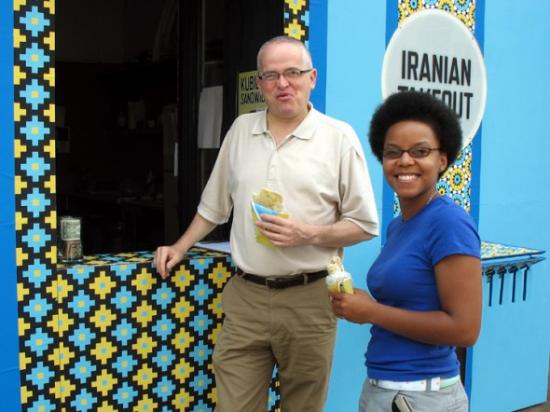
I like the idea of promoting cultural awareness through cuisine, I guess it is the next best thing to having a study abroad experience. Maybe now people can go out, eat and get informed first hand instead of being force fed fear-mongering news by the American media. The main US propaganda machine, Disney, has a long history of using food to influence public opinion. 0ne of their most successful brain-washing campaigns, known as The Magic Kingdom, convinced millions of children and their families that all Mexicans shoot Churros from their fingertips on command, that all Germans walk around in lederhosen serving bratwurst all the live-long day, and that all Chinese children wear rice-picking hats and ride around on one-speed bikes and selling chop-sticks. What sort of chance does Conflict Kitchen stand against such Pavlovian methods of coercian? None whatsvever, but at least you get to eat somewhere that is officially more famous than the Carnegie Deli.
An Interview with Heath Bunting – Part 1
I first met Heath when I moved to Bristol (UK) in 1988. It felt important, even profound. Not in a ‘jump in a bed’ kind of way. Yet our meeting did seem life changing somehow, to the both us. We hit it off and we collided – as equals – our collisions resonated, it shook our imaginations. From then on our paths, our lives connected and clashed regardless. We regularly challenged each other through constant, critical duels of dialogue; about activism, art, technology and ideas surrounding different life approaches and philosophies. From 1988 – 1994 (just before the Internet had properly arrived), in Bristol and London we collaborated on various projects such as pirate radio, street art and the cybercafe BBS – Bulletin Board System. We then went our separate ways exploring our own concerns more deeply, but continued to meet every now and then. Us both meeting in Bristol changed both of our worlds, it built the grounding of where we are now.
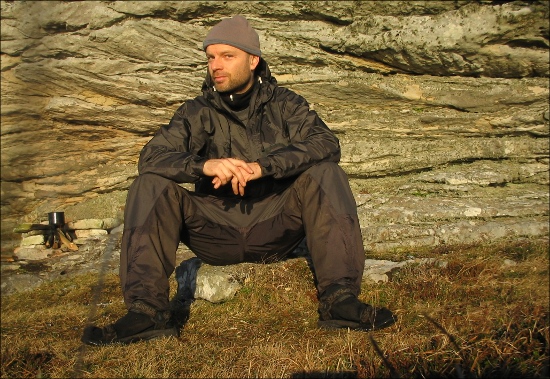
Heath founded the Irational.org collective in 1995, a loose grouping of six international net and media artists who came together around the server irational.org. The collective included Daniel Garcia Andujar / Technologies to the People (E), Rachel Baker (GB), Kayle Brandon (GB), Heath Bunting (GB), Minerva Cuevas / Mejor Vida Corporation (MEX) and Marcus Valentine (GB).
Heath Bunting’s work manifests a dry sense of humour, a minimal-raw aesthetic and a hyper-awareness of his own artistic persona and agency whilst engaging with complex political systems, institutions and contexts. Crediting himself as co-founder of both net.art and sport-art movements, he is banned for life from entering the USA for his anti GM work, such as the SuperWeed Kit 1.0 – “a lowtech DIY kit capable of producing a genetically mutant superweed, designed to attack corporate monoculture”. Bunting’s work regularly highlights issues around infringements on privacy or restriction of individual freedom, as well as issues around the mutation of identity; our values and corporate ownership of our cultural/national ‘ID’s’, our DNA and Bio-technologies “He blurs the boundaries between art, everyday life, with an approach that is reminiscent of Allan Kaprow but privileging an activist agenda.”[1]
In this two part interview we will discuss his current work within two distinctive areas of digital culture and sport-art starting with The Status Project, which studies the construction of our ‘official identities’ and creates what Bunting describes as “…an expert system for identity mutation”. His research explores how information supplied by the public in their interaction with organisations and institutions is logged. The project draws on his direct encounters with specific database collection processes and the information he was obliged to supply in his life as a public citizen, in order to access specific services; also on data collected from the Internet and from information found on governmental databases. This data is then used to map and illustrate how we behave, relate, choose things, travel and move around in social spaces. The project surveys individuals on a local, national and international level producing maps of influence and personal portraits for both comprehension and social mobility.
Marc Garrett: For many years now, your work has explored the concept of identity, investigating the various issues challenging us in a networked age. The combination of your hacktivist, artistic approach and conceptual processes have brought about a project which I consider is one of the most comprehensive, contemporary art projects of our age. The Status Project, deals with issues around personal identity head-on.
Why did you decide to embark on such a complex project?
Heath Bunting:
Three reasons
1. the network hacker
the network hacker fantasises about unlimited access to all systems made available through possession of treasure maps, keys and navigation skills
2. the Buddhist
the Buddhist intends to destroy the self and become only the summation of environmental factors plus find enlightenment in even the most banal bureaucracy
3. the computer scientist
the computer scientist aims to find comfort and hidden meaning in complex data
I am all three and am attempting to combine the obsessions of each into one project.
So far I have
Created a sketch database of the UK system with over 8000 entries
Created over 50 maps of sub-sections of the system to aid sense of place and potential for social mobility
Created system portraits of existing persons
Created software to generate new identities lawfully (off the shelf persons) and sold these identities
I am currently adding more data to the database. Which is split between the human being (flesh), the natural person (strawman) and the artificial person (corporation). Remaking maps using upgraded spider software, researching how to convert my identity generating software into a bot recognised under UK law as a person; and hence covered by the human rights act i.e. right to life and liberty; freedom of expression; peaceful enjoyment of property. I am very close to achieving this.
Did you know that 75% of the human rights act applies to corporations as well as individuals? If you were afraid of corporations in the 90’s and noughties then be very afraid of the automated voices that speak to you on stations or programs that transact currency exchanges, as they will soon be your legal equals as with all Hollywood propaganda, the reverse is true. The human beings will be the clumsy, half wit robot like creatures serving the new immortal ethereal citizens. If you think I am mad or joking, check back in 10 years time.
MG: Way back in 1995, there were already various groups and individuals (including yourself) who were critiquing human relationships whilst exploiting networked technology. Creative people who were not only hacking technology but also hacking into and around everyday life, expanding their skills by changing the materiality, the physical and immaterial through their practice. It was Critical Art Ensemble (CAE) who in 1995 said “Each one of us has files that rest at the state’s fingertips. Education files, medical files, employment files, financial files, communication files, travel files, and for some, criminal files. Each strand in the trajectory of each person’s life is recorded and maintained. The total collection of records on an individual is his or her data body – a state-and-corporate-controlled doppelganger. What is most unfortunate about this development is that the data body not only claims to have ontological privilege, but actually has it. What your data body says about you is more real than what you say about yourself. The data body is the body by which you are judged in society, and the body which dictates your status in the world. What we are witnessing at this point in time is the triumph of representation over being. The electronic file has conquered self-aware consciousness.”[2]
15 years later, we are dealing with an unstoppable flow of meta-networks, creeping into every area of our livng environments. We have mutated, become part of the larger data-sphere, it’s all around us. As you describe, it seems that we are mutating into fleshy ingredients, nourishing a technologically determined world.
HB: Data body is quite a good way to think about it. I consider each human being to possess one or more natural person(s) and each natural person to control or possess none, one or more artificial person(s) (i.e. corporation). The combined total of natural and artificial persons possessed or controlled by a human being can be thought of as their databody. As human beings, we have quite a lot of control over our persons (natural and artificial). The problem is that we either don’t realise this or it takes the time to manage them. It’s possible to obtain a corporation for less than the price of a train ticket between Bristol and London. Why do so many people live without one? Could anti corporate propaganda have something to do with this ?
“What is most unfortunate about this development is that the data body not only claims to have ontological privilege, but actually has it. What your data body says about you is more real than what you say about yourself.”(CAE).[2]
Only if you remain a passive user of it. The natural person is only linked to the human being through such fine devices as a signature, which we decide to give or withhold, most human being’s natural person is actually owned by the government and borrowed back by the human being. This does not have to be the case as we can create and use our own persons.
“The data body is the body by which you are judged in society, and the body which dictates your status in the world. What we are witnessing at this point in time is the triumph of representation over being. The electronic file has conquered self-aware consciousness.”(CAE).[2]
I would say laziness has triumphed over mindfulness. All information about the functioning of natural persons is easily available, all persons have the same rights unless they choose not to claim them. Instead, people choose to get lost in their own selves and dreams, indulged by those that seek to profit from their labour.
Technology is becoming more advanced and the administration of this technology is becoming more sophisticated and soon, every car in the street will be considered and treated as persons, with human rights. This is not a conspiracy to enslave human beings, it is a result of having to develop usable administration systems for complex relationships. Slaves were not liberated because their owners felt sorry for them, slaves were given more rights as a way to manage them more productively in a more technologically advanced society.
MG: Getting back to the part of your project which incorporates a complex process of compiling and creating ‘off the shelf persons’, as you put it. Are you using some of the collected data as a resource to form these new identities, or is it a set of ‘hybrid’ identities?
HB: Please expand this question further…
MG: Near the beginning of the interview, you mention that you “Created software to generate new identities lawfully (off the shelf persons) and sold these identities.” I am asking whether most of these ‘new identities’ that you have formed and sold are, a mixture of different bits of information. Like data-versions of body parts from a machine or vehicle, reused, recycled to recreate, make new hybrid identities?
HB: The identities I can create are all new and legal, they are a portfolio of new unique legal relationships created with existing artificial persons. For example, registering with Tesco Clubcard either creates or consolidates the new natural person http://status.irational.org/identity_for_sale – for a new natural person to be credible, it must be coherent and rational. This is achieved simply by following the rules of the system, the more interrelating links with other persons, the more real the new person becomes.
Off the shelf natural person.
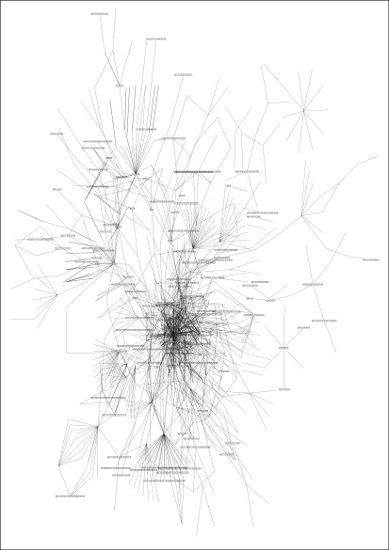
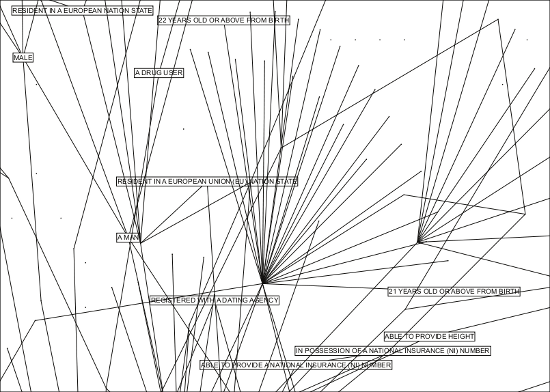
Comes with supporting physical items:
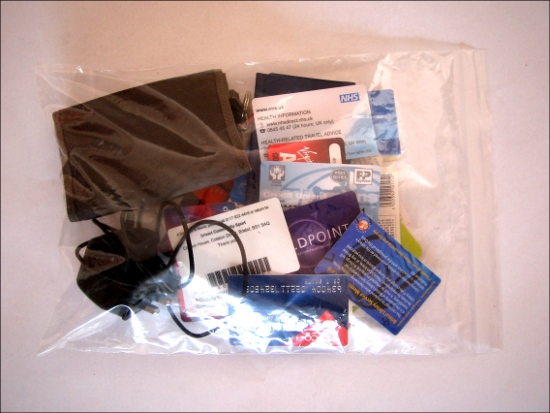
personal business cards, boots advantage card, marriott rewards card, cube cinema membership card, baa world points card, tesco clubcard, vbo membership card, WHSmith clubcard, silverscreen card, airmiles card, somerfield loyalty card, post office saving stamps collector card, virgin addict card, subway sub club card, dashi loyalty card, t-mobile top up card, european health insurance card, waterstone’s card, 20th century flicks card, bristol library card, co-operative membership card, nectar card, oyster card, bristol ferry boat company commuter card, love your body body shop card, co-operative dividend card, bristol credit union card, choices video library card, national rail photocard, bristol credit union account, bristol community sports card, star and garter public house membership card, first class stamp, nhs donor card, winning lottery ticket (2 GBP), t mobile pay as you go mobile and charger…
Upgradable to both corporate and governmental levels.
(500.00 GBP) – SOLD
MG: I can see on the web site, in the section The Status Project – Potentials that there are various ready-mades, ‘Off the shelf natural person – identity kits’. Am I right in presuming that there are individuals out there who have bought and used these kits?
HB: These are mostly existing persons, only one of them was synthetic. I will be setting up a small business soon though to manufacture and sell natural person.
MG: On exploring deeper into the Status Project data-base, there is link to a file called ‘In receipt of income based job seeker’s allowance’. This information is taken from ‘Jobcentre plus’, a UK government run organisation and on-line facility, inviting visitors to search for jobs, training, careers, childcare or voluntary work. How important was this source in compiling data for your database of individuals?
HB: This is only one record of over 8000 in the database, each record refers to one or more other record(s) in the database.
MG: What projects relate to/have influence on The Status Project in some way, and what makes them work?
HB: They Rule[3] – It allows users to browse through these interlocking directories and run searches on the boards and companies. A user can save a map of connections complete with their annotations and email links to these maps to others. They Rule is a starting point for research about these powerful individuals and corporations. A glimpse of some of the relationships of the US ruling class. It takes as its focus the boards of some of the most powerful U.S. companies, which share many of the same directors. Some individuals sit on 5, 6 or 7 of the top 500 companies.
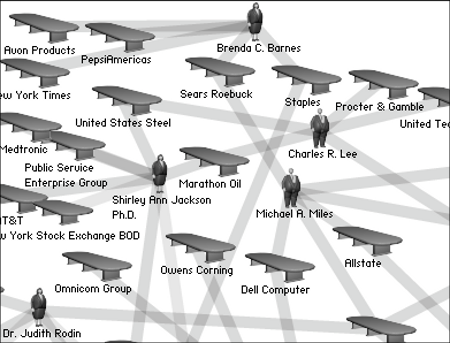
“Go to www.theyrule.net. A white page appears with a deliberately shadowy image of a boardroom table and chairs. Sentences materialize: “They sit on the boards of the largest companies in America.” “Many sit on government committees.” “They make decisions that affect our lives.” Finally, “They rule.” The site allows visitors to trace the connections between individuals who serve on the boards of top corporations, universities, think thanks, foundations and other elite institutions. Created by the presumably pseudonymous Josh On, “They Rule” can be dismissed as classic conspiracy theory. Or it can be viewed, along with David Rothkopf’s Superclass, as a map of how the world really works.”[4]
Bureau d’etudes – distribution.
http://bureaudetudes.org/
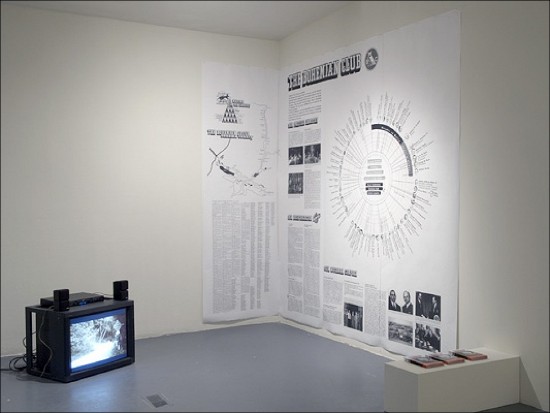
The Paris-based conceptual group, Bureau d’etudes, works intensively in two dimensions. In 2003 for an exhibition called ‘Planet of the Apes’ they created integrated wall charts of the ownership ties between transnational organizations, a synoptic view of the world monetary game. Check the article ‘Cartography of Excess (Bureau Bureau d’etudes, Multiplicity)’ written on Mute by Brian Holmes in 2003.[5]
MG: The sources of data for the Status Project seem to vary in type. Where do you collect them from and how do you collect the different kinds of data?
HB: It ranges from material instruments such as application forms right through to constitutional law and then common sense .
MG: How do you propose the Status Project might be used as a system for ‘identity mutation’?
HB: I want to communicate the fact that people in the UK can create a new identity lawfully without consulting any authority. I intend to illustrate the precise codification of class in the UK system, and there are three clearly defined classes of identity in the UK: human being, person and corporate . I am looking at the borders between these classes and how they touch each other, this can be seen with my status maps. Also, I intend to create aged off-the-shelf persons for sale similar to off-the-shelf corporations.
Taken from the front page of the Status Project:
Lower class human beings possess one severly reduced natural person and no control of an artificial person.
Middle class human beings possess one natural person and perhaps control one artificial person.
Upper class human beings possess multiple natural persons and control numerous artificial persons with skillful separation and interplay.
End of Part 1.
————–
Ruth Catlow, Marc Garrett, Corrado Morgana
Come and celebrate with Furtherfield.org the recent publication of ‘Artists Re: Thinking Games’.
This is an unmissable event for all artists/gamers with a presentation by respected game artist Dr Mary Flanagan, a guest appearance by Jeremy Bailey and a display of some of the gameart featured in the book as well as an introduction by the editors.
Corrado Morgana – About the book.
Ruth Catlow & Marc Garrett – Extra Context.
Guest Speaker – Mary Flanagan.
Guest Appearance – Jeremy Bailey.
Food and drink will be served.
At Birkbeck University of London’s Cinema
43 Gordon Square
Birkbeck, University of London.
London WC1H 0PD
Time 2pm – 4.30pm
Thursday June 10th 2010.
RSVP – contact ruth.catlow@furtherfield.org
Editors Ruth Catlow, Marc Garrett, Corrado Morgana.
Digital games are important not only because of their cultural ubiquity or their sales figures but for what they can offer as a space for creative practice. Games are significant for what they embody; human computer interface, notions of agency, sociality, visualisation, cybernetics, representation, embodiment, activism, narrative and play. These and a whole host of other issues are significant not only to the game designer but also present in the work of the artist that thinks and rethinks games. Re-appropriated for activism, activation, commentary and critique within games and culture, artists have responded vigorously.
Over the last decade artists have taken the engines and culture of digital games as their tools and materials. In doing so their work has connected with hacker mentalities and a culture of critical mash-up, recalling Situationist practices of the 1950s and 60s and challenging and overturning expected practice.
This publication looks at how a selection of leading artists, designers and commentators have challenged the norms and expectations of both game and art worlds with both criticality and popular appeal. It explores themes adopted by the artist that thinks and rethinks games and includes essays, interviews and artists’ projects from Jeremy Bailey, Ruth Catlow, Heather Corcoran, Daphne Dragona, Mary Flanagan, Mathias Fuchs, Alex Galloway, Marc Garrett, Corrado Morgana, Anne-Marie Schleiner, David Surman, Tale of Tales, Bill Viola, and Emma Westecott.
In collaboration with FACT – http://www.fact.co.uk
http://www.furtherfield.org
http://www.http.uk.net/
Publisher: Liverpool University Press (31 Mar 2010)
Language English
ISBN-10: 1846312477
ISBN-13: 978-1846312472
http://www.amazon.co.uk/gp/offer-listing/1846312477
.re_potemkin is a crowdsourced re-make of the film “Battleship Potemkin”. It is a “.f.reeP_” project by .-_-., part of a series of projects that embrace the ideology and means of production of contemporary media and technoculture in order to make art.
From December 2006 to January 2007 .-_-. worked with 15 groups of students from Yildiz Technical University to reproduce Battleship Potemkin on a shot-by-shot basis. Not all shots were reproduced, there are empty black sections in the new film. The students and the setting of the university and its surrounds are very different from the locations and actors of Battleship Potemkin. The domesticity, institutional backdrops and modern street furniture would be very different from the 1920s Soviet backdrops of the original even if they weren’t in colour.
Soviet film-maker Sergei Eisenstein’s “Battleship Potemkin” (1925) is a classic of early 20th century cinema, a piece of obvious propaganda that both fulfils and transcends its instrumental purpose with its exceptional aesthetics. Its most famous images have become cultural icons and cliches. If you haven’t seen it then ironically enough it’s on YouTube so you can watch it there and go “oh, that’s where that came from…” before we continue. Or you can watch it in the side-by-side comparison with .re_potmkin on the project’s homepage.
The Soviet dream became (or always was) a nightmare, an ideology that sacrificed many millions of lives in order to maintain its fictions. Our contemporary liberal democratic society regards itself as unquestionably morally superior to communism for this and many other reasons. The (self-)defining difference between Soviet communism and liberal free-market capitalism is economic ideology. Free markets benefit individuals by reducing inefficiencies.
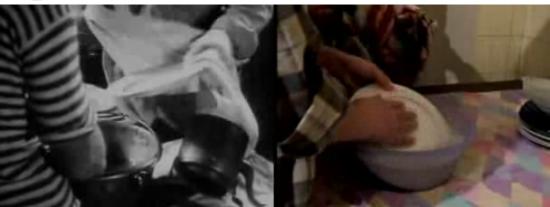
As free market capitalism has triumphed its means of production have evolved. Corporations emerged as a leading way of organizing labour, leading to utopian social projects in the West in the same era as Eisenstein was working in the East and later to a burgeoning middle class in the post-war era. But since then corporations have become increasingly unapologetic exploitative economic projects.
In order to cut costs and become more economically efficient, corporations can become virtual. They shed jobs to reduce payroll and other costs associated with actually employing people. They then source cheaper labour and production from outside, paying other companies to make the branded goods that the corporation sells. This is known as outsourcing.
A logical next step in corporate cost reduction is to source labour from individuals without paying for it at all. This is known as crowdsourcing. Although individuals who donate their labour to a corporation through crowdsourcing might not be compensated monetarily, they can still be compensated in other ways.
With crowdsourced intangible goods the best way of rewarding people who donate their labour to produce those goods is simply to give the resulting product to them under a licence that allows them to use it freely. Non-profit projects such as GNU and Wikipedia do this very successfully, but corporations are always tempted to try and privilege their “ownership” of other people’s work. Where crowdsourced labour is exploited without fair compensation this called sharecropping.

.re_potemkin is a non-profit project rather than a corporation, and as such it has adopted a GNU or Wikipedia-style copyleft licence. Or at least it claims to have. In a creative solution to the fact that there is more than one copyleft licence suitable for cultural works, .re_potemkin’s licence is a kind of meta-copyleft. Checking the licence page reveals that .re_potemkin’s licence is more a licence offer than a licence.
This avoids the politics of imposing a choice between competing copyleft licences on the producers and consumers of the work. The only problem with this approach is that adaptations of the project, works that build upon it, may end up unable to be combined and built on further because they have been placed under incompatible licences. This is unlikely to happen, but it can be very frustrating when it does.
.re_potemkin is crowdsourced equitably, then. And even in its technical form, .re_potemkin is a free and open resource. it is distributed not in a patent-encumbered, proprietary format such as Flash or MP4 but in the Free Software Ogg Vorbis format. Too few artistic projects follow the logic of their principles in this way, instead sacrificing principle to the at best temporary convenience of the proprietary YouTube or QuickTime distribution channels.
The politics of the production of an artwork are only of aesthetic (rather than art historical) interest if they intrude into the finished artwork. A crowdsourced artwork such as the Sheep Exchange is about crowdsourcing as well as being made by it. The aesthetic of that work (many differently styled drawings of sheep) raises the question of how and why it was produced and this feeds back into the aesthetic experience.
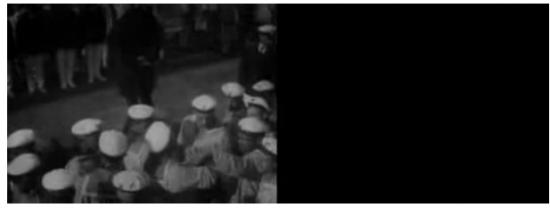
.re_potemkin does not follow the classic crowdsourcing model of an open call for volunteer labour on the internet. It was produced by many groups, but in a closed community. It functions more as an allegory of crowdsourcing than as a literal example of it, but this adds to the project artistically, creating a layer of depiction. The means of production are aestheticized in a way that presents them for the viewer’s consideration in way that can be understood and contemplated more easily than an amorphous internet project.
The “commons based peer production” of free software and free culture is not, to use Jaron Lanier’s phrase, “Digital Maoism”. But the comparison is a useful one even if it is not correct. Utopianism was exploited by the Soviets as it is exploited by the vectorialist media barons of Web 2.0 . re_potemkin gives us side-by-side examples of communism and crowdsourcing to consider this comparison for ourselves.
Within the work the similarities and differences between the original film and its recreation vary from the comical to the poignant. Students in a play park acting out shots of soldiers on a warship, hands placing spoons on a table cloth, crowds gathering around notice boards. This isn’t a parody, it’s an interrogation of meaning. And it is a strong example of why political, critical and artistic freedom is at stake in the ability of individuals and groups other than the chosen few of the old mass media to organize in order to refer to and reproduce (or recreate) existing media.
The text of this review is licenced under the Creative Commons BY-SA 3.0 Licence.
Playing Hard: Urban Art Games of Summer 2010.
Not long ago, urban games were a kind of novelty. Some grew out of the street performance tradition of live theater. Some came from gamers who were involved in tabletop RPG and wanted to experiment with live reenactment. Others were produced by media artists as a way of experimenting with new technologies like GPS and text messaging. But along with these approaches to play, and at times learning from their carefree attitude towards entertainment, there grew another tradition of the urban game, a tradition of using the city focusing on exploration, and as a specific kind of critique. At its worst, the artist produced street game replicates of hollow self-promotion, through corporate, sponsored seasonal festivals. But just as experimental art can involve an analysis of mainstream art, the urban game can embody a palatable critique of the routines of city systems, including the deadening routines of metropolitan life and some of the large scale mechanisms of corporate capitalism.
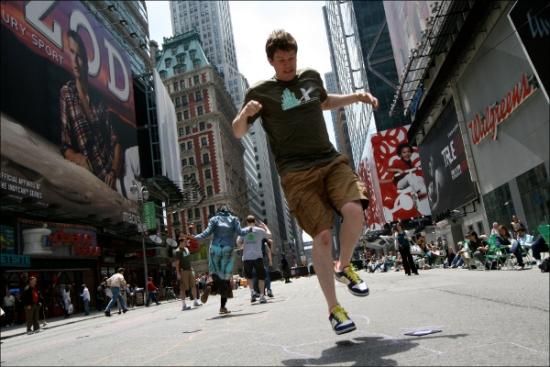
These kinds of games echo the spirit of the Situationist International, which called on artists to create alternate experiences through the construction of situations, psychogeography, and the use of play as a form of critical thinking. Urban games can also remind us of Hakim Bey and his idea of a Temporary Autonomous Zone by using goals, rules, and play with the creation of the ‘magic circle’, a world inside a world, as a method of directing public imagination towards an alternative presence, a way of acting and existing as an independent community within a larger, more repressive reality, even if only momentarily. Urban games also continue the Fluxus idea of the ‘happening’, a participatory media form in which audiences support artists, moving beyond the role of observers of performance to become collaborators in events. With the urban games season about to begin, this review takes a look at how several groups, either consciously or at times not so consciously, have interpreted these traditions for summer 2010.
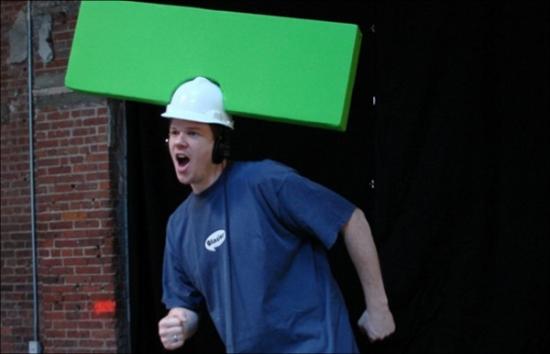
In New York, the much loved Come Out and Play Festival will run from June 4th through June 6th, with events scattered throughout the city borough of Brooklyn. Games include playground mods, GPS exploits, extreme sports, narrative quests, and massively multiplayer scavenger hunts. The festival hosts about forty game designers from around the world and about two thousand people will attend. Executive producer Greg Trefry says COaP strives to be entertaining and is not so much concerned with philosophy as it is with place: “Where the festival is located each year is actually really important to us. We look for interesting parts of the city to experiment on and use as the stage for the festival. So we’ve played everywhere from big anonymous urban areas like Times Square to now more family oriented locales like Park Slope.”
Still, the designers of COaP seem to have a way of engulfing serious issues with comedy and encouraging people reclaim neglected parts of the city by giving them a second look. Along these lines, Atmosphere Industries of Toronto will present Gentrification, a game that picks up on Brooklyn’s ongoing housing conflicts by asking players to assume the roles of real estate developers or neighborhood locals while collecting properties and gentrifying neighborhoods. Meanwhile, Gnarwhal Studios of Baltimore will sponsor ‘Humans vs. Zombies’, a modification of the playground game tag that introduces large groups of strangers to one another by sending players out into the city as the walking dead.. It’s hard to sit in a park, completely shut off from everyone around you, during a two hundred person simulation of a zombie attack. Also part of COaP, New York’s Crux Club will confront community fears of toxic contamination through their game ‘It Lurks in Gowanus’, a hide-and-seek mod that asks participants to track down a creature who has ominously escaped from legendary pollution of the neighborhood’s Gowanus Canal.
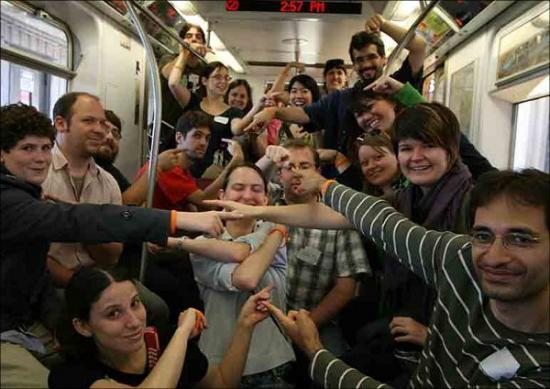
Although he agrees that all urban game events take some kind of cue from historical antecedents like the Situationist International or Fluxus, producer Trefry resists making a formal connection between these movements and COaP. Instead, he says, the main concern was and continues to be community building, getting people together in a surprising way and in an unexpected space: “At its heart, the festival is about running around outside and having fun with your friends. It sounds silly, but that’s such an amazing thing to experience.” This goal of community building has caused COaP to inspire other urban games festivals, including the Hide & Seek Festival in London and the igFest in Bristol, and the Steel City Games Fest in Pittsburgh. The organized versus the random, or the juxtaposition of the carefully designed structure of a game with the largely unstructured, seemingly arbitrary activity of ordinary public space continues to be a common interest among COaP design groups, which are likely to include engineers, academics, and urban planners alongside artists and actors.
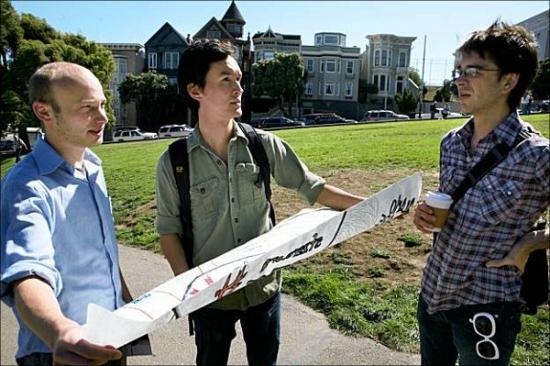
In San Francisco, the artists of SFZero cite Situationism and Fluxus as fundamental to their practice. The SFZero collective was founded by Ian Kizu-Blair, Sam Lavigne, and Sean Mahan in January 2006. Initially, the group used something like a Fluxus process of writing instructions for happening-like events that teams of other players acted out. Soon, these collaborations became the basis for both an online community and real world urban games network that now include over five thousand players. Through the SFZero website, participants initiate events by challenging other participants to ‘Eat a food that frightens you’, or ‘Go to a street corner of your choosing and wait for something fantastic to happen.’ SFZero seems to agree with classic Situationist objectives. A good game shifts awareness, Kizu-Blair says, changing the city for the people who play: ‘Oftentimes the players report that they have a completely different experience of the urban environment as a result of playing and go to places in their city where they have never been before. There is a cinematic quality whereby players live out experiences that normally exist only in spy movies – chases down dark alleys, chance meetings, etc.’ Typical SFZero tasks range from exploring overlooked locations in the city to taking a chance on meeting new people.
As fantastic as some of these instructions sound, and as important as the Internet is to SFZero’s success, Kizu-Blair says it is essential that some productions have a real world component: ‘As people become disenchanted with eight plus hours per day of screen time, they are increasingly gravitating towards hybrid activities that bridge the space between the virtual imaginary and the physical real world. These activities blend the safety and simple pleasure of screens with the risk, tension and excitement of physical interaction. More and more, members of our society will seek to escape from escapism towards an ethics of action, to escape from movies to real experiences. They will find that they have little idea how to have real experiences after their time in the imaginary. SFZero is the transition. ‘SFZero offers both real-world excitement and eternal return to the screen, to re-live, re-experience and re-imagine your engagement with reality.’
Recently, Kizu-Blair, Lavigne, and Mahan have begun staging riskier, more elaborate game events like ‘Journey To the End Of Night’, in which runners try to make it through six checkpoints on foot or by public transportation, while avoiding capture by chasers. An early version of Journey actually opened the 2006 season of Come Out and Play. This July, the veteran SFZero player Lincoln will stage a further production of Journey in Los Angeles.
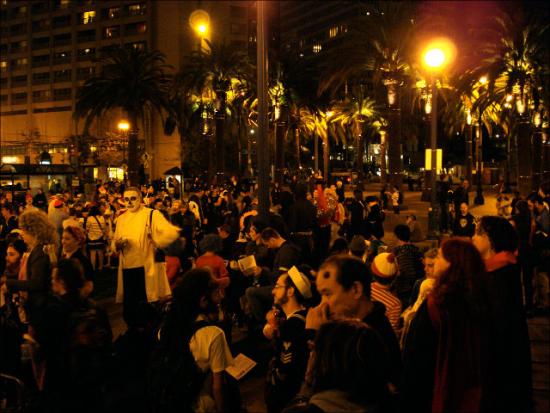
This summer, SFZero will present The Wanderers Union, a game that is loosely based on a French style of self-supported long-distance cycling called randonneuring. To perform Wanderers Union, players get a set amount of time to travel on foot and by public transportation through a series of zones. The idea is to create a single holistic experience of a urban area. The journey intends to juxtapose city spaces in ways that reveal meanings that might otherwise remain unobserved. Players who complete all of the events will progress from an initial four hour wandering to a final twenty-four hour wandering. By using play as a means of gaining understanding, participants will hopefully gain a small degree of mastery over urban space. Kizu-Blair says: ‘It’s like a video game – you level up and gain powers – but you have the added satisfaction of doing something real, and you can include anyone in the experience.’
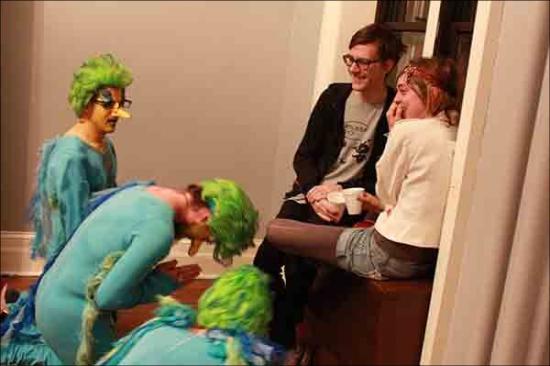
Back on the East coast, the New York based artist’s collective Opt-In found that what started as a thesis project for an experimental film class unexpectedly became a series of multimedia events that now includes filmmakers, fine artists, dancers, performers, and musicians. Titled ‘ZeroDay Exploits’, these evenings are the work of Bryn Jackson, Sarah Lerner, and Nathaniel Barker, who says the group has adapted the Fluxus concept of “happening” to the 21st century: ‘We create immersive environments in which strangers and friends can form new communities around a project, an idea, or a simple good time. We bring people from all walks of life together by promoting open dialogue and the creative expression of public discourse through a vast array of mediums and the use of public space.’
Past themes for the Opt-In exploits have included faith and technology. This July, the group plans to explore the idea of “home” by inviting guest artists and guests to contribute items and materials that evoke a sensation of home. The goal of this event is to create a sense of rootedness in New York, a city of perpetual resettlement. Another major goal for Opt-In is the deconstruction of the digital experience through live performance. According to Barker: ‘Our focus has always been on participation, so our events offer multiple means for encouraging visitors to get their hands dirty including music, secret actors to stimulate conversation, inclusive performances, and free art materials for spontaneous art creation.’
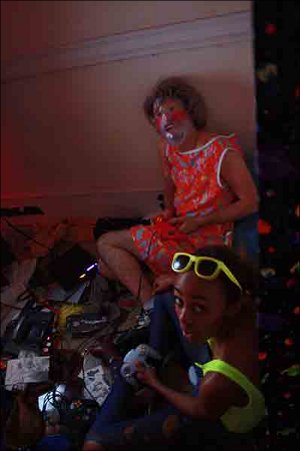
Also related to Fluxus, but in a gesture that seems more directed towards the Brazilian director Augusto Boal, a group calling themselves Invisible Playground Berlin, uses the urban game as a kind of political visualization. Founded by the artist known as Sebastian Quack Sebastian, this group’s interests lie at the intersection of theater and digital gaming. In ‘F Be I, See I A’, Invisible Playground re-enacted peer-to-peer communication as a giant game of urban capture the flag. Later, in Space Station Escape, the group simulated the release of an alien virus inside a phantom space station supposedly docked underground beneath Alexanderplatz.
Sebastian views missions and rule sets as ‘experience systems’, Games are a kind of participatory appropriation, an interrogative code that is placed over or enacted within an existing urban mechanism. In other words, if you want to get people to think more critically about the way immigration works in your city, you’d design a game that plays with the existing locations, activities, and mechanisms of immigration. In this way, Invisible Playground intends to put forward what otherwise goes unnoticed, tolerated, or is even passively accepted. Sebastian is careful to structure his rule sets in ways that highlight the power structures that arise between groups of players, between players and their environments, or between players and organizers. According to the Schwellenland site: ‘Players must work together and against each other. Over SMS and email you are guided to appointments and arrive at places where you were barred from entry until now. The game asks you to decipher who is legal, who is questionable, who can be trusted, who will trust you, who observes you, what should be ignored, what is critical. You are accompanied by a coach and by referees who left the usual national borders behind long ago and are now in Vienna as refugees without papers. These specialists can help you to master the challenges of being from a developing country. But they have also power to turn on you if you make too many errors.’

Finally, with a practice based in both New York and in Brazil, Adriana Varella is one of the artists behind the AnarkoArtLab, a collective of new-media, visual, dancers and genre benders in residence at the Living Theatre. Each month, Anarko creates a multimedia event that runs as part lab, part performance. This summer, the group plans to become mobile and to bring the Lab to different situations and neighborhoods. ‘We are searching,’ Varella says ‘for a last trace of that most ephemeral and elusive state where only a dusty dystopian haunting may yet remain. ‘Of course,’ Varella says, ‘all of them, Dada, the Situationists, Fluxus they are all our ancestors.’
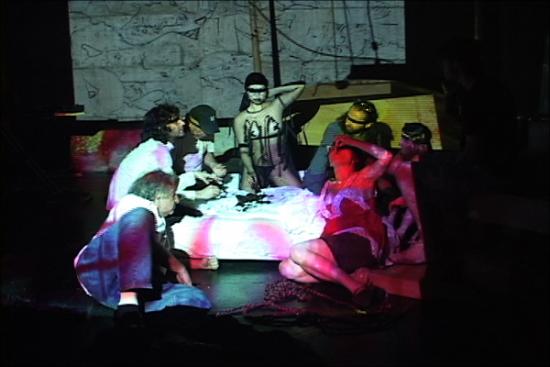
Meat Space and the World Inside the Machine
Danja was an Artist in Residence at Furtherfield’s HTTP Gallery space between the 1st March – 9th April 2010. A Russian born computer artist currently living between Berlin and Rotterdam. Working with diverse methods, technologies and materials Danja ridicules the contemporary affection for digital life and questions the global tendency for cyborgination. Danja co-founded media-lab moddr_ in 2007 which is a joint project at Piet Zwart Institute alumni and WORM Foundation. Based in Rotterdam moddr_ is a place for artists and hackers, engaging with critical forms of media-art practice.
The email interview took place a few weeks after his residency. A recent collaborative project that many readers may already know of, by Danja Vasiliev, Gordan Savicic and Walter Langelaar, all part of moddr.net lab is, Web 2.0 Suicide Machine, which lets you delete your social networking profiles and kill your virtual friends. Danja is certainly prolific, he is also collaborating with New Zealander artist, Julian Oliver who is now based in Berlin. This interview unearths some of the ideas and intentions behind Danja’s personal works, asking what motivates him to use computers, technology and networks, as well as understand more the social contexts and implications of his endeavors.
Marc Garrett: You’ve been on the residency at Furtherfield’s HTTP space http://www.http.uk.net/ for a few weeks now. Before we discuss Netless, the project you have been researching here and some of your other recent works, I think it would be interesting to know about some of your earlier works first. Before the turn of the century you made various net.art pieces. What I find interesting here is that whilst you were creating these works you were also parodying net.art at the same time, was there any particular reason for this kind of approach?
Danja Vasiliev: “HTTP” as an abbreviation was a very significant thing for me throughout the last decade, now having to stay at a place bearing the same title feels like a necessary experience indeed. Fifteen years ago WWW was something very new in Russia and besides the new dial-up aesthetics and world-wide means it brought a complete new layer of existence – “netosphere”, which made my youth. I was trying to understand the technology, though not being of a scientific kind I did it by monkeying around with artworks of others. Later I heard it was called “Open Source” approach. The Website “koala.ru” http://koala.ru.k0a1a.net became a collection of expressionist pages, each page had its own story and often a narrative. Back in the day my arsenal was naturally limited: HTML3, GIF89a (animated) and JavaScript1.2. It felt challenging to work with those tools, file-size was aesthetically just as important as letter-case, and I liked it… I haven’t changed any of the pages since 2002, iirc. The greatest source of my inspiration (image and code -wise) of that time was the baddest of all Superbad – I loved the wackiness yet elegance weaved into the piece. My attraction to /random redirect/ comes from there.
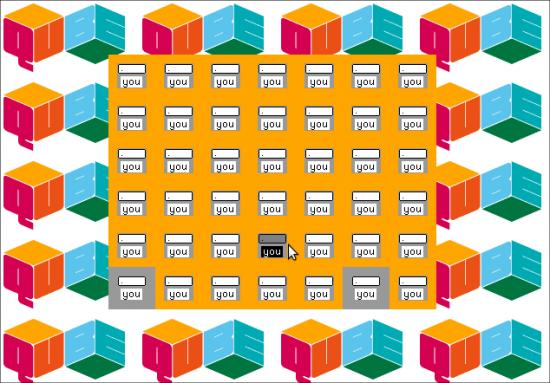
MG: What draws you into using computers in your art practice?
DV: It must be the conflict between the everyday technology and digital life. I’m exploring that edge between the meat space and the world inside the machine. Machine in this case is not just a PC – a single computer is only a part of the network. Acting on those parts adjusts the behavior and perception of the whole – I’m interested in that. Computer hacker attitude and methods are very influential, my works are often merely illustrations of those technological interventions. It makes much more sense to me to try to confront or challenge the technology (and the users) rather then to celebrate the achievements. ‘IT’ today is what politics were yesterday – it and its aesthetics owe to be questioned, broken into pieces, interrogated, sabotaged, reflected upon and ridiculed.
MG: On the NETTIME list on 1st July 2008, Eric Kluitenberg wrote an intriguing essay about your work titled “Turning the machines inside out”.[1] He also discusses something which is close to one of my own interests, about the world as a kind of Interface, metaphorically, virtually and materially “The world according to Rossler is defined by that what transfers between the observer and the “real” world at the interface. It is the interface to the world that defines what can be observed about the “real” world.” Kluitenberg.
Before we talk about Kluitenberg’s concepts regarding his thoughts around your work, I would like to know what your own considerations are in respect of the “World as Interface” and what this means to you?
DV: Well, it always surprises when I come across some theoretical implications confirming, destroying or otherwise connecting to my own work. Perhaps that is why I got to be a maker rather then a thinker – I could never describe the topic I was covering with m/e/m/e 2.0 in a such a profound way as Eric Kluitenberg did. However incapable of posing a verbal question, my intention was indeed to discuss and demonstrate that effect of alienation created by the very medium (or shall I say the interface) of the Web. A System that promotes itself to the users as a fair substitute for reality and provides services for talking, seeing, being and so on, yet fails to escape its own binary jail, i.e. fails to become indeterministic. This determined interface creates determined world – web applications are uploaded straight into our brains. In my perception what we are seeing now is rather reversed or multiplexed inclination of “World as Interface” idea, when devices used for participation in-World and auxiliary systems created around to assist the process, all of this _is_ the World for its users.

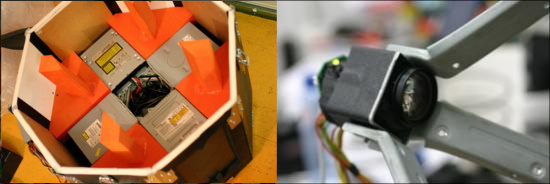
MG: Kluitenberg in his essay, viewed your m/e/m/e/2.0 to be part of a tradition “(inadvertently or not) in the best company of a long tradition of “avant-garde” artists who created various sorts of absurd, ironic, impossible, sadistic, insane or ridiculous machines. His likes are the creators of ominous bachelor machines (Duchamp, Lautreamont, Picabia, Roussel, Kafka), self-destructing machines of the Tinguely type, right down to the magically autistic robotic anti-sculptures of Allan Rath.”
For me, what links m/e/m/e/2.0 to our contemporary world and its ever increasing networked existence “and what we know it to be now” is, its playful and direct link and reference to the Internet. It could not be what it is without the Internet, in which millions have been and are still being taught how to adapt and reconfigure relationships with others, and ourselves. We have become part of the networked driven interface via this socially engineered activity. Would it be presumptuous of me to consider m/e/m/e/2.0 to be a kind of portrait, or a physical re-representation of the human mind or perhaps “head”, metaphorically?
DV: m/e/m/e 2.0 is a manifestation of the absence of any human traits in an act of network communication. Of course it is impossible to demonstrate this without the involvement of the main suspect – the object, the sculpture – is only a half of the work, another half is the Internet. Whenever the piece is not online – it is not complete, and as such – kept in a wooden crate. What “m/e/m/e 2.0” ultimately represents is the physicality of the fellow Internet user on the other end of the wire. It is a device that converts digital instances (copies) of netizens into humanoids, adding flesh around immaterial skeletons. By the analogy to what’s known as “modem” (MOdulator-DEModulator, a device used for digital communication over analog, physical mediums), “m/e/m/e 2.0” is a “semi-modem” or just “mo” without “dem” – it materializes (modulates) without caring to convert back into binary format. It lets the users enjoy their own bodily presence while online; much like the famous FuFme device only with some corrections to the current state of things.
The machine of m/e/m/e 2.0 allows its visitor to sense not only the surfaces of the system but also to get into an strange relationship with the concurent users. The $USER begins to understand intimacy over a distance. The mechanical body can not be re-multiplied to a spontaneous number of requests, instead all of the users come to share one analogue broadcast medium. Whenever someone clicks to open a new link, the information is transmitted to all connected users, “meshing” and colliding their sessions. Seemingly a constraint becomes a feature – unbodied cyberspace gets filled with physical presence. The consequence is that it turns web browsing into a broadcast, collective group activity without any predefined rules. Each page is a part of info-system contained with-in m/e/m/e 2.0, all pages are hyper-linked into a mesh that has no beginning or end.
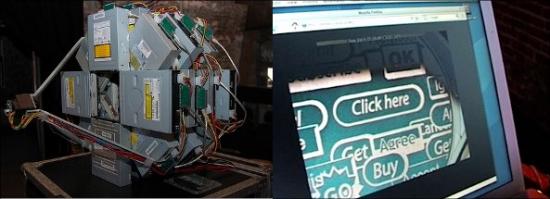
MG: During your residency here in London, you worked on another project called Netless. Could you explain what the project does and why you have chosen to embark on such a venture?
DV: I’m researching a digital communication strategy or technique that would be free from the “panoptical” effect of the Internet. It is too easy to observe and trace users connected to the global network – partly because of the way it is structured, as well as its reliance on the corporate communication channels. It is something about “net neutrality”.
Netless is an attempt to create a new network, alternative to the Internet. More precisely – networks within existing city infrastructures, possibly interconnected into a larger network alike the Internet. Netless is not dependent on specialized data carriers such as cables or regulated radio channels. In fact, there is no permanent connection between all of its hosts (peers) at all – it is net-less. The network is based on the city transportation grid, where traffic of the vehicles are the data carriers. Borrowing the principals from the Sneakernet concept, the information storage devices are physically moved from point A to point B. Numerous nodes of the netless network are attached to city buses or trams. Whenever those vehicles pass by one another a short-range wireless communication session is established between the approaching nodes and the data they contain is synchronized. Spreading like a virus, from one node to another, the data is penetrating from the suburbs into the city and backwards, expanding all over the area in the meanwhile. That broadcast data can be picked-up by anyone.

…the similarities between city transportation maps and circuitry of modern networks are not accidental. their purposes are identical – to provide efficient transport flow between all the locations of the area they cover. routes are designed to match the necessary throughput without congesting at peak times. D.Vasiliev.
MG: What kind of information will be shared within a “Netless” system? Also, are these ad hoc mini-networks going to be attached onto vehicles as secret transmitters?
DV: Constrained by the bandwidth limits Netless networks will work most effectively when dealing with short messages. Technically speaking – “ascii” text, or short base64 encoded binaries/images. Textual data is playing well together with human brains – we often do not need to read a complete sentence to understand the meaning – this would be a great way of keeping the data traffic down. If an error occurs during the transmission of a text message, it can be easily “repaired” by the recipient’s brain – less work for hardware, more information can come thorough. The Netless network integrates into the citizens’ living infrastructures, its data-processing and error-correction routines are outsourced to the users. This is a “hybrid” (parasitic) system, it requires the “human” as resource in order to function.

It would be very interesting to collaborate with some city transportation company, like the one that runs all the buses across London, Arriva. It blankets all areas pretty well as I discovered during my residency at HTTP and if every bus would carry a “Netless” node – the performance would be amazing. That said, it wouldn’t be smart to make “Netless” depend on any commercial entity. Instead I’d rather encourage people to follow up on the project development and start putting together their own “Netless” nodes and take those on everyday travels within the cities. The strength (and bandwidth) of any mesh-network grows proportionally to the amount of nodes involved into the network, thus – (random) network maintenance is the sole responsibility of its users..

MG: This idea of independent nodes/activities of communication, asking us to consider the notion of what it would be like to be “off the grid”; is an important issue. It reflects wider concerns around individual freedoms and civil liberties, in an age where corporations are channelling our everyday digital behaviours towards, a more “official” form of mediation. Where top-down, imposed digital infrastructures are dominating the interface of who our digital, data-bodies are, whilst having control and access to our content, not on our terms. It also reminds me of the battle between pirate radio and institutionally implemented radio broadcasts, as in who owns the medium and what is perceived “correct” information when sharing with others?
DV: Definitely, reclaiming the medium (or the net-space for this matter) does not happen on paper or during some international conference on the topic of net-neutrality. Such changes in disposition of the forces – corporate state on one hand and personal interest/freedom on other is a tedious process; approached top-down it might take ages to complete. Revolution starts on the streets! Rather than having endless debates and explaining to the officials about how and why “Inter Net” is different from “Closed Circuit Tele-Vision”, we respond proactively, ahead of the regulations; creating our own communication strategies. I see my role here in exemplifying the conflict and its resolution.
MG: To the more traditional art practitioner out there who may not be so dedicated or as involved as yourself, in using computers and technology as part of the creative process; how do you manage to keep the balance, maintain the essence of what you do, as art?
DV: I’m for sure not “doing art”. I reflect on certain things, certain events, topics. Those often happen to have technological origins – nothing very surprising nowadays. My works are somewhat “improved” versions or “hacks” of our every-day technology and thus – our life. It is an essential thing for me to work with the same means as the means of the subject of my criticism – e.g. /misuse/ a piece of technology to demonstrate its other potentials; it is a more constructive approach.
MG: What other projects can we expect to see in the future other than what we have discussed so far?
DV: More technological interventions… and I was also thinking of building a railway model! People should check http://k0a1a.net more often.
MG: Will do, and thank you very much for the conversation…
DV: Thank you, nice chatting…
—
danja vasiliev
http://k0a1a.net
Danja was also interviewed by Marc on a Furtherfield, radio broadcast 6th April 2010 – Resonance FM. http://www.furtherfield.org/resonancefm.php
From September 2008 – June 2010, Ellie Harrison undertook a Leverhulme Scholarship on the Master of Fine Art programme at Glasgow School of Art. The thesis published below forms one of the major outcomes of her research during this period. This is part one of four.
The thesis published below forms one of the major outcomes of her research during this period and builds on two earlier essays How Can We Continue Making Art? – which questions whether there is a place for art in a world which is fast approaching environmental catastrophe, and Altermoderism: The Age of Stupid – which uses Nicolas Bourriaud’s Altermodern exhibition at Tate Britain in 2009 as a paradigm for exploring the art world institution’s lack of acknowledgement and action over climate change.
Trajectories: How to Reconcile the Careerist Mentality with Our Impending Doom addresses the ethical implications of continuing to choose the career of artist in the twenty-first century. It is a manifesto of sorts, written from the personal perspective of a young UK-based artist looking to identify worthwhile reasons for continuing down this ‘self-interested’ path, given that the future we are likely to face as a result of climate change, is so different from how we dreamt our careers might pan out whilst growing up under Thatcher and New Labour. It explores how we should aim to evolve our roles as artists, in light of this, and what form a new ‘reconciled practice’ might take.
The graph below shows the projected average global temperature increase over the forthcoming century if we remain on our current trajectory of economic growth and population increase (peaking at 9 billion in 2050), but also incorporate new efficient technologies, a convergent world income and a balanced emphasis on energy sources. This is known as the Intergovernmental Panel on Climate Change’s ‘scenario A1B’ (IPCC 2001).
The graph is extracted from the official AVOID response to the United Nations Climate Change Summit in Copenhagen in December 2009 published on 26 March 2010. AVOID is a United Kingdom governmental research programme led by the Met Office with the aim of averting dangerous climate change (AVOID 2010).

Looking back, 1979 now emerges as a pivotal year in the recent history of our species. On 6 October this year the US central bank, the Federal Reserve, increased interest rates by 20 points (Fisher 2009, p.33). This act, which on paper appears of little significance, opened the gates to a whole new breed of free-market capitalism which, as a result of reduced regulation, would spread its way all over the globe. It signified the switch between Fordism and post-Fordism as the predominant economic system of production; from the ‘disciplinary societies’ of late modernism characterised by Foucault, to the ‘control societies’ which constitute our present reality (Deleuze 1990). It was the beginning of a carefully choreographed and intricately planned neoliberal project, which would serve the “restoration or reconstitution of naked class power” (Harvey 2007, p.119) to an economic elite; radically transforming the way in which all our lives would operate in its wake. Our attitudes towards work, politics, society; our relationships to one another, even the internal structuring of our own minds, would never be the same again.
It is no coincidence that it was on 4 May 1979 that Margaret Thatcher came to power in the United Kingdom; she was, of course, instrumental in overseeing this ‘revolution’. What is coincidental however is that it was also in 1979, on 11 March to be precise, that my own life began its trajectory. The rapidly changing society into which I was born would not only prove fundamental in shaping the artist I would become, but it would also prove key in determining the ‘mentality’ with which I would come to visualise my future: to plan my career.
‘Thatcher’s children’ as my generation are known, were indoctrinated to believe that the world owed us a living (Blackburn 2009). “Success”, she said, was “a mixture of having a flair for the thing that you are doing; knowing that it is not enough, that you have got to have hard work and a certain sense of purpose”. It was simply a question of making the right career choice. If we aimed for the top, we had just as much chance of getting there as anyone else. All we had to do was look out for number one. The secret, she taught us, was to have a strategy – to “plan your work for today and every day, then work your plan” (M. Thatcher n.d.); to think about what we wanted our lives to be like in the future and then to work flat-out towards that ‘goal’.
In hindsight, it now seems inevitable that my life took the course it did. Entering art school for the first time in 1997 – the year the seminal Sensation exhibition at the Royal Academy of Arts took place – we could see ‘success’ being played out before our very eyes. A group of Young British Artists (YBAs), just one generation older, were now ‘living the dream’. As 18-year-old students, we were now able to visualise the paths we wanted our own lives to take and to see exactly where we aimed to find our fortune. Like most of my art school peers, I was from an “above average social background” – raised in suburbia by a middle class family of teachers. And, as Hans Abbing notes, this added “social capital” gave me the “flair, self-assurance, and… sense of audacity” (Abbing 2002, p.95) which now seemed so essential to commodify and sell myself – to keep going, regardless of failure and rejection, with eyes firmly fixed on the prize.
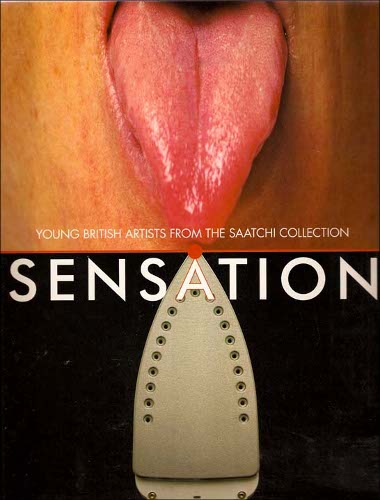
My career trajectory led me blinkered along a familiar path – a BA (Hons) degree in Fine Art from Nottingham Trent University; a Postgraduate Diploma in Fine Art from Goldsmiths College (where nearly all my YBA role models had been before me). It was as though every incremental step took me ever closer towards my ‘goal’: towards ‘success’. Finally, I won a scholarship to study on the Master of Fine Art (MFA) programme at The Glasgow School of Art; yet another prestigious art school to add to my expanding curriculum vitae. What I hadn’t banked on, however, was that on the very same day I was heading north up the M1 to Glasgow to begin this new stage in my life, the global economic order was fast collapsing around us into its own new distinct epoch, taking with it the belief systems which had been carefully constructed around it over the past 29 years.
On 15 September 2008 the investment bank Lehman Brothers Holdings Inc. filed for the biggest bankruptcy in US history with more than $600 billion of debt (Mamudi 2008). Over the course of the next year a slew of bailouts took place all over the world to prevent other banks going under. The neoliberal project had, “in every sense, been discredited” (Fisher 2009, p.78). The ideology on which, knowingly or not, my own life’s trajectory had been modelled was now on the ‘scrapheap’. And, as Mark Fisher suggests, a bleak, empty and relentless state known as ‘capitalist realism’ – in which nobody could believe, but equally nobody could stop – crept in from every corner to fill the void.
Society, it seemed, had reached a hiatus; a ground zero amid a sea of “ideological rubble” (Fisher 2009, p.78). Lots of suggestions emerged about what had gone wrong, lots of questions about where we should go next. From the privilege of my funded MFA place, I was able to enter into my own period of self-reflection about the path I had so blindly been following. Was the vision I upheld of my life in the future essentially a delusion, based on a now defunct model of ‘success’ from the past? Was I suffering from the “self-deceit” (Abbing 2002, p.114) Hans Abbing diagnoses to be prevalent in young artists, coupled with the complete “disavowal” (Fisher 2009, p.13) of the negative side-effects of my complicity in the system of capital? With a sudden and overwhelming urgency it felt essential that I question how I could begin to reconcile my career choice and the entrepreneurial methodology (Abbing 2002, p.96) with which I was pursuing it, with the harsh realities that both science, and now science fiction, are predicting the future actually holds in store…
Films such as The Road (Hillcoat 2009) offer us a very different picture of the forthcoming century. In this barely hospitable, yet eerily recognisable version of our present world there is no Turner Prize, no Frieze magazine to be reviewed in; no canon to become part of. In fact, there is no scope for the non-essential; no room for aesthetics; no space for art at all. Whereas it now appears clear that the trajectory I had planned for my life since art school is constituted by fantasy, the trajectory which befalls the lives of the protagonists of this particular post-apocalyptic vision is in part based on what the current overwhelming scientific evidence points towards.
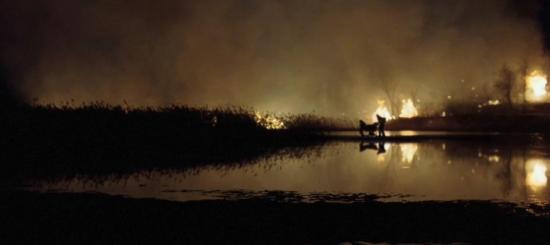
The United Nations Climate Change Summit which took place in Copenhagen in December 2009 offered what many scientists and campaigners referred to as our ‘last chance’ of averting global catastrophe within the coming century. Prior to the talks the 10:10 Campaign’s ‘call to arms’ statement outlined what sort of trans-governmental worldwide commitment it would be necessary to achieve:
“The best deal currently on the table is that from the EU, which calls for a 30% reduction [in greenhouse gas emissions] by 2020 (compared to 1990 levels). If this deal were to be accepted (which is a very big if, given that Japan argues for 8%, Australia for 5% and America for between 0%-6%) and if the emission cuts were then carried out (which is an even bigger if), this would give us about a 50/50 chance of not hitting the dreaded two degrees. Two degrees is where we trigger runaway climate change [emphasis added]: two leads to three, three to four, four to five, five to six… by which time it’s about over for life on Earth.” (Armstrong 2009b)
Given that Copenhagen was by all accounts a complete failure and that, in fact, not even the least significant of the ‘deals’ presented was agreed upon and signed off, the balance now appears to be swaying decisively towards the latter of these two potential trajectories. We find ourselves “trapped inside a runaway narrative, headed for the worst kind of encounter with reality” (Kingsnorth & Hine 2009, p.11). Unless it is fully acknowledged and hastily acted upon in consensus across the globe, climate change “threatens to render all human projects irrelevant” (Kingsnorth & Hine 2009, p.6). It appears that it is not just the future of our careers we should be worried about but now, more likely, the fundamental ability of our species to survive on the planet.
The concern of this essay is to uncover exactly how we could have arrived at a situation where these two distinct visions of our future can so wildly diverge – to explore the factors which have allowed our careerism to persist, in light of advice to the contrary. The aim is to illuminate the significance of this ‘now or never’ moment in the history of our species as an opportunity for radical change, and to develop a ‘plan of action’ and a ‘new moral code’ which may help us, as artists, determine what role we can and should play in the reality of the twenty-first century.
To read Part 2 of this article visit this link: http://www.furtherfield.org/articles/trajectories-how-reconcile-careerist-mentality-our-impending-doom-part-24
——-
References:
Armstrong, F., 2009b. What is 10:10? 10:10 Campaign website. Available at: www.1010uk.org/1010/what_is_1010/arms [Accessed April 10, 2010].
Abbing, H., 2002. Why Are Artists Poor?: The Exceptional Economy of the Arts, Amsterdam: Amsterdam University Press.
AVOID, 2010. Will the Copenhagen Accord avoid more than 2°C of global warming? AVOID website. Available at: ensembles-eu.metoffice.com/avoid [Accessed May 3, 2010].
Blackburn, S., 2009. Do we need a new morality for the 21st century? The Guardian Culture Podcast. Available at: www.guardian.co.uk/culture/audio/2009/nov/02/cambridge-festival-of-ideas.
Deleuze, G., 1990. Society of Control. L’Autre Journal, (1). Available at: www.nadir.org/nadir/archiv/netzkritik/societyofcontrol.html.
Fisher, M., 2009. Capitalist Realism: Is There No Alternative?, Ropley, Hampshire: 0 Books.
Harvey, D., 2007. A Brief History of Neoliberalism, Oxford: Oxford University Press.
Hillcoat, J., 2009. The Road, Dimension Films.
IPCC, 2001. Special Report on Emissions Scenarios. GRID-Arendal website. Available at: www.grida.no/publications/other/ipcc%5Fsr/?src=/climate/ipcc/emission [Accessed May 3, 2010].
Kingsnorth, P. & Hine, D., 2009. Uncivilisation: The Dark Mountain Manifesto. Available at: www.dark-mountain.net/about-2/the-manifesto.
Mamudi, S., 2008. Lehman folds with record $613 billion debt. MarketWatch website. Available at: www.marketwatch.com/story/lehman-folds-with-record-613-billion-debt?siteid=rss [Accessed April 25, 2010].
Thatcher, M., Margaret Thatcher Quotes. About.com website. Available at: womenshistory.about.com/od/quotes/a/m_thatcher.htm [Accessed May 2, 2010].
To read Part 1 of this article visit this link:
http://www.furtherfield.org/articles/trajectories-how-reconcile-careerist-mentality-our-impending-doom-part-24
What is curious about the neoliberal project that kick-started in the year of my birth, is that, from the politics of the preceding decade, it appeared history could have taken a very different course. 1972 marked the publication of The Limits to Growth – a study commissioned by the humanitarian think-tank the Club of Rome to estimate the planet’s reserves of natural resources, “including topsoil, fresh water, minerals, forests and oceans” – questioning for the first time what might be the consequences of “another 100 years of exponential growth” (M. Fowkes & R. Fowkes 2009, p.670). The findings of the study were so significant that they are cited by Maja and Reuben Fowkes as a revelation for the future of humanity on a par with Copernicus’s discovery of Heliocentrism: putting our lives on planet earth sharply into perspective. Essentially the report gave us all the information we needed to know: that the way of life modernity had accustomed us to, was not sustainable. The whole system on which our modern liberal democracies were structured was supported by a myth of continual and infinite progress (Kingsnorth & Hine 2009, p.3) and a universal belief that the future will always be better than the past – that it is always within our capable hands to control our destinies.
Rather than take heed of this advice and look for alternative ways of structuring our societies, what actually began towards the end of the seventies, continuing right up to the present day, was the opposite: a complete and utter acceleration of our production and consumption. Post- The Limits to Growth our lives were allowed to continue in a fashion now no longer based on scientific facts, but on fantasy:
“What this… illustrates is the fantasy structure on which capitalist realism depends: a presupposition that resources are infinite, that the earth itself is merely a husk which capital can at a certain point slough off like a used skin, and that any problem can be solved by the market… The relationship between capitalism an eco-disaster is neither coincidental nor accidental: capital’s ‘need of a constantly expanding market’, its ‘growth fetish’, mean that capitalism is by its very nature opposed to any notion of sustainability.” (Fisher 2009, pp.18-9)
We were allowed to continue because we repressed this truth. Our ‘denial’ was constituted by what Freud described as our inability to hear the things which did not fit easily with the way we envisaged ourselves in the world (Kingsnorth & Hine 2009, p.9). We simply blocked out any hint of a hitch or obstacle to our career trajectories and carried-on regardless. Neoliberalism achieved this ‘state of mind’ purposefully – by pacifying us with the things we thought we wanted, that would make us happy, whilst removing the possibility for resistance. The “drive towards atomistic individualisation” (Fisher 2009, p.37) captured in Margaret Thatcher’s dictum “There is no such thing as Society. There are individual men and women” (M. Thatcher n.d.), plunged us further into our internal solipsistic worlds; from where it became almost impossible to fully empathise with others, to acknowledge the wider consequences of our actions, to see beyond the fantasy – to believe that ‘an alternative’ might be possible. We lost our political ‘agency’ as our liberal democracies became governments-as-administration (Zizek 2009b); appealing to our burgeoning “individual ideals” (Strawson 2008) – to “short-termism” (Brown 2009) – rather than the bigger picture and a realistic long-term plan.
In his recent book First as Tragedy, Then as Farce, Slavoj Zizek describes the strategies the neoliberal policy makers employed to continue to maintain this state of denial well into the twenty-first century, explaining how the negative side effects of the bursting of the dotcom bubble in 2000 had been countered by a push on cheap loans to stimulate the housing market. This had simply allowed the US to “continue dreaming” (Zizek 2009a, p.20) for that little bit longer; essentially just prolonging the global crisis until a later date: until now.
“It’s useless to wait – for a breakthrough, for the revolution, the nuclear apocalypse or a social movement. To go on waiting is madness. The catastrophe is not coming, it is here. We are already situated within the collapse of civilisation.” (The Invisible Committee 2009, p.96)
The significance of this point in history cannot be underestimated. The hiatus caused by this latest epic crisis of capital should have given all of us opportunity for self-reflection. The connections between capitalism and environmental catastrophe have once again been starkly illuminated and so too has our own complicity in, and responsibility for, both. As the many climate scientists and campaigners have been telling us, we now only have one decade left – until 2020 – to stabilise and begin to reduce our rapidly increasing greenhouse gas emissions or we will be unable to avoid hitting the “dreaded two degrees” (Armstrong 2009b) – the tipping point at which we trigger runaway climate change and a rapid irreversible and uncontrollable descent into a new world of which the visions of The Road are not too much of an exaggeration.
Even mainstream politicians hungry for votes are forced to admit that “the age of irresponsibility is giving way to the age of austerity” (Cameron 2009). It does seem “useless to wait” (The Invisible Committee 2009, p.96). Now provides the opportunity to radically rethink the way we live, not just in practical terms, but in the way our minds perceive of ourselves in the future; of what we are working ‘towards’. We need to reverse our very ontological foundations so that we become capable of comprehending the opposite of progress – of approaching life in a world where deflation becomes the norm and where rationing is “inevitable” (Fisher 2009, p.80).
As artists – the producers of the non-essential – this rethink seems all the more vital and all the more urgent. It is now our ‘responsibility’ to redefine our roles within this new world, within the “collapse of civilisation” (The Invisible Committee 2009, p.96). As we approach the inevitable challenges of the forthcoming century we can no longer be immune to ethics – we must begin to question what practical function our work can have. And, if we decide that we can still persist in our roles as artists, then we must begin to generate new ways of finding “intrinsic motivation” when our traditional motivational structures of striving towards ‘goals’ such as “recognition and fame” (Abbing 2002, p.82); of creating a ‘legacy’ for ourselves in the future, no longer seem viable.

It is typical in periods of crisis (and opportunity) such as this to look to the past for guidance. Retrospective critique (as used to ‘set the scene’ for this essay) helps us to understand the causes of our current predicament in terms of a greater historical trajectory, to help us make sense of our own lives biographically. The real challenge, however, is in developing the suggestions, ideas and solutions that are essential to help us move on. The proceeding sections of this essay turn to two manifestos from 2009 which attempt just this: Ecoaesthetics: A Manifesto for the Twenty-First Century by Rasheed Araeen and Uncivilisation: The Dark Mountain Manifesto. The intention is to draw together their recurring ideas in order to formulate a ‘plan of action’ which may constitute our ‘new moral code’, and then to examine how some of these ideas are already being put into practice, not just by some artists, but by other more radical elements of society.
In September 2009, the international journal of “critical perspectives on contemporary art and culture” Third Text dedicated an entire issue to contemplating a vision of the future of art, in which Araeen’s manifesto is published. In the preface, Araeen and his co-editor Richard Appignanesi give their own diagnosis of the predicament of artists “now as we face a legacy of failures in modern history that endangers the future prospects of humanity” (Araeen & Appignanesi 2009, p.500). Their suggestion is that we have reached a cynical and solipsistic impasse which it is essential to overcome:
“… the very concept of art will have to liberate itself from the two historical limits of containment and legitimisation. One is containment in the artist’s own narcissist ego; the other is art’s dependence for its legitimisation as art on the institutions that facilitate and promote art only as reified commodities placed in museum and marketplace showcases.” (Araeen & Appignanesi 2009, p.500)
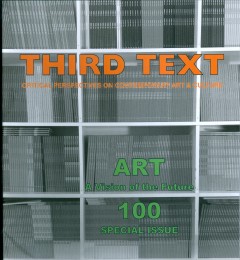
Ego and individualism have always gone hand-in-hand with the relatively autonomous role the artist has historically enjoyed within society, however, it appears that these characteristics have only been exacerbated in recent years. Neoliberal ideology has led to a “convergence of artistic and entrepreneurial values” (J. Thatcher 2009, p.5) – flexible, creative and autonomous modes of operating have been co-opted by the business world, just as ‘the careerist mentality’ has been inherited by artists. Recent mainstream television programmes such as School of Saatchi (Priddle 2009) and Goldsmiths: But is it Art? (Kerr 2010), which pit artists’ egos and entrepreneurial skills against one another, show the extent to which these attitudes have become the norm.
The super-competitive environment of the ‘atomised art world’ engenders a survival instinct in artists which causes us, knowingly or not, to make our sole objective the expansion of our curricula vitae. The emphasis is on the development of a “narrative” – on forming a “brand identity” (Prince 2010, p.10), because this presents itself as the most efficient means to the desired ends of “recognition and fame” (Abbing 2002, p.82). Trapped in a perpetual attempt to impress art world institutions, artists inevitably end up feeding them with the art that they think they want rather than stopping to question exactly what they are producing and why.
In a pre-neoliberal world, choosing the role of artist was seen as an alternative to the mainstream: a point of resistance, a political statement even (Walker 2002) – art offered a potential strategy of “opposition to capitalism” (J. Thatcher 2009, p.6). Now as a small component part in this means / end cycle – art – simply acts an instrument to serve the “career ambitions of self-centred artists” – its “significant critical and social function” (Araeen 2009, p.680) disabled in the process. But, at this particular point in our history, art’s power in “subverting the dominant hegemony” (Mouffe 2007) – in creating an ‘alternative knowledge’ – may be its only redeemable function.
Araeen’s call for art to be liberated from “containment and legitimisation” (Araeen & Appignanesi 2009, p.500) foresees the unprecedented power he believes our ideas could have if completely detached from capitalism:
“It is in fact artistic imagination, not art objects, which, once freed from the self-destructive narcissist ego, can enter this life and not only offer it salvation but put it on the path to a better future.” (Araeen 2009, p.683)
He goes as far as to suggest that artists should “abandon their studios” and “stop making objects” (Araeen 2009, p.684). He urges us to reconfigure our roles to such an extent that our creative skills are put to use in conceptualising real-life practical projects, such as creating solar-powered desalination plants, which simultaneously address the two imminent global challenges of energy and freshwater shortages. Art should renounce its “freedom from function which constitutes its autonomy” (Prince 2009, p.7), leave the world of the ‘non-essential’ and begin to offer us with ‘practical solutions’ to real life problems.
Whereas Araeen’s manifesto (inline with the desperate pleas of environmental campaigns such as 10:10) gives a sense that something can be done to avert ‘our impending doom’. There is, however, another concurrent school of thought which encourages us to embrace our fate. Uncivilisation: The Dark Mountain Manifesto was published in 2009 by writers Paul Kingsnorth and Dougald Hine, as a vision of the future of literature in the new form of “uncivilised art” (Kingsnorth & Hine 2009, p.13). It takes the pessimism of beliefs such as those of James Lovelock: that humans are too stupid to prevent climate change (Hickman 2010, p.12) and challenges us to invert these to become a positive creative force:
“We live in a time of social, economic and ecological unravelling. All around us are signs that our whole way of living is already passing into history. We will face this reality honestly and learn how to live with it.” (Kingsnorth & Hine 2009, p.19)
The key is in developing a sense of objectivity about the systems in which we are enmeshed. We are invited to “stand outside the human bubble”, to “tug our attention away from ourselves and to turn it outwards; to uncentre our minds”: essentially to put “civilisation – and us – into perspective” (Kingsnorth & Hine 2009, p.13).
Once we are able to shift our attitude from that of hubris to that of humility, it becomes easier to accept that resources are indeed finite; civilisations do collapse and that species, including our own, become extinct. With this finitude as a certainty, the petty squabbling of the art world and the insignificance of the ‘goals’ we have been striving towards become evident. We can be liberated from our career plans; from the careful crafting of our own personal legacies and can refocus our attentions on the immediacy of the present (Bey 1994), for it is perhaps here where we should learn to find meaning and happiness.
To read Part 3 of this article visit this link: http://www.furtherfield.org/articles/trajectories-how-reconcile-careerist-mentality-our-impending-doom-part-34
————
References:
Abbing, H., 2002. Why Are Artists Poor?: The Exceptional Economy of the Arts, Amsterdam: Amsterdam University Press.
Araeen, R., 2009. Ecoaesthetics: A Manifesto for the Twenty-First Century. Third Text, 23(5), 679-84.
Araeen, R. & Appignanesi, R., 2009. Art: A Vision of the Future. Third Text, 23(5), 499-502.
Armstrong, F., 2009a. Franny Armstrong: If you’re not fighting climate change or improving the world, then you’re wasting your life. The Guardian, 8.
Armstrong, F., 2009b. What is 10:10? 10:10 Campaign website. Available at: www.1010uk.org/1010/what_is_1010/arms [Accessed April 10, 2010].
Bey, H., 1994. Immediatism, Oakland, California: AK Press.
Brown, W., 2009. What will be the legacy of recession? The Guardian Culture Podcast. Available at: www.guardian.co.uk/culture/audio/2009/oct/26/culture-cambridge-festival-ideas.
Cameron, D., 2009. The Age of Austerity. The Conservative Party website. Available at: www.conservatives.com/News/Speeches/2009/04/The_age_of_austerity_speech_to_the_
2009_Spring_Forum.aspx [Accessed April 25, 2010].
Fisher, M., 2009. Capitalist Realism: Is There No Alternative?, Ropley, Hampshire: 0 Books.
Fowkes, M. & Fowkes, R., 2009. Planetary Forecast: The Roots of Sustainability in the Radical Art of the 1970s. Third Text, 23(5), 669-674.
Kerr, A., 2010. Goldsmiths: But is it Art?, BBC 4.
Kingsnorth, P. & Hine, D., 2009. Uncivilisation: The Dark Mountain Manifesto. Available at: www.dark-mountain.net/about-2/the-manifesto.
Mouffe, C., 2007. Artistic Activism and Agonistic Spaces. Art & Research, 1(2). Available at: www.artandresearch.org.uk/v1n2/mouffe.html [Accessed April 25, 2010].
Priddle, A., 2009. School of Saatchi, BBC 2.
Prince, M., 2009. Art & Politics. Art Monthly, (330), 5-8.
Prince, M., 2010. Remakes. Art Monthly, (335), 9-12.
Strawson, P.F., 2008. Social Morality and Individual Ideal. In Freedom and Resentment and Other Essays. London / New York: Routledge, pp. 29-49.
Thatcher, J., 2009. Crunch Time. Art Monthly, (332), 5-8.
Thatcher, M., Margaret Thatcher Quotes. About.com website. Available at: womenshistory.about.com/od/quotes/a/m_thatcher.htm [Accessed May 2, 2010].
The Invisible Committee, 2009. The Coming Insurrection, Los Angeles / Cambridge, Mass.: Semiotext(e).
Walker, J., 2002. Left Shift: Radical Art in 1970s Britain, London / New York: I.B. Tauris.
Zizek, S., 2009a. First As Tragedy, Then As Farce, London: Verso.
Zizek, S., 2009b. In Defense of Lost Causes, London: Verso.
To read Part 1 of this article visit this link:
http://www.furtherfield.org/articles/trajectories-how-reconcile-careerist-mentality-our-impending-doom-part-14
To read Part 2 of this article visit this link: http://www.furtherfield.org/articles/trajectories-how-reconcile-careerist-mentality-our-impending-doom-part-24
Drawing together the diagnoses which recur throughout the literature of the moment, such as Capitalist Realism: Is There No Alternative? (Fisher 2009), First as Tragedy, Then as Farce (Zizek 2009a) and The Coming Insurrection (The Invisible Committee 2009) alongside the key suggestions, ideas and solutions from these two manifestos, our ‘plan of action’ begins to materialise.
In the spirit of Pascal’s famous ‘wager’ (Hajek 2008) the plan aims to cover all bases: our active and / or passive responses to the situation. Encouraging the belief that we might still be able to use our roles as artists to incite the radical change to our societal structure (in the art world and globally) needed to avert climate catastrophe, whilst simultaneously developing philosophies for coping with our lives – finding meaning and happiness – should our active response fail.
The seven points below offer a set of guidelines for rethinking our lives, which should act as the starting points for redefining our roles as artists and thinking about how it might be possible to reconcile ‘the careerist mentality’ into which we have been inculcated with the possibility of ‘our impending doom’:
1. stand back and view the world objectively
The main focus of Uncivilisation and our greatest existential priority is to enable ourselves to grasp perspective, not only of the relative insignificance of our individual career plans within the wider world, but more pertinently of the fragility of our entire species within the greater timescales of the universe. Once this mind shift is achieved it becomes easier to distil what is actually important in our lives – happiness and our two unending desires for survival and meaning (Kingsnorth & Hine 2009, p.2). Only then will the remaining six points become easier to implement.
2. offer an external critique of the system
In our new ‘state of mind’ it becomes easier to see the systems in which we have been blindly functioning. From beyond the grasp of the dominant hegemony we can offer a vital ‘external critique’. As Chantal Mouffe suggests, our duty as artists then becomes to challenge the “given symbolic order” and the “existing consensus” (Mouffe 2007) – to revivify the belief that ‘an alternative’ is possible.
3. develop ways or working outside institutions
Our criticisms should extend to the hegemony of the art world, severing our dependence on “legitimisation” (Araeen & Appignanesi 2009, p.500). We must have the courage of conviction in our ideas to find ways of operating outside of art world institutions, especially the marketplace. We require what Mark Fisher describes as a “positive disengagement” – a protest of sorts – which should take the form of “collective activity” (Fisher 2006) to help us break out of our entrepreneurial solitude…
4. escape solipsism; work with and not against peers
As individual artists, working alone, we typify the global trend towards what Adam Curtis calls the “empire of the self” (Curtis 2002), in which anxiety and paranoia are rife. For Araeen, it is this “extreme self-centred individualism of art today” which is “a disturbing symptom of its detachment from our collective humanity” (Araeen 2009, p.679). And so, we must prioritise “collective activity” (Fisher 2006), learning to work in co-operation rather than competition with our friends. Peer support will relieve our paranoia and allow our capacities for empathy to be resuscitated.
5. reject ego and embrace anonymity
Collaboration will enable us to surrender our egos to the collective force; liberating our ideas from their “containment” (Araeen & Appignanesi 2009, p.500). We should “flee visibility” and embrace the new powerful, but faceless forms of resistance being pioneered by The Invisible Committee – encouraging us to turn our “anonymity… to our advantage” (The Invisible Committee 2009, pp.112-3).
6. create free ideas, not objects for sale
Our role as artists should be to focus on the creation of ideas, not the production of objects. The rejection of commodity is an important part of our ‘disengagement’ from the marketplace. Our ideas should not remain private property and should be gifted to the ‘creative commons’ for the ‘public good’ (Blackburn 2009). As Hakim Bey suggests in his book Immediatism, “The more imagination is liberated and shared, the more useful the medium” (Bey 1994, p.36).
7. abandon the trajectory; find motivation in immediacy, not legacy
We must cease to think of our art as a means to an end; a way of getting somewhere – into a book, a magazine, an exhibition etc, as it is pointless to base our motivations on a future which will, very likely, not be able to function as the present does. We should abandon the very notion of a career trajectory and learn to focus our attentions on the reality of now. Without an overpowering emphasis on the future our anxieties will begin to dissolve and we will be able to unearth the absolute state of happiness that exists in the “continuous present” (Crisp 1996, p.54). We must remain alert and not complacent, notice and appreciate the things which are actually good and, as Kurt Vonnegut suggests, continually remind ourselves “if this isn’t nice, I don’t know what is” (Vonnegut 2003).
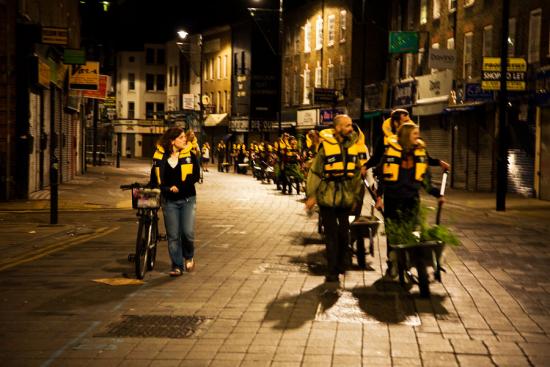
The ‘plan of action’ forms the basis of a new ideology, which acts as a counterpoint to neoliberalism – advocating our extrication from the system of capital that is the “ultimate cause” (Fisher 2009, p.70) of our environmental crisis. Heavy on words such as ‘abandon’, ‘reject’, ‘stand back’ and ‘disengage’ it calls us to make radical changes. It demands that we overcome our “path dependency” (Abbing 2002, p.96) by shifting our goals away from the fantasy status of the ‘successful’ artist. It all makes our new role seem far less glamorous than our dreams may have envisaged – insisting that we renounce our vanity, abandon our egos, move towards collectivism and anonymity; in short, commit “career suicide” (Sharp 2010, p.52).
But would it really be so beneficial to scrap everything and start again – to admit that our lives up until this point had been “lost causes” (Zizek 2009b)? The emphasis of this essay is on the possibility of reconciliation. Therefore, it aims to explore what positive characteristics of ‘the careerist mentality’ that has driven us to take this individualistic path, we might be able to “salvage” (Williams 2009) and, in doing so, reconfigure to become a positive force that can help us put the plan into action all the more effectively: to take the necessary risks and make a stand for the ‘right’ ethical choice.
Counter to Kant’s belief that the fields of ethical decision making (part of ‘practical reason’) and aesthetic decision making (part of ‘judgement’) be kept separate (Guyer 2004), it appears that the gravity of the situation we face means that these two spheres must begin to coincide. Indeed, in his final book Chaosmosis: An Ethico Aesthetic Paradigm, Felix Guattari argues for the culminating phase of art to be one in which it has an integral relationship with ethics (Guattari 2006). And so, the ethical implications of the ‘plan of action’ become difficult to ignore. Its focus on ‘tugging our attention away’ from our obsession with our own lives to reconnect with our “collective humanity” (Araeen 2009, p.679) is clearly a moral proposition, soliciting a shift from prudent self-interest towards more altruistic behaviour.
The conflict that emerges between the self-interest of ‘the careerist mentality’ and the apparently selfless altruism called for by several points of the ‘plan of action’ has long been the concern of moral philosophy. The recurring question being whether they can ever coexist or be reconciled. In her essay Altruism Versus Self-Interest: Sometimes a False Dichotomy, Neera Kapur Badhwar argues that in certain cases, where individuals display particular characteristics, reconciliation of these traditional polarities is possible (Badhwar 1993).
Badhwar’s essay is based on the analysis of extreme instances of altruism (in this case the behaviour of those who rescued / harboured Jews from the Nazis in the Second World War). What is interesting, and indeed relevant, is the way in which she demonstrates how these definitive acts of altruism are able to coexist with self-interested motivations. Her argument is based on an extension of the categories of self-interested motivation from “feeling virtuous, becoming famous, gaining wealth” (Badhwar 1993, p.101) – equate these to the artist’s extrinsic motivations “money, recognition, fame” (Abbing 2002, p.82) – to include “integrity and self-affirmation” (Badhwar 1993, p.101) – read the artist’s intrinsic motivations of “inner gratification or private satisfaction” (Abbing 2002, p.82). Even though she acknowledges that these altruistic acts were carried out with an “awareness of the risk, in the absence of expectations of material, social, or psychological rewards [and with] the spontaneity of their choice to help” (Badhwar 1993, p.96), she demonstrates that it was precisely because these individuals took the risk that they were able to satisfy the:
“fundamental human interest, the interest in shaping the world in light of one’s own values and affirming one’s identity.” (Badhwar 1993, p.107)
Furthermore, she unearths another peculiarity at the heart of the dichotomy of individualism / collectivism (Triandis 1995) which also becomes key to the possibility of reconciliation. The individuals that she studied were compelled to carry out these altruistic acts because they were able to perceive of themselves as part of the “collective humanity” (which Araeen demands we reconnect with) and so had a more developed capacity for empathy. But, moreover, that it was something inherent in their individualism that gave them the “confidence in the value of their mission, and their own capacities for carrying it out” (Badhwar 1993, p.100): to stand away from the crowd and to stand up for what they believed to be right.
Following Badhwar’s argument, it becomes possible to identify the first of the characteristics of ‘the careerist mentality’ we should aim to salvage. For it is our “flair, self-assurance, and… sense of audacity” (Abbing 2002, p.95) which we shall have to depend on in order to take the risk necessary to make a stand against the mainstream.
What might it look like if we took the risk? What might we end up with if we followed the points in the ‘plan of action’ to the word? It is possible that rather than resulting in a radical new type of art practice, what would actually take place is a shift away from art and into the field of activism.
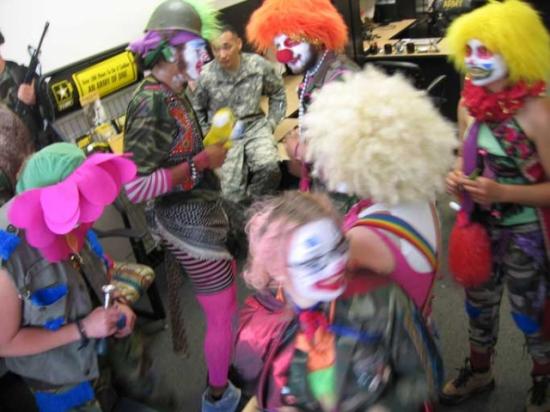
The Clandestine Insurgent Rebel Clown Army (CIRCA) was formed in 2003, to mark the official state visit of George W Bush to London at the onset of the Iraq war. It aimed to bring together “the ancient practice of clowning and the more recent practice of nonviolent direct action” (CIRCA 2003) – staging a series of strategic protests as part of an ongoing offensive against the evils of ‘war’ and ‘capitalism’. Before the protests at the G8 Summit at Gleneagles in 2005, the Rebel Clown Army embarked on a national recruitment tour of the United Kingdom. Anyone and everyone was invited to join, the only stipulation being that Basic Rebel Clown Training (BRCT) was first undertaken.
Much like the ‘plan of action’, the BRCT process focuses on the individual’s emancipation – on “transformation” and “personal liberation” from the dominant hegemony (CIRCA 2003). This internal reprogramming enables clownbatants, as they are known, to shut off their previous assumptions about hierarchical power structures and to step back and see the world with fresh eyes. From this new perspective the absurdity of a situation in which a line of protesters face-up against a line of police, becomes apparent. Beyond the signifiers of each others’ uniforms, Ranciere’s notion of the omnipresence of equality becomes evident (Ranciere 2007) and play and humour then perhaps do seem the natural human responses. Against the forward planning tactics of a traditional army (and indeed the career-minded artist) CIRCA’s emphasis is on spontaneity: “because the key to insurgency is brilliant improvisation, not perfect blueprints” (CIRCA 2003).
In a uniform which combines camo and greasepaint, clownbatants (as Point 5. suggests) ‘reject ego and embrace anonymity’ and so their inhibitions and embarrassment become irrelevant. So much more becomes possible without the worry of how they are perceived, of how others will judge them. Their individual subjectivities come together as a collective force of resistance. Their creativity exists in a space beyond the system of capital and they are utilising it to actively fight back.
The founders of the Rebel Clown Army were so aware of the importance of creativity in the process of resistance and of the potential for an evolution between art and activism, that they later set up the Laboratory of Insurrectionary Imagination (Lab of ii) as “a space to bring artists and activists together” (Harvie et al. 2005, p.249). The idea was to enable situations where they could work together and transfer skills – cultivating confidence in their “creative capacity as [a] fundamental tool for social change” (Lab of ii 2005). Functioning across the public realm, art world institutions and sites of traditional protest, the Lab of ii manages to successfully infiltrate and subvert different aspects of the hegemony. Most recently at Tate Modern in London, where under the banner of Disobedience Makes History – a two-day workshop on “art-activism” – they deliberately disobeyed the curator’s orders, encouraging participants to aim public attacks relating to the climate crises directly at the museum’s sponsors BP (Jordan 2010, p.35).
To read Part 4 of this article visit this link: http://www.furtherfield.org/articles/trajectories-how-reconcile-careerist-mentality-our-impending-doom-part-44
————
References:
Araeen, R., 2009. Ecoaesthetics: A Manifesto for the Twenty-First Century. Third Text, 23(5), 679-84.
Araeen, R. & Appignanesi, R., 2009. Art: A Vision of the Future. Third Text, 23(5), 499-502.
Badhwar, N.K., 1993. Altruism Versus Self-Interest: Sometimes a False Dichotomy. In Altruism. Cambridge: Cambridge University Press, pp. 90-117.
Bey, H., 1994. Immediatism, Oakland, California: AK Press.
Blackburn, S., 2009. Do we need a new morality for the 21st century? The Guardian Culture Podcast. Available at: www.guardian.co.uk/culture/audio/2009/nov/02/cambridge-festival-of-ideas.
CIRCA, 2003. About the Army. Clandestine Insurgent Rebel Clown Army website. Available at: www.clownarmy.org/about/about.html [Accessed April 25, 2010].
Curtis, A., 2002. The Century of the Self, BBC 4.
Crisp, Q., 1996. The Naked Civil Servant, London: Flamingo.
Fisher, M., 2006. Reflexive Impotence. k-punk blog. Available at: k-punk.abstractdynamics.org/archives/007656.html [Accessed April 25, 2010].
Fisher, M., 2009. Capitalist Realism: Is There No Alternative?, Ropley, Hampshire: 0 Books.
Guattari, F., 2006. Chaosmosis: An Ethico Aesthetic Paradigm. In Participation. London / Cambridge, Mass.: Whitechapel / MIT Press.
Guyer, P., 2004. Immanuel Kant. In E. Craig, ed. Routledge Encyclopedia of Philosophy. London: Routledge.
Hajek, A., 2008. Pascal’s Wager. The Stanford Encyclopedia of Philosophy. Available at: plato.stanford.edu/archives/fall2008/entries/pascal-wager [Accessed May 3, 2010].
Harvie, D. et al. eds., 2005. Shut Them Down!, Leeds / New York: Dissent! / Autonomedia.
Jordan, J., 2010. On refusing to pretend to do politics in a museum. Art Monthly, (334), 35.
Kingsnorth, P. & Hine, D., 2009. Uncivilisation: The Dark Mountain Manifesto. Available at: www.dark-mountain.net/about-2/the-manifesto.
Lab of ii, 2005. About Us. The Laboratory of Insurrectionary Imagination website. Available at: www.labofii.net/about [Accessed April 25, 2010].
Mouffe, C., 2007. Artistic Activism and Agonistic Spaces. Art & Research, 1(2). Available at: www.artandresearch.org.uk/v1n2/mouffe.html [Accessed April 25, 2010].
Ranciere, J., 2007. Hatred of Democracy, London: Verso.
Sharp, C., 2010. Career Suicide. Art Review, (40), 52-4.
The Invisible Committee, 2009. The Coming Insurrection, Los Angeles / Cambridge, Mass.: Semiotext(e).
Triandis, H., 1995. Individualism and Collectivism, Boulder, Colorado: Westview Press.
Vonnegut, K., 2003. Knowing What’s Nice. In These Times. Available at: www.inthesetimes.com/article/knowing_whats_nice [Accessed April 25, 2010].
Williams, E.C., 2009. Putting the punk back in salvage (where it was not to begin with). Socialism and/or Barbarism blog. Available at: socialismandorbarbarism.blogspot.com/2009/08/putting-punk-back-in-salvage-where-it.html [Accessed May 4, 2010].
Zizek, S., 2009a. First As Tragedy, Then As Farce, London: Verso.
Zizek, S., 2009b. In Defense of Lost Causes, London: Verso.
To read Part 1 of this article visit this link:
http://www.furtherfield.org/articles/trajectories-how-reconcile-careerist-mentality-our-impending-doom-part-14
To read Part 2 of this article visit this link: http://www.furtherfield.org/articles/trajectories-how-reconcile-careerist-mentality-our-impending-doom-part-24
To read Part 3 of this article visit this link: http://www.furtherfield.org/articles/trajectories-how-reconcile-careerist-mentality-our-impending-doom-part-34
Returning to Badhwar’s essay, it is important to note the impulsive and/or compulsive nature of the acts of altruism that she studied – “the spontaneity of their choice to help” (Badhwar 1993, p.96). She observes that:
“Those who acted spontaneously, then, acted with a sense that they had no alternative but to help, and that, under the circumstances, helping was nothing special… [Their actions were] a spontaneous manifestation of “deep-seated dispositions which form one’s central identity” or character.” (Badhwar 1993, p.97)
Of course, impulsion and / or compulsion are not the sorts of qualities which can be taught or learnt. As is suggested, you really have to believe in what you are doing in order to act instinctively – in a way which is not premeditated or over-deterministic. In this sense you cannot simply follow a ‘plan’ to be altruistic as this is in its essence self-defeating. It is, however, possible to develop one’s “character” or “identity”, so that we do begin to notice when things are wrong or unjust and we really do feel compelled to act to change them. This is done through periods of self-reflection but also, more importantly, by acquiring knowledge.
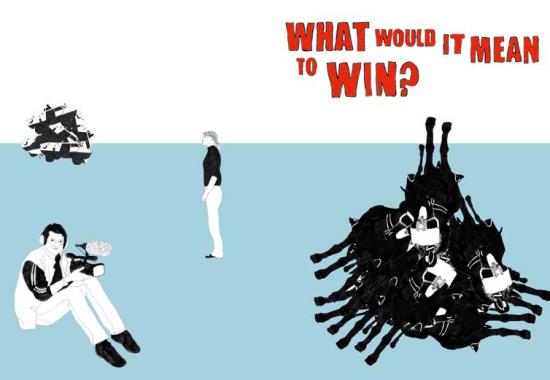
Oliver Ressler uses his research-based practice as a way of not only acquiring knowledge for himself, but of disseminating it to others – via video, installation and public realm contexts. His 2008 film What Would It Mean To Win? in collaboration with Zanny Begg focuses on the counter-globalisation protests at the G8 Summit in Heiligendamm in Germany in 2007. The documentary sections of which probe members of resistance movements to consider just what form society might take if they were to ‘win’ what they have been fighting for. His creation of a bank of knowledge about social alternatives is extended in Alternative Economics, Alternative Societies – a documentary, installation and billboard project which presents ideas and proposals for alternative economic and societal models, which all use the rejection of the system of capital as a starting point (Ressler 2007). The research from this project was published as a book in 2007.
Ressler’s book can be seen as a companion to that of art collective Superflex who in 2006 initiated and published Self-organisation / Counter-economic Strategies. As a “toolbox of ideas”, the book puts forward a series of proposals for self-organised models of social and economic systems that also aim to offer an alternative to capitalism (Bradley et al. 2006). Both books aim to spark debate about the negative effects of our current social order and (as Point 2. suggests) ‘to revivify the belief that ‘an alternative’ is possible’.
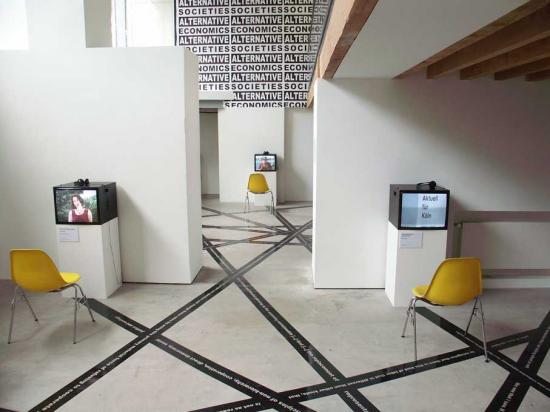
What is interesting is that the more we learn about the connections between capitalism and environmental catastrophe – the more self-reflection we undertake – the more ‘responsibility’ we inherit. In his famous essay exploring the moral differences between active and passive action Killing and Starving to Death, James Rachels illuminates this notion:
“There is a curious sense, then, in which moral reflection can transform decent people into indecent ones: for if a person thinks things through and realises that he is, morally speaking [in the wrong]… his continued indifference is more blameworthy than before.” (Rachels 2006, p.73)
And so the self-reflexive artist enters into a spiral. The more knowledge that they research and acquire – the more their conscience is likely to compel them to act. The question then becomes whether art is the most efficient way of effecting real change.
According to Artur Zmijewski, his recent work Democracies – a series of documentary clips depicting different protest movements from around the world – is not art. “Art”, according to Zmijewski, “is too weak to present political demand” (Prince 2009, p.6). Artists have in the past reached a similar conclusion – turning to existing political systems as a more direct means of effecting change. In 1980 Joseph Beuys was instrumental in setting up the Green Party in Germany, running as its candidate for the European Parliament, and, in 1988 Maria Thereza Alves co-founded the Green Party in Brazil. In a recent lecture Alves points out that it becomes the role of the artist to “judge in each situation whether art or politics provides a better solution” (Alves 2010).

As well as proposing theoretical solutions in book form, Superflex have also attempted to find practical solutions to real life problems in Africa. Although falling under the umbrella of their artistic practice, these projects seem more akin to the sort of thing you might expect to see being pioneered by a charity or a development agency. In 1996-7 they worked with engineers to develop the Supergas system, which is capable of turning compostable waste in the form of human / animal dung into “sufficient gas for the cooking and lighting needs of an African family”, thereby allowing them to “achieve self-sufficiency in energy” (Superflex 1997). The realisation of the Supergas system seems to epitomise the marriage between creative thinking and functionality which Araeen calls for by presenting the example of the desalination plant. What is interesting about this project, and indeed Beuys’ and Alves’ involvement in Green politics, is how it shifts our perception of the role of the artist when viewed as an important component part of a wider practice…
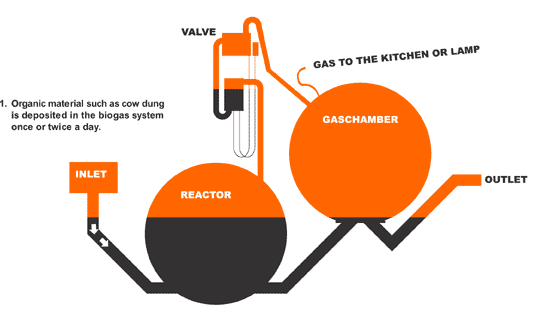
It has been suggested that the most successful campaigning bodies, such as Greenpeace, function “through multi-pronged channels of official, semi-official and illicit activity to negotiate specific ends” (Perry 2010, p.8). They operate under several different ‘hats’ – as a registered charity for raising funds (sometimes even stooping so low as to employ the cynical marketing strategies of the ‘charity-mugger’ on the street) and, at once, as a band of renegade activists aboard the Rainbow Warrior causing real disruption to cruel and exploitative practices and playing tactical media games. They demonstrate a “positive disengagement” (Fisher 2006) from the mainstream, coupled with a savvy co-option of the system, where it clearly presents itself as a more productive solution.
It is possible that the new model for a ‘reconciled artistic practice’ could take a similar form, where the artist (or preferably the collective of artists) balances a variety of activities across different fields. Described as “a group of freelance artist-designer-activists committed to social and economic change” (Myers 2007), Superflex do not ‘abandon’ the art world altogether and, in addition to the projects described above, they continue to work on commissions for its major institutions. For example, in 2009 they made a series of short films The Financial Crisis (Session I-V) for the art market’s number one annual trade fair – Frieze. Like the Lab of ii and following in a long lineage of institutional critique, Superflex appear to understand the benefits of being able to use the system by infiltrating it, criticising and beginning to change it from within.
In now seems evident that our success at adapting to this multi-pronged mode of operation, which straddles real political action, activism and art world insider jobs, depends on our flexibility in approaching different tasks – our ability to wear these different ‘hats’ with conviction and our adeptness at switching between roles. So here it becomes possible to identify the second of the characteristics of neoliberalism which we might aim to salvage. For it is “the very hallmarks of management in a post-Fordist, Control society” – our ‘flexibility’, ‘nomadism’ and ‘spontaneity'” (Fisher 2009, p.28) which we must now begin utilise, as well as our ability to cope with and adapt to change. Both very useful skills to have as the temperatures begin to rise and the food stocks begin to run low.

The final characteristic particular to the career-minded artist, which we must aim to reconfigure as central to our new roles in the twenty-first century, is our work-ethic, which results from our comparatively high levels of intrinsic motivation (Abbing 2002, p.82). The acceleration of work rates is something which has developed across the board under neoliberalism to the extent that we are now “bound” to our work in an “anxious embrace”…
“Managers, scientists, lobbyists, researchers, programmers, developers, consultants and engineers, literally never stop working. Even their sex lives serve to augment productivity.” (The Invisible Committee 2009, p.47)
However, it is the artist’s ability and willingness to work twenty-four-seven often in situations completely removed from wage-labour relations, that makes us ‘exceptional’ (Abbing 2002) and offers the potential, even, to act as a paradigm for a general approach to work in a world beyond capital. For it is this position of “radical autonomy” which presents the opportunity for “real education of our socialised senses and human potentials that releases development in all directions” (Ray 2009, p.546). We continue, over the course of our lives, to relentlessly acquire knowledge, self-reflect and develop, adapt, evolve and act – not for money, but because something inside us – something inherent in our ‘character’ – compels us to. If we could only succeed in “freeing” a small fraction of this exceptional motivation “from the self-destructive narcissist ego” (Araeen 2009, p.683) and releasing it in a more selfless and functional direction, it could still be a hugely positive force for change.
Following Aristotle’s classic assertion that moral excellence is found in a person’s rational capacity to choose the mean between extremes (Mautner 2005, p.43), the introduction to the Cambridge reader on Altruism, in which Badhwar’s essay is published, suggests that:
“The most challenging task of a moral theory is to strike a balance between the weight we give to our own interest and the weight we give to those of others. A theory that directs us to give too much to others is as deficient as one that directs us to give too little.” (Paul et al. 1993, p.ix)
And, so it seems that ‘a reconciled practice’ will also, to a certain extent, be about compromise. It will be about attempting to ‘strike a balance’ between the time we invest in each of the various facets of our activity – direct political action or more conventional art world activity – and about how we best use our judgement as to when to focus on one thing over another. If we can achieve this equilibrium in our ‘multi-pronged approach’ to practice, and indeed in our lives in general, then this is perhaps also where we will find our “private satisfaction” (Abbing 2002, p.82): our happiness.
In a recent interview Ranciere reminds us “that there are certain situations where only reality can be taken into account – there is no room for fiction” (Charlesworth 2010, p.75). What this suggests is that perhaps the balance between the ‘selfish’ and ‘selfless’ activity which artists undertake will only really begin to shift when we are directly confronted with the realities of climate change. As James Lovelock suggests it may well take until the point of real global disaster – such as an event on the scale of the Pine Island glacier breaking off into the ocean causing tsunamis and an immediate and permanent sea rise of two metres (Hickman 2010, p.12) – until we are, through absolute necessity, able to totally reconfigure our motivations. Perhaps only when we do come face-to-face with this “worst kind of encounter with reality” (Kingsnorth & Hine 2009, p.11) will we, as artists, be able to assume our fully functional role in society.
When Franny Armstrong, founder of the 10:10 Campaign, says “if you’re not fighting climate change or improving the world, then you’re wasting your life” (Armstrong 2009a, p.8), she is essentially reinforcing the ‘wager’ set out in our ‘plan of action’. However the future pans out, do you really want to look back on this pivotal moment in the history of our species and say ‘I did nothing’, ‘I did not make a stand’, or do you want to be able to say the opposite and to retain what should be our most commanding of all human motivations – our integrity.
——-
Abbing, H., 2002. Why Are Artists Poor?: The Exceptional Economy of the Arts, Amsterdam: Amsterdam University Press.
Alves, M.T., 2010. The Friday Event. The Glasgow School of Art. Available at: www.gsaevents.com/fridayevent/alves [Accessed April 25, 2010].
Araeen, R., 2009. Ecoaesthetics: A Manifesto for the Twenty-First Century. Third Text, 23(5), 679-84.
Araeen, R. & Appignanesi, R., 2009. Art: A Vision of the Future. Third Text, 23(5), 499-502.
Armstrong, F., 2009a. Franny Armstrong: If you’re not fighting climate change or improving the world, then you’re wasting your life. The Guardian, 8.
Armstrong, F., 2009b. What is 10:10? 10:10 Campaign website. Available at: www.1010uk.org/1010/what_is_1010/arms [Accessed April 10, 2010].
AVOID, 2010. Will the Copenhagen Accord avoid more than 2C of global warming? AVOID website. Available at: ensembles-eu.metoffice.com/avoid [Accessed May 3, 2010].
Badhwar, N.K., 1993. Altruism Versus Self-Interest: Sometimes a False Dichotomy. In Altruism. Cambridge: Cambridge University Press, pp. 90-117.
Bey, H., 1994. Immediatism, Oakland, California: AK Press.
Blackburn, S., 2009. Do we need a new morality for the 21st century? The Guardian Culture Podcast. Available at: www.guardian.co.uk/culture/audio/2009/nov/02/cambridge-festival-of-ideas.
Bradley, W. et al. eds., 2006. Self-organisation / Counter-economic Strategies, New York: Sternberg Press.
Brown, W., 2009. What will be the legacy of recession? The Guardian Culture Podcast. Available at: www.guardian.co.uk/culture/audio/2009/oct/26/culture-cambridge-festival-ideas.
Cameron, D., 2009. The Age of Austerity. The Conservative Party website. Available at: www.conservatives.com/News/Speeches/2009/04/The_age_of_austerity_speech_to_the_
2009_Spring_Forum.aspx [Accessed April 25, 2010].
Charlesworth, J.J., 2010. Jacques Rancière Interview. Art Review, (40), 72-5.
CIRCA, 2003. About the Army. Clandestine Insurgent Rebel Clown Army website. Available at: www.clownarmy.org/about/about.html [Accessed April 25, 2010].
Crisp, Q., 1996. The Naked Civil Servant, London: Flamingo.
Curtis, A., 2002. The Century of the Self, BBC 4.
Deleuze, G., 1990. Society of Control. L’Autre Journal, (1). Available at: www.nadir.org/nadir/archiv/netzkritik/societyofcontrol.html.
Fisher, M., 2009. Capitalist Realism: Is There No Alternative?, Ropley, Hampshire: 0 Books.
Fisher, M., 2006. Reflexive Impotence. k-punk blog. Available at: k-punk.abstractdynamics.org/archives/007656.html [Accessed April 25, 2010].
Fowkes, M. & Fowkes, R., 2009. Planetary Forecast: The Roots of Sustainability in the Radical Art of the 1970s. Third Text, 23(5), 669-674.
Guattari, F., 2006. Chaosmosis: An Ethico Aesthetic Paradigm. In Participation. London / Cambridge, Mass.: Whitechapel / MIT Press.
Guyer, P., 2004. Immanuel Kant. In E. Craig, ed. Routledge Encyclopedia of Philosophy. London: Routledge.
Hajek, A., 2008. Pascal’s Wager. The Stanford Encyclopedia of Philosophy. Available at: plato.stanford.edu/archives/fall2008/entries/pascal-wager [Accessed May 3, 2010].
Harvey, D., 2007. A Brief History of Neoliberalism, Oxford: Oxford University Press.
Harvie, D. et al. eds., 2005. Shut Them Down!, Leeds / New York: Dissent! / Autonomedia.
Hickman, L., 2010. James Lovelock: Fudging data is a sin against science. The Guardian, 10-12.
Hillcoat, J., 2009. The Road, Dimension Films.
IPCC, 2001. Special Report on Emissions Scenarios. GRID-Arendal website. Available at: www.grida.no/publications/other/ipcc%5Fsr/?src=/climate/ipcc/emission [Accessed May 3, 2010].
Jordan, J., 2010. On refusing to pretend to do politics in a museum. Art Monthly, (334), 35.
Kerr, A., 2010. Goldsmiths: But is it Art?, BBC 4.
Kingsnorth, P. & Hine, D., 2009. Uncivilisation: The Dark Mountain Manifesto. Available at: www.dark-mountain.net/about-2/the-manifesto.
Lab of ii, 2005. About Us. The Laboratory of Insurrectionary Imagination website. Available at: www.labofii.net/about [Accessed April 25, 2010].
Mamudi, S., 2008. Lehman folds with record $613 billion debt. MarketWatch website. Available at: www.marketwatch.com/story/lehman-folds-with-record-613-billion-debt?siteid=rss [Accessed April 25, 2010].
Mautner, T., 2005. Aristotle. In The Penguin Dictionary of Philosophy. London / New York: Penguin, pp. 40-4.
Mouffe, C., 2007. Artistic Activism and Agonistic Spaces. Art & Research, 1(2). Available at: www.artandresearch.org.uk/v1n2/mouffe.html [Accessed April 25, 2010].
Myers, J., 2007. Superflex. Frieze Magazine, (106). Available at: www.frieze.com/issue/review/superflex [Accessed May 9, 2010].
Paul, E.F., Miller, F.D. & Paul, J. eds., 1993. Altruism, Cambridge: Cambridge University Press.
Perry, C., 2010. Art v the Law. Art Monthly, (333), 5-8.
Priddle, A., 2009. School of Saatchi, BBC 2.
Prince, M., 2009. Art & Politics. Art Monthly, (330), 5-8.
Prince, M., 2010. Remakes. Art Monthly, (335), 9-12.
Rachels, J., 2006. Killing and Starving to Death. In The Legacy of Socrates: Essays in Moral Philosophy. New York: Columbia University Press, pp. 60-82.
Ranciere, J., 2007. Hatred of Democracy, London: Verso.
Ray, G., 2009. Antinomies of Autonomism: On Art, Instrumentality and Radical Struggle. Third Text, 23(5), 537-46.
Ressler, O., 2007. Alternative Economics, Alternative Societies. Oliver Ressler website. Available at: www.ressler.at/alternative_economics [Accessed April 25, 2010].
Sharp, C., 2010. Career Suicide. Art Review, (40), 52-4.
Strawson, P.F., 2008. Social Morality and Individual Ideal. In Freedom and Resentment and Other Essays. London / New York: Routledge, pp. 29-49.
Superflex, 1997. Supergas. Superflex website. Available at: superflex.net/tools/supergas [Accessed May 5, 2010].
Thatcher, J., 2009. Crunch Time. Art Monthly, (332), 5-8.
Thatcher, M., Margaret Thatcher Quotes. About.com website. Available at: womenshistory.about.com/od/quotes/a/m_thatcher.htm [Accessed May 2, 2010].
The Invisible Committee, 2009. The Coming Insurrection, Los Angeles / Cambridge, Mass.: Semiotext(e).
Triandis, H., 1995. Individualism and Collectivism, Boulder, Colorado: Westview Press.
Vonnegut, K., 2003. Knowing What’s Nice. In These Times. Available at: www.inthesetimes.com/article/knowing_whats_nice [Accessed April 25, 2010].
Walker, J., 2002. Left Shift: Radical Art in 1970s Britain, London / New York: I.B. Tauris.
Williams, E.C., 2009. Putting the punk back in salvage (where it was not to begin with). Socialism and/or Barbarism blog. Available at: socialismandorbarbarism.blogspot.com/2009/08/putting-punk-back-in-salvage-where-it.html [Accessed May 4, 2010].
Zizek, S., 2009a. First As Tragedy, Then As Farce, London: Verso.
Zizek, S., 2009b. In Defense of Lost Causes, London: Verso.
Patrick Lichty, renowned conceptually-based artist, writer, curator and activist. He has exhibited internationally since 1990. Featured image: taken by Anne Helmond.
Introduction.
Patrick Lichty is an individual who seems to be like a non-stop engine. A hungry human being, engulfed in a prolific journey of constant exploration, whether it be making artworks, writing, activism, curating, collaborating, researching or teaching; he’s deeply involved and engaged in media arts culture. Since 1990, he has pursued art and writing that explores how we relate to one another through technology and how we relate to it. This includes art, media, and computer technology. “Media are one of the “glues” of civilization, and this glue is as fundamental in representing all aspects of society, culture, and interpersonal relations. I explore this through critical theory, conceptual New Media art, and performance/social intervention.”
Lichty also works in almost all forms of Digital 3D – Animation, VR, Fabrication, Physical Computing. Translating the work for display through video, animation, live installation, electronics, virtual reality, physical computing, robotics, digital fabrication and imaging. As well as realising virtual works into traditional forms such as plates for print, paintings, expanding the focus of his work in a broader context.
Lichty’s work, concepts and practice do not rest in one place, it crosses over into many areas of creative production. By getting his hands dirty with the medium of technology, with its relational aspects. The spirit of the work goes beyond singular catch phrases and one-liners, adding complexity and value which only media art and its ever widening scope can demonstrate.
It’s big art with big ideas, interwoven with micro levels of human emotion, asking questions about life and more. This two part interview aims to clarify some questions I have been wanting to ask Patrick Lichty for a while now, so hang on and lets see what happens…
Start of Interview:
Marc Garrett: You have been deeply engaged in the creation of net art, networked art, media art and related activities at various levels, whether it has involved you making it, writing about or curating it. What inspired you to choose which is, now unquestionably, one of the most contemporary and expansive forms of creativity, in the first place?
Patrick Lichty: This is a question that has come up repeatedly. “Why did you choose (what is now called) New Media, or the intersection between society, technology, and culture?” It is really a matter of examining my native culture, which has been that of technological culture. I was raised by an artist who gave me my first electronics set at the age of 8, and my first computer by the age of 17, while raising me on a steady diet of science fiction. I was a child of McLuhan; growing up in the electric networks on a diet of very hot media. However, I do also paint, and when I think it’s appropriate, I also do use traditional media. In short, I speak this culture because it’s my native language.
MG: To kick off this interview I thought it would serve our readers well to discuss your work from a perspective of themes. Over the years, exploration through your practice has crossed over into many different disciplines and fields. So lets begin with Psychogeography. To those who are unfamiliar with this practice, the most well defined and serious use of it was in 1955 by Guy Debord: “a whole toy box full of playful, inventive strategies for exploring cities … just about anything that takes pedestrians off their predictable paths and jolts them into a new awareness of the urban landscape.”
“Of all the affairs we participate in, with or without interest, the groping quest for a new way of life is the only thing that remains really exciting. Aesthetic and other disciplines have proved glaringly inadequate in this regard and merit the greatest indifference. We should therefore delineate some provisional terrains of observation, including the observation of certain processes of chance and predictability in the streets.” Introduction to a Critique of Urban Geography. Guy Debord
Patrick, one of your projects which springs to mind, is a work called SPRAWL “…an exploration of the suburban American landscape, examining the macrocosmic issues related to suburban expansion by considering the microcosmic issues of the experiences of a bellwether area of the US: Stark County, Ohio. In navigating the landscape you will view over thirty panoramic photographs of sites that are now forever changed by the area’s development as well as interviews on video and historical documents which create a map of the larger social landscape of the surrounding community.”
A complex and involved project. What inspired you to examine the ‘suburban American landscape’ in such a way, and how long did it take to complete?
PL: In talking about Debord’s definition, I’d like to talk about my own interpretation of the idea of Psychogeography. If you consider the word etymologically in contrast with Debord’s meaning, you can say that it should not be limited to the urban landscape, but the relationship of human interaction with any landscape. From this, we move out of the city to any relation between community and space, which is my interest, and I like to term as a practice of ‘land use interpretation’ to borrow Matt Coolidge’s (CLUI) term. All of my work in this range, from SPRAWL to the three projects in varying stages of completion (the Hulett Project, Ghosts of Adak, and SPRAWL 2011) come from a personal observation that expands to a macroscopic discourse through the larger exploration/research of the space.
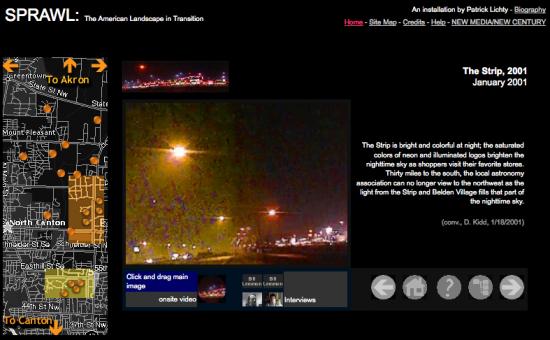
SPRAWL began as a 3-year personal investigation of my own distress about suburban sprawl in the late 1990’s near my home town, and linking this to the larger national conversation regarding sprawl at the time. For reference, I was born in nearby Akron, Ohio – the subject of Chrissie Hynde and The Pretenders song My City Was Gone, which describes the colonization of an industrial city and its countryside by sprawl and shopping malls, so if SPRAWL has a soundtrack, that would be it. I began SPRAWL in 1998, as a series of panoramic photographs of various sites near my home, with just a vague impression that they were a cohesive body of work. Also, the idea of nostalgia for the pastoral farmland of my younger days seemed far too simple to be satisfying, so I knew there was something to it. So, when the Smithsonian American Art Museum put out a call for works dealing with landscape online, I felt this was a fantastic place to really explore this idea in a larger context. Then they offered me the commission, the project went from a set of 32 panoramas to a hyperdocumentary in about three solid months of production, including travelling back to Ohio from Louisiana, interviewing, doing on-site footage, and performing historical research.
What I think is important about SPRAWL is that it’s ‘sensable research’, in that it managed to manifest the ideas I had about this problem, learning a lot more about community ecology, allowing the articulation of a microcosmic issue in macroscopic terms. In more personal terms, it allowed the development of my question of social issues related to my concern with the understanding that my perspective was only one of many, and from examining a multitude of perspectives, I could learn what the larger issues were, and create a discourse with a larger community.
MG: On your website, for the Ghosts of Adak there is a statement of yours, saying “My father and I have something in common. He was born in 1921 and spent 2-1/2 years in the North Pacific campaign on Adak Island in the Western Aleutian Islands in Alaska. I have heard about it since 1962. So I went there for 10 days. And I found him all over again.”
I also visited another site to find out about the community living there, and on this site called Alaska Tracks. Ned Rozell writes “Adak’s having a tough time, and the community of about 200 people in the mid-Aleutians has been struggling since the Navy pulled about 6,000 people out in 1997. It’s got a feel to it now like the Love Canal area of Niagra Falls had in the 1980’s, like everyone took off and left a few ghosts behind.”
How was your 10 days stay there and what did you learn?
Do you have a clear idea of what this project will become? Also, I noticed that it is part of an artist residency program at Eyebeam R&D Atelier NYC. How do you intend to present this work, in a space, on-line or something else?
PL: That’s a book in itself, and probably will be, which is part of your next question. First, why – My father is nearing 90, and for most of my life, he had gone on about this “place” that he had been for a period of time, and recounting endless stories about it. No place else had that sort of impact on him. Does not talk about Seattle, or San Francisco, or even Chicago (all places he had spent time) like that. I also think that as he is nearing 90, and in that he and I have a very strong bond (actually both Lodge brothers, if you can believe that), and I wanted to know about him in the deepest way possible, and probably in so doing, learn about myself and the site. But then, that fits the process.
The issue with Adak is that it is a tremendously complex place even before I overlay my own emotional architectonic. It was the site of the Northern Pacific campaign of the United States versus Japan during the Second World War, mainly as a diversion from Midway. I had made a deal with the CEO of the facility to exchange the photos for a room, a 40-something Niigata-born guy with petrochemical ties, whose father might have been my father’s enemy, and ideologically, probably was mine, but the personal nature of the trip put that on hold. There were a lot of external and internal conflicts that I had to navigate just to get there.
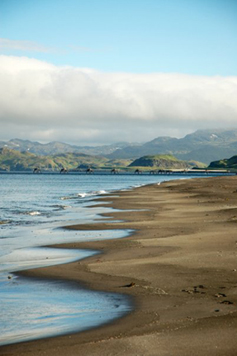
In short, Adak is currently the remains of the Adak Naval Base and surrounding facilities, which is basically a minor port, petrochemical storage facility, a fishery, and home of the westernmost airport linked to the Continental US, further west than Hawaii. If you rent a car, you rent one of the trucks a local offers, the gas comes from the tank farm, and the ‘hotel’ is a number of duplexes that the residents rent out to visitors. There is a General Store, a cafe at lunchtime, and the old VFW becomes the tavern for dinner, offering an entree or some microwaveable snacks along with a full bar. You sign a disclaimer to absolve the Corporation of any liability if you encounter black mold, fall into an old stairwell, sinkhole, run into an old unexploded shell, etc. I’m speaking a little darkly about this place, but it’s pretty rugged with radically changing weather, frequent earthquakes, and they’re still cleaning up the old artillery ranges.
On the other hand, it’s one of the most amazing places to be. It’s right at the edge of civilization, a volcanic arctic island withn no trees and some of the most amazing wildlife you’ve ever seen – eagles, otters, seals, birds. I can see why my father talked about it so much.
One other thing of note is that while doing the project, I’ve run into all sorts of people who have served, lived, or even been born there, as there was a 6,000-person family facility. On the plane from Minneapolis to Anchorage, I ran into an airline pilot who had just been on a caribou hunt there, and he gave me his GPS information and a lot of pictures. On another trip, I ran into a woman who was born there. It was unbelievable.
What did I learn? I learned about a history that few remember, I learned about my own history and how it affects me. I also learned about the local culture, its history, how Alaskan culture meshes with corporate interests to create a lot of the issues seen in mass media. There isn’t a lot of concern for the area from the locals, and actually the Military was doing a decent job with the cleanup. From a more personal level, I also came to understand that everything is transitory. Art, culture, society, all ephemeral in terms of a mountain. Human beings don’t matter very much to a volcano, but definitely the other way around.
When I was walking on the western (uninhabited) side of the island, I had napped on some tundra and realized I didn’t have my GPS or keys – all my keys. I knew where I slept, and I leave my keys in the car a lot. The worst that could happen was that I would have to walk 5 miles into town in a cold drizzle, get Jimbo the Constable to let me into my car and get the truck in the morning. In the end, I learned that if it isn’t a landmine, it’s not that big of a deal.
“Do you have a clear idea of what this project will become? Also, I noticed that it is part of an artist residency program at Eyebeam R&D Atelier NYC. How do you intend to present this work, in a space, on-line or something else?” This is really tough for me – no, I don’t have a clear idea yet because it’s so hard to frame. It probably needs to be a book, but it isn’t going to be done for a couple more years. I’d like it to be a hyperdocumentary like SPRAWL, but not in the same way. Also, I think it would make a great presentation, and the images are really beautiful. As I mention, it’s terribly hard to frame this project, and I think it should be allowed to be large.
MG: Let’s talk about a piece you created with The Yes Men. As many in the know, know – and of course those who have fallen foul to the Yes Men’s activist-pranks; they are legendary cultural saboteurs. They have impersonated World Trade Organization corporate spokespersons, including Dow Chemical Corporation, Bush administration spokesmen on TV, at various business conferences around the world. In order to demonstrate some of the mechanisms that keep bad people and ideas in power. Focusing attention on the dangers of economic policies that place the rights of capital before the needs of people and the environment. They have more recently become more known to a world-wide audience for The Yes Men, a movie.
Could you inform myself, and readers about the mock industrial video ReBurger and how it came about?
PL: Right. The animation work for The Yes Men is a strange beast, because it came from previous work for a group called RTMark, from which some of us came from to do Yes Men, which is well documented in the two movies. Again, the process for these animations, which I later edit into industrial videos is also an odd one. Usually, when there is an intervention (and I have sometimes appeared in person), Mike will give me a call and say something like, “Hey Patrick, we have this idea for this, for that company…” In this case, it was an idea for recycling feces for the Third World, and not much beyond that general concept. At first, I was thinking of translating dietary fiber to textile manufacture, creating a suit that would look like S**t, but shortly thereafter, brainstorming created the McDonald’s parody. I knew it was going to be shown at Plattburgh College, but beyond that, I didn’t have much context. So, that’s where my process in context with the larger presentation sort of diverges. Mike, Andy and Matt were developing the presentation, and I started in on the simple metaphor of eating shit. In short, I get some basic ideas together, and then produce the clips (not the full industrial video).
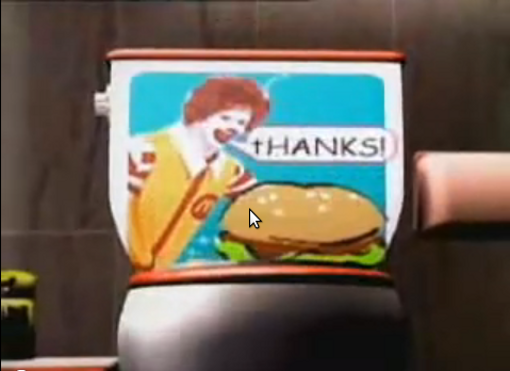
Beyond that basic joke, it’s really just exaggeration – the idea of an international infrastrucure for the collection of post-consumer waste, the branded toilet, and the special product names, like “McDung”. The scene that seems to get people is the one of the Ronald McDonald Colostomy Machine (the paste dispenser) as it creates the brown coil of reprocessed waste and then presses it into nice patties. For me, this is the use of pure literal metaphor, and maybe that’s why it works. Maybe it’s because it stands for a corporation that offers “choices” for healthy eating that few choose, and McDonalds willingly contributes to the obesity and illness of billions. In my opinion, ReBurger just tells the truth.
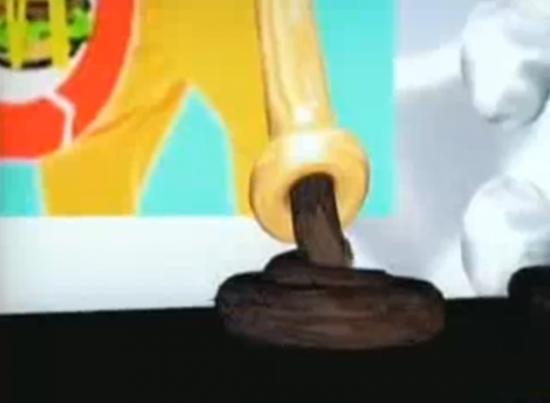
But the reason why people like the video is also a reason why it was a real problem for the sale of the movie at Sundance 2003. Although it was obvious fair use, many in the film industry were also buyers looking at the movie. Mike Bomnano told me that the legal departments of the movie companies were trying to determine the degree of risk of satiring McDonald’s, complete with branding. This was obviously Fair Use under US Copyright, but again, the possibility of an egregious law suit could have happened. In the end, McDonalds decided to ignore the piece, which was great, since I believe it’s one of the stronger Yes Men pieces.
MG: In the UK, June 1997, the infamous McLibel Trial (mcspotlight.org) came to an end. The case was between McDonald’s and a former postman and a gardener from London, Helen Steel and Dave Morris. It ran for two and a half years and became the longest ever English trial. “…Helen and Dave decided that they would stand up to the burger giants in court. They knew each other well from their involvement in community based campaigns in their local North London neighbourhood and felt that although the odds were stacked against them, people would rally round to ensure that McDonald’s wouldn’t succeed in silencing their critics.” The defendants were denied legal aid and their right to a jury, so the whole trial was heard by a single Judge, Mr Justice Bell.
“The verdict was devastating for McDonald’s. The judge ruled that they ‘exploit children’ with their advertising, produce ‘misleading’ advertising, are ‘culpably responsible’ for cruelty to animals, are ‘antipathetic’ to unionisation and pay their workers low wages. But Helen and Dave failed to prove all the points and so the Judge ruled that they HAD libelled McDonald’s and should pay 60,000 pounds damages. They refused and McDonald’s knew better than to pursue it.” Mcspotlight.
I can imagine that McDonald’s were considering their past experience, with cases such as the McLibel Trial. “The legal controversy continued. The McLibel 2 took the British Government to the European Court of Human Rights to defend the public’s right to criticise multinationals, claiming UK libel laws are oppressive and unfair that they were denied a fair trial. The court ruled in favour of Helen and Dave: the case had breached their rights to freedom of expression and a fair trial.”
For your project 8 Bits or Less, in 2002, you wrote a brief statement which I am assuming must be about your own condition, saying “An artist who has become blind (whether physically or ideologically) has resorted to viewing his world through the prosthetic devices that constitute his sense, like cell phones, and wristcams. The result is a distorted landscape that considers Situationist theory, surveillance culture, identity, and alien abduction.” Can I begin by asking why this statement came about and then what part of the project you feel communicates or is expressesed most successfully?
PL: First on the matter of ReBurger, I think that the smarter entities know not to react, but that isn’t always the case. Perhaps the ones who have been burned, now have a smarter PR team.

8 Bits or Less is a series I did that was influenced by several things. For many years, I had felt that as technological artists we are slaves to “innovation”, which is merely an exciting word to stand in for the commercial upgrade path in software and hardware. This set of videos addresses my dissatisfaction with the notion of verisimilitude in regard to techological art, or the “big ticket” piece. Ever since the late 1990’s my response has been to either get by with just enough aesthetic polish to make the work believable/legible, or to willingly embrace a low rez/grayscale time. The lo-fi grayscale is not the same as 8-Bit, which has 256 colors and refers to early personal computing and video games. Perhaps it is closer to my passion for Slow Scan television (a 1970’s video modem technology in which a frame is transmited every 7 seconds) or my position of eschewing resolution and color depth as a form of intransigent aesthetics. In addition, the fact that the frame rate is at most 3 frames per second, and was shot with a Casio Wristcam at one frame every 1.5 seconds was also my homage to Muybridge, mainly in terms of the grayscale and serial qualities of the video. Beyond that, and the fact that each video consists of about 900 frames, all hand edited, perhaps 8 Bits or less is more about my politics about the technological industry and personal differences with New Media and technolust.
On the personal side, 8 Bits or Less is an allusive fable having to do with the fact that I have been blind a couple times in my life, but this blindness can translate to the fact that for a period of time I felt that I had immersed myself in my studio for long enough, that I saw the world primarily from my screen. Therefore, although I had been visually imparied for part of my life, much of which has been fixed by having cataract removal in 1999, I still felt that there was a metaphorical blindness caused by society’s use of mobile devices, the existential distorions of 24-hour cable networks and the Internet. Therefore, the series (if you listen very closely) incorporates a mix of postmodern theory and hyperbolic statements about aliens, obscure jokes about bits and nybbles, surveillance culture and the abjection of low fidelity.
What I think is successful about it is that it holds together at all, or that it engages the viewer without necessarily relying on leading edge technological conceits, but perhaps using the wristcam aethetic is a conceit in itself. Antoher aspect that I have enjoyed about it after five or six years is that it is a really hallucinogenic series of pieces. But then, I think this is the point that Gibson made about cyberspace that has been expanded on by the Baudrillardian mediascape and the Internet – the consensual mass hallucination (facilitated by mass communications).
———
Watch 8 Bits or Less series. Images link to videos online.
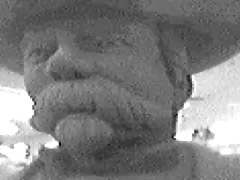
A wristful of bits. Found on DVlog.
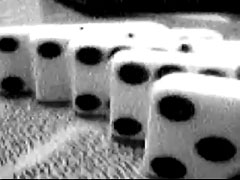
8 bits or less. Found on DVlog.
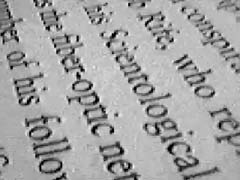
http://www.dvblog.org/movies/04_2007/lichty8bit/closevision.mov
Close vision. Found on DVlog.
Big thanks to DVblog for 8 Bits or Less images & video links.
http://dvblog.org/